Blossom at Bartram!
Bartram Village is a special place to live at every age—with beautiful spaces that bring people together, creating a sense of community, strength, and inspiration.


Bartram Village is a special place to live at every age—with beautiful spaces that bring people together, creating a sense of community, strength, and inspiration.



On behalf of the Philadelphia Housing Authority and the City of Philadelphia, we proudly present the Blossom at Bartram Plan. The Plan represents the culmination of 24 months of intensive engagement and collaborative work, and a synthesis of the ideas and aspirations of neighborhood residents, local organizations, development partners and other stakeholders.
Collectively, residents and stakeholders envision a new and better future for Southwest Philadelphia. The Plan organizes this vision into an attainable roadmap, with a series of goals and strategies built on the themes of Connect, Live and Thrive.
Connect— Create an inviting community that is clean, green and safe with beautiful, active public spaces. Connect people to these places; to nature and recreation; and to each other.
Live— Create an environment that fosters the health and wellness of all residents of all ages, through healthy, sustainable and affordable housing, access to medical services and nutritious food, and to spaces that heal the mind and body.
Thrive— Foster access for people of all ages to education, skills, jobs, services, inspiration and encouragement so that they can thrive. Enable the neighborhood to blossom by celebrating its history and strengthening its commercial corridors and identity.
This Plan is entirely consistent with the City’s housing plan and will play a key role in advancing its agenda. The Housing Action Plan places a high priority on preserving and protecting long-term housing affordability through revitalization of developments like Bartram Village, which is one of the oldest and most challenged public housing complexes in Philadelphia.


We believe the Blossom at Bartram Plan illustrates and brings to life the true potential of Bartram Village and the entire Southwest Philadelphia neighborhood, while showcasing the power of community to shape and direct the future for long-time and new residents.
We would be remiss if we did not thank everyone that invested their time and energy to create this exciting and visionary roadmap, as well as our partners at the U.S. Department of Housing and Urban Development who provided funding to support these planning efforts through the Choice Neighborhoods grant program. We extend a special thank you to residents of Bartram Village, who have displayed a true spirit of collaboration and inclusion throughout the process working with all partners and the community at large.
We are extremely excited to support the evolution of Southwest Philadelphia as a vibrant neighborhood of choice where all Philadelphians can connect, live and thrive together.
Sincerely.
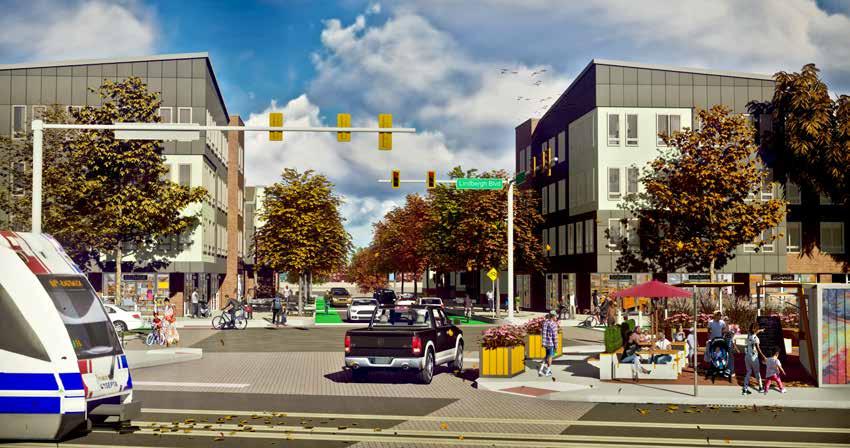
U.S. Department of Housing & Urban Development (HUD)
Bartram Village Resident Council
City of Philadelphia Pennrose Development
Philadelphia Housing Authority (PHA) PIDC
WRT, LLC
Adriane Parks
African Cultural Alliance of North America (ACANA) Bartram’s Garden Catholic Social Services
Children’s Hospital of Philadelphia (CHOP)
City of Philadelphia Streets Department
City of Philadelphia Department of Commerce
City of Philadelphia Department of Planning and Development
City of Philadelphia Department of Housing and Community Development
City of Philadelphia Mayor’s Office of Community Empowerment & Opportunity
City of Philadelphia Mayor’s Office of Education PHLPreK
City of Philadelphia Office of Managing DirectorREBUILD
City of Philadelphia Office of the Mayor
City of Philadelphia Office of Transportation and Infrastructure Systems
City of Philadelphia Parks and Recreation
City of Philadelphia Planning Commission
City of Philadelphia Police Department - 12th District and 18th District
City of Philadelphia Water Department City Lights Network
The Common Place
Community Forgiveness and Restoration Initiative
Councilmember Jannie L. Blackwell
Councilmember Kenyatta Johnson Councilmember Jamie Gauthier
Drexel University Lindy Center for Civic Engagement
Empowered CDC
Ezekiel Baptist Church Grace Christian Fellowship Family Practice & Counseling Network Jobcorps
John Bartram High School
Kingsessing Rec Center & Library
Mural Arts Philadelphia Myers Rec Center
Paschalville Library
Philadelphia Housing Authority Resident Advisory Board
Philadelphia Promise Zone/Promise Neighborhood Community Advisory Council
Pennsylvania Horticultural Society Philadelphia Works
Representative Joanna E. McClinton Rhythm & Brunch School District of Philadelphia Schuylkill River Development Corporation SEPTA
Southwest CDC Southwest District Services Southwest Nu-Stop State Senator Anthony H. Williams Tilden Middle School
University of Pennsylvania Office of Government and Community Affairs University of Pennsylvania PennPraxis University of the Sciences the Village | Hope in Action for Children and Families
Sheila Anthony
Luciana Boone
Tracey Gordon
Tonya Robinson
Dionna Roundtree
Doreen Waller
Kimberly Waller
Action Activities – This refers to a portion of a CN Planning and Action Grant that provides funds for limited physical neighborhood improvements immediately following the two-year planning process. Intended to jumpstart transformation, Action Activities respond to the neighborhood’s needs and be approved by HUD.
Affordable Housing – Housing is considered affordable if a family pays no more than 30% of its household income on housing-related costs.
Anchor Institutions – Anchor institutions are businesses and organizations firmly established within a neighborhood. They have regional significance and serve as economic and cultural drivers, generating jobs, creating local business opportunities, and contributing in significant ways to the development of human, social and cultural capital.
Area Median Income (AMI) - Area Median Income is the midpoint of a region’s income distribution — half of families earn more than the median and half earn less than the median. In Philadelphia, the Area Median Income for a family of 4 in 2019 was $72,100.
CDBG – HUD’s flexible Community Development Block Grant program provides communities with resources to address a wide range of unique community development needs.
City – City of Philadelphia.
Critical Community Improvements (CCI) – CCIs are community and economic development activities designed to enhance neighborhood outcomes proposed in a CN Transformation Plan.
CN – Choice Neighborhoods. Sponsored by HUD, Choice Neighborhoods Planning Grants support the development
of comprehensive neighborhood revitalization plans that focus on three core goals: Housing, People, and Neighborhoods. To achieve these goals, communities must develop a comprehensive neighborhood revitalization strategy or “Transformation Plan.”
CNI – Choice Neighborhoods Initiative.
DHCD - The City of Philadelphia’s Division of Housing and Community Development
Early Action Activities – Up to $50,000 of CN Planning Grant funds can be used for limited physical neighborhood improvements during the two-year planning process.
Evidence-based Practice – This term refers to the use of the best available conclusions/findings from research and studies as a basis for determining the best practices and predictions of outcomes in a field.
Extremely Low Income – Households with an income under 30% of AMI.
FEMA 100-Year Floodplain – This refres to an area that has a 1-percent chance of flooding in any given year as identified by the Federal Emergency Management Agency (FEMA).
FQHC – Federally Qualified Health Centers are community-based health care providers that receive funds from the HRSA Health Center Program to provide primary care services in underserved areas. They must meet a stringent set of requirements, including providing care on a sliding fee scale based on ability to pay.
FMR – Fair Market Rent is the rent amount, including utilities (except telephone), to rent privately owned, decent, safe and sanitary rental housing of a modest (non-luxury) nature.
HCV – Housing Choice Voucher is commonly known as a Section 8 voucher. With a HCV, the participant is free to choose any housing that meets the requirements of the program and is not limited to units located in subsidized housing projects.
Low Income – Households with income between 30% and 60% of AMI.
HUD – US Department of Housing and Urban Development.
LEED – Leadership in Energy and Environmental Design (a green building and neighborhood certification program).
LIHTC – The Low Income Housing Tax Credit provides a tax incentive to construct or rehabilitate affordable rental housing for low-income families. LIHTC subsidizes the acquisition, construction, and rehabilitation of affordable rental housing for low- and moderate-income tenants.
9% Credits – The 9% credit is a competitive tax credit allocation for the construction of affordable rental housing. It typically covers most of the cost of new construction. Tax credit units have set rents and prospective tenants must meet income limit requirements.
4% Credits – The 4% tax credit is not competitive, and does not cover the total cost of new construction. As a result it is typically claimed for rehabilitated affordable housing and new construction affordable units that are financed with tax-exempt bonds or other subsidies.
Market Rate Housing – Housing units unrestricted by income.
Non-Replacement Housing – New housing proposed by the Bartram Choice Plan that is not intended to replace Bartram Village units.
Part I Violent Crimes – Aggravated assault, rape, murder, and robbery are classified as Part I Violent Crimes.
PHA – Philadelphia Housing Authority.
PHFA – Pennsylvania Housing Finance Agency.
PIDC – Philadelphia Industrial Development Corp.
Public Housing – Public housing was established to provide decent and safe rental housing for eligible lowincome families, the elderly and persons with disabilities. Rent is 30% of income. All existing units at Bartram Village are public housing units.
PBV – Project-Based Voucher units are part of the Housing Choice Voucher program, also known as Section 8. PBVs are tied to a unit.
Rental Assistance Demonstration (RAD) – This HUD program allows Public Housing Agencies to convert public housing to project-based Section 8 housing.
QAP – Qualified Allocation Plan. Describes the process for allocation of LIHTC.
Renewable Energy/Low Impact Design – Energy from natural resources such as sunlight and geothermal heat that is naturally replenished.
Replacement Housing – This refers to rental housing (section 8 housing and PBV housing) that will replace any Bartram Village units that are demolished, disposed of, or reduced.
School Readiness – Refers to a set of expectations, guidelines or developmental milestones that describe what all children need to know before entering kindergarten.
TDC – Total development costs.
Tenant-Based Vouchers (TBVs) - Tenant-based vouchers are portable, increasing the ability of families to choose and lease safe, decent, and affordable privatelyowned rental housing. The tenant pays 30% of income for rent and the voucher makes up the difference up to FMR.
Section 8 Housing - Section 8 is a common name for the Housing Choice Voucher Program that allows private landlords to rent apartments and homes at fair market rates to qualified low-income tenants. Housing choice vouchers are administered locally by public housing agencies with funds from HUD.
Transformation Plan – Communities that receive a CN Planning Grant from HUD must develop and implement a comprehensive neighborhood revitalization strategy that addresses the three core goals of Choice Neighborhoods (Housing, People, Neighborhood). The Transformation Plan becomes the guiding document for the revitalization of the public and/or assisted housing units while simultaneously directing the transformation of the surrounding neighborhood and positive outcomes for families.
Workforce Housing – Rental or homeownership housing targeting families who make 80% - 120% of AMI.
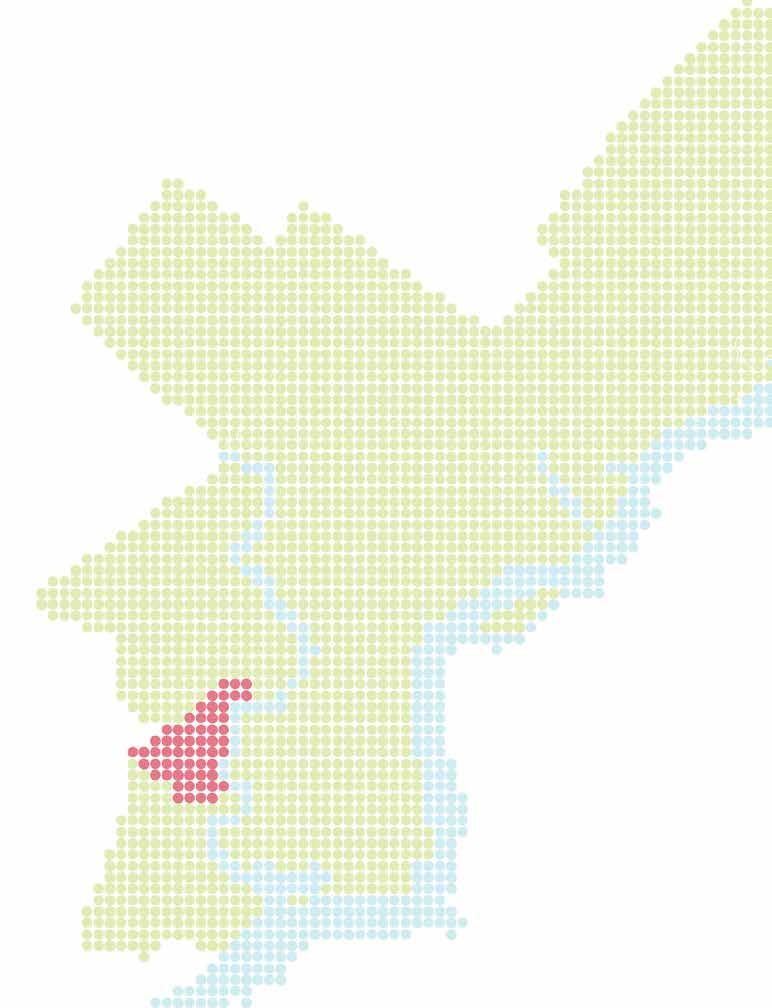



There couldn’t be a more important time to plan for the redevelopment of Bartram Village and revitalization of the Kingsessing neighborhood and Southwest Philadelphia. Residents of Bartram Village and the larger neighborhood have come together with local institutions and stakeholders to shape an aspirational plan for a safe, healthy, peaceful, and inviting community with the hope that all who live there and visit will Blossom at Bartram.
IN THIS SECTION:
Executive summary
The vision Community aspirations Guiding themes Summary of plan goals
There couldn’t be a more important time to plan for the redevelopment of Bartram Village and revitalization of the Kingsessing neighborhood and Southwest Philadelphia.
Explosive growth and redevelopment is visible nearby in Center City and University City, as well as Northern Liberties, Kensington, and North Philadelphia, as people of all ages from Millennials to empty nesters are choosing to live in the City. And now interest is beginning to shift to Southwest Philadelphia.
For decades, working class families have called Southwest Philadelphia home as they fueled the factories nearby. The Kingsessing neighborhood has also served as point of entry for immigrants arriving in the city, finding a welcoming community with a wide range of housing, services, and amenities. These patterns continue today although the quality of life has diminished as the shape of industry has changed, incomes have decreased, and educational attainment has fallen. This has coincided with divestment in the area, aging housing, and an increase in crime.
At a time when many Philadelphians are struggling to pay for housing, particularly the city’s lowest-income households, areas experiencing conditions such as Southwest Philadelpia are particularly vulnerable.
Bartram Village forms a green oasis with Bartram’s Garden next door and is nestled within the industrial corridor in Southwest Philadelphia. Built in 1942 as defense worker housing, the site was converted into 500 units of public housing and today is home to approximately 1,050 residents. It provides much needed affordable housing
in the city but at over 80 years old, it requires significant repairs. Reimagining the site presents a tremendous opportunity to create a vibrant, self-sufficient community that enhances the quality of life for residents of Bartram Village as well as the surrounding neighborhood.
The building blocks that once gave rise to a vibrant streetcar suburb in Southwest Philadelphia remain. Lively corridors, an extensive transit system, great walkability, a waterfront bike trail, employment centers nearby, a rich history and diverse culture—all can be found in the Bartram Choice neighborhood and form the foundation that the plan builds upon.
Several recent plans and studies of areas in and around the Bartram Choice neighborhood have paved the way for major investments in the coming years. Perhaps the most significant is the Lower Schuylkill Master Plan, which envisions a new Innovation and Logistics Hub on the Schuylkill Riverfront, bringing with it approximately 3,000 new jobs when fully realized.
In February 2018, the Department of Housing and Urban Development (HUD) generously awarded the Philadelphia Housing Authority a 1.3 million dollar Choice Neighborhoods Initiative Planning and Action Activity grant to develop a transformational neighborhood plan. The plan is centered around the redevelopment of Bartram Village and focuses on three core goals:
▶ Housing: Replacing distressed public and assisted housing with high-quality mixed-income housing.
▶ People: Improving outcomes for residents living in the Bartram Village with regard to employment and income, health, and children’s education.
▶ Neighborhood: Attracting public and private reinvestment in the community neighborhoods to offer amenities and assets that are important to people such safety, connectivity, and economic development.
The two-year planning process brought together residents, neighborhood partners, and local institutions to share ideas and information, and develop an aspirational community-driven vision— Blossom at Bartram.
Blossom at Bartram is a comprehensive neighborhood plan that outlines clear goals and provides a road map of strategies and metrics to achieve this vision.

Building blocks that once gave rise to a vibrant streetcar suburb in Southwest Philadelphia form the foundation of the plan.
The overarching goal for the Bartram Choice plan is to enhance the quality of life for all residents of the neighborhood by preserving housing affordability and reestablishing safe connections to the resources they need to live life more fully and ultimately, thrive.
The vision for the renewed Bartram Village embraces the plan’s themes— Connect, Live, and Thrive —by stitching the site back into the neighborhood and celebrating its unique location next to Bartram’s Garden—Southwest Philadelphia’s “backyard”—and the Schuylkill River. The site’s natural resources are preserved to create a beautiful, pedestrian-friendly, safe, welcoming community of which residents can feel proud.


At the start of the planning process, we asked Bartram Village and neighborhood residents about their vision: In the future, how would you like the next generation to view this community?
“More green spaces.”
“I would want them to view it as a safe haven or as a place that helped them become successful.”
“As a beautiful place to raise a family.”
“As one where you can feel safe, bring your children or family knowing you can eat out, go to clean, nice parks, and take walks in bright neighborhood.”
“As a place to take pride in and call home.”
“To become a place where I can feel happy about raising my sons and not feel as if something bad will happen.”
“As an eco friendly neighborhood.”
“A beautiful and peaceful place to live.”
“I would like them to see it was a nicer, greener place to live without the violence!”
“Mixed races financially stable and financially struggling families.”
“I’d like the future generations to view this community to see this as a safe and loving place.”
“As an oasis, a safe haven, and a fresh start.”
“Green and peaceful.”
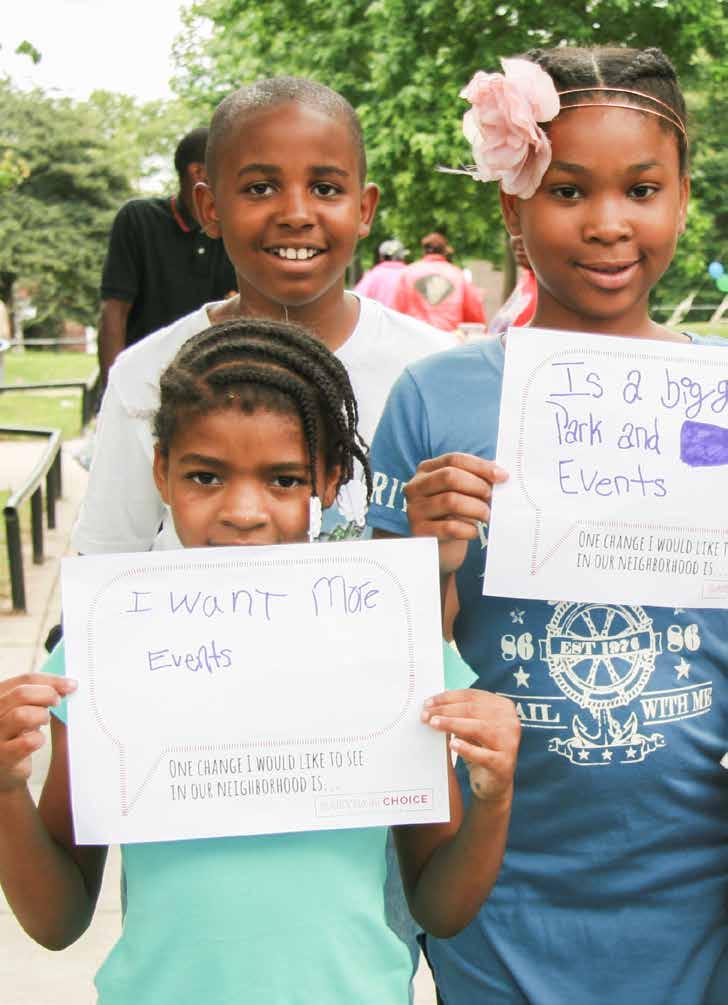
The vision, goals, and strategies for the Bartram Choice Neighborhood Plan were shaped directly by residents of Bartram Village and the broader Choice neighborhood, who served on every task force and committee, and participated in well over 30 public meetings, workshops, focus group discussions, and special events.
During the planning process three themes emerged— Connect, Live, and Thrive —that are the organizing elements of the plan.
Create an inviting community that is clean, green, and safe with beautiful, active public spaces. Connect people to these places; to nature and recreation; and to each other.
Southwest Philadelphia has a variety of beautiful green spaces and public places, as well as lively corridors, a variety of services and other amenities. But getting to them is challenging because of street conditions, limited rail crossings, and concerns about safety. Establishing a network of safe connections across the neighborhood to key resources and services will dramatically increase the quality of life in the community.
Create an environment that fosters the health and wellness of all residents of all ages, through healthy and affordable housing, access to medical services and nutritious food, and to spaces that heal the mind and body.
Trauma and the fear associated with it undermines the sense of peace that residents deserve to have in a place called home. Over 600 new units of healthy affordable housing will be blended on-site at Bartram Village with gardens and green spaces that extend the beauty of the beloved Bartram’s Gardens next door. The design aims to lessen stress and anxiety with the healing power of nature and by encouraging physical activity and social interaction.
Foster access for people of all ages to education, skills, jobs, services, inspiration and encouragement so that they can thrive. Enable the neighborhood to blossom by celebrating its history and strengthening its commercial corridors and identity.
Not everyone follows the same path in life. It is important to for there to be multiple avenues to self-sufficiency—from meaningful job opportunities, to college, to entrepreneurship, and homeownership to build wealth. Establishing a local “employment eco-system” will develop the skills of neighborhood residents to perform jobs that stabilize conditions in the community and help residents remain in homes, with a particular focus on construction, green infrastructure, small businesses, and childcare.
Goal 1
Develop a clean and green network of streets along primary circulation routes that connect major services, amenities, and green spaces to Bartram Village and the waterfront.
Goal 2
Foster a safe neighborhood day and night for residents of all ages.
Goal 3 Create a healthy outdoor environment that promotes physical exercise, social experiences, and wellness.
Goal 4
Enhance the existing transportation network through safe street crossings, trail connections, and increased walkability.
Goal 1
Promote healthy, affordable housing and homeownership opportunities throughout the Bartram Choice neighborhood.
Goal 2 Provide attractive, affordable housing and a healthy built environment at Bartram Village.
Goal 3 Enhance the physical health of residents by expanding access to a wider range of quality health services.
Goal 4 Establish an environment that promotes positive mental health and healing.
Goal 5 Improve access to nutritious, affordable food.
Goal 1
Develop a pathway to success beginning in early childhood.
Goal 2 Nurture a culture of literacy at Bartram Village.
Goal 3
Cultivate a local employment ecosystem that aligns with neighborhood needs and opportunities.
Goal 4
Bridge the basic skills divide.
Goal 5
Strengthen the identity and vibrancy of the neighborhood.


The Bartram Choice neighborhood is fortunate to have a number of advantages to build upon. These include a well-established transit system connected to major employment hubs. In addition, the neighborhood enjoys several active commercial corridors, churches, schools, health facilities, parks and community facilities, not to mention some very passionate neighbors.
IN THIS SECTION
Bartram Village Defining the Bartram Choice neighborhood Resident profile A little history The neighborhood today


The Bartram Choice neighborhood has all of the features that are attracting people across the country to urban environments—vibrant, walkable blocks; a variety of housing, activities, green spaces, and jobs nearby; transit alternatives to leave the car behind... it’s all here.
But the neighborhood and many of its residents are not thriving as much as they could, in part because these pieces are fragmented. The area’s industrial heritage and decades of disinvestment have created infrastructure challenges that make it difficult for residents to access or “connect” to these resources. The aging housing stock, concerns about crime and safety, unemployment, and low incomes have also made it harder for residents to “live” comfortably and healthfully, let alone “thrive.”
Fortunately, many of the building blocks that allowed the community to flourish as a streetcar suburb remain. And its these seeds that the Bartram Choice plan strives to build on so that all residents may connect—live—thrive!
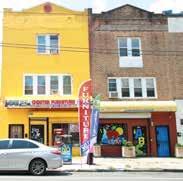
◀

Civic resources like the Kingsessing Library help to anchor neighborhood corridors and provide key programs
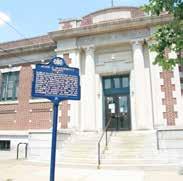
◀ Neighborhood green spaces like Bartram’s Garden and other community gardens provide spaces to build community, support healthy lifestyles and nurture a connection to nature that is educational, healing, and restorative
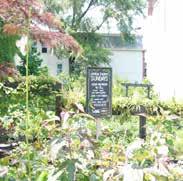
◀ The neighborhood’s lively commercial corridors offer services, amenities, and employment
◀ The historic housing stock and walkable human-scale design help to provide a strong foundation for quality of life
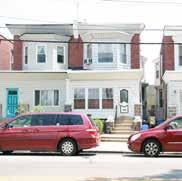
◀ Regular trolley service connects residents to jobs and services throughout the city

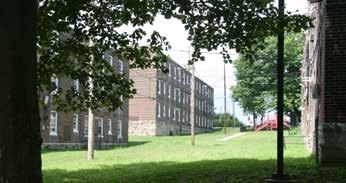
Bartram Village sits on a beautiful 22-acre wooded site in the Kingsessing neighborhood of Southwest Philadelphia. It is nestled within a stretch of Philadelphia’s industrial landscape that runs along the lower Schuylkill River. Bartram Village forms a green sanctuary in the neighborhood with Bartram’s Garden, a 45-acre national historic landmark that is tucked right behind Bartram Village overlooking the river.

Bartram Village was built in 1942 to house workers in the defense industry. The site was turned into public housing after World War II and today is home to approximately 1,050 residents. Five hundred units fill 41 residential buildings on the site, providing much-needed low-income housing in the city. Yet, Bartram Village is nearly 80 years old and in need of repairs with the costs to fully rehabilitate the buildings estimated at over $112 million.
Bartram Village also faces other obstacles that make it is difficult for residents to thrive. The long three-story buildings are out of scale with nearby homes and the layout of the site does not tie into the existing street grid. A wrought-iron fence wraps around the property without a clear and welcoming front door to the neighborhood. Traffic zips along Lindbergh Boulevard and criss-crossing rail lines further isolate the site physically from the neighborhood, making it difficult and unsafe to walk to recreation centers, the grocery store, or basic services along the commercial corridors. This is compounded by a hard-to-shake, decades-old reputation for crime and gang-related activities that has made it difficult for Bartram Village to feel part of the larger community and able to turn the page on a fresh new chapter.

The boundary of the Bartram Choice neighborhood stretches from the Schuylkill River west to Springfield Avenue and from 67th Street north to the Woodlands Cemetery, along the edge of University City. It includes a substantial portion of the Kingsessing neighborhood and larger area of Southwest Philadelphia. Approximately 40,000 residents live within the 2.78 square miles. The boundary includes several long-established institutions, as well as schools, civic, non-profit and religious organizations. The boundary was defined with the hope of bringing these organizations together to share conversations around community issues and refine programs and services to better meet the needs of all neighborhood residents.

Kingsessing is a Delaware Indian name for “place where there is a meadow.”
The Choice neighborhood is slightly younger than the city of Philadelphia, with a median age of 31 compared to 35 for Philadelphia. Bartram Village, however, is much younger, with a median age of 20. Approximately half of Bartram Village residents are under the age of 18.
The Choice neighborhood also has a significant senior population with 22% of residents over 55 compared with 26% in the city and 10% at Bartram Village. In addition, the number of female residents at Bartram Village is significantly higher at 64% versus 54% in the neighborhood and 53% in the city.
OTHER RACE ALONE (1.6%)
ASIAN ALONE (8.3%)
TWO OR MORE RACES (3%)

WHITE ALONE (10%)
BLACK ALONE (76%) AMERICAN INDIAN ALONE (0.3%)
The Choice neighborhood has a greater proportion of minority residents than the city as a whole: 76% of residents identify as black, 8% as Asian, and 10% as white versus 42% black, 8% Asian, and 40% white in Philadelphia. This minority concentration is greater still at Bartram Village where 96% of residents are black, 0.4% Asian and 3% white.
What races do the residents of the Choice Neighbrohood identify as?
UNEMPLOYMENT 15% POP UNDER 18 28%
UNEMPLOYMENT 11% POP UNDER 18 21%
POPULATION 39,889
MEDIAN AGE 31 # OF HOUSEHOLDS 14,113 MEDIAN HOUSEHOLD INCOME $28,705
MEDIAN AGE 35
POPULATION 1,587,761
# OF HOUSEHOLDS 620,775 MEDIAN HOUSEHOLD INCOME $40,314
Demographics
Bartram Village
Bartram Choice Neighborhood Philadelphia
TOTAL POPULATION 1,048 39,889 1,587,761

MEDIAN AGE 20 31.2 34.7
POPULATION 55+ 10% 22% 26% POPULATION <18 48% 28% 21% NO. OF HOUSEHOLDS 454 14,113 620,775 MEDIAN HH INCOME $8,876 $28,705 $40,314 UNEMPLOYMENT 68% 15% 11% BLACK 96% 76% 42% WHITE 3% 10% 40% ASIAN 0.4% 8% 8%
HISPANIC ORIGIN 1% 4% 15%
NO. OF HOUSING UNITS 500 16,379 687,512
% OWNER-OCCUPIED UNITS NA 39% 47%
% RENTER-OCCUPIED UNITS 100% 47% 43%
% VACANT UNITS 9% 14% 10% MEDIAN HOME VALUE NA $79,084 $153,502
SOURCE NEIGHBORHOOD & PHILADELPHIA DATA FROM 2017 ESRI BUSINESS ANALYST ONLINE; BARTRAM VILLAGE DATA FROM PHA (3.26.18)
The Choice neighborhood is served by six public schools: two elementary, two K-8, one middle school and one high school. In addition, there are several private and charter schools located within the boundary. Public schools where many Bartram Village students begin their academic careers are among the lower performing schools in the city. Although there are signs of progress and achievement, performance indicators are concerning. According to the School District of Philadelphia School Progress Report for School Year 2017-2018 for the four area public schools, the percentage of students reading at grade level for grades K-2 ranges from only 27% to 42%. The average percentage of students proficient or advanced in the PSSA English Language Arts for grades 3 to 8 ranges from 18 to 31%, and for mathematics ranges from 5% to 16%. The graduation rate for Bartram High School is currently 67%.
The Choice neighborhood trails the city in terms of educational attainment, with 15% of the population possessing a bachelor’s degree or more, compared to 27% citywide. At Bartram Village, according to the Needs Assessment Survey, between 3 to 8% of adults have a bachelor’s degree or higher, however, there are many promising young students at Bartram Village. Thirty percent of survey respondents said their high school-age children intend to go on to a 2 or 4-year college and 20% plan to enter the workforce.
Discussions with local service providers and stakeholders indicate that literacy is also a big issue for many residents at Bartram Village and in the Choice neighborhood. The lack of proficiency in this area prevents residents from gaining employment, and in the case of adult literacy issues, can hinder a child’s ability to excel in school without reading support at home. There is a great opportunity to expand programming in the areas of literacy, tutoring, and academic enrichment to enable all residents to realize their full potential.
Although the Choice neighborhood is located near large job hubs, unemployment in the Bartram Choice neighborhood runs high. Compared to the city’s elevated rate of 11%, unemployment in the neighborhood is 15%, and it is higher still for Bartram Village residents at 68%. This is reflected in the median household income at Bartram Village of $8,876 versus $28,705 in the neighborhood and $40,314 in the city.
The top industries for employed residents in the Choice neighborhood are health care and social assistance, accommodation and food services, retail, and administration and support, and education. Only about 5% of employed residents work in the Choice neighborhood. More than half work in the city and the other half work outside of Philadelphia.
Philadelphia has the highest rate of poverty for a large city in the United States at 24%. The poverty rate in the Bartram Choice neighborhood is 32%.
Bartram Village has the highest rate of unemployment within the Choice Neighborhood, at 68%. Many residents are taking care of children or are unable to work for other reasons. Other pockets of high unemployment in the neighborhood include areas in the south, near Mt. Moriah Cemetery and Connell Park, and between Kingsessing Avenue, Woodland Avenue, 54th Street and 58th Street.

CHOICE NEIGHBORHOOD
TARGET HOUSING SITE WATER PARK / OPEN SPACE
UNEMPLOYED
American Community Survey 2016 - 5 year estimates
In addition to Bartram Village, there are two other notable pockets with a high concentration of residents living below the poverty line: at the northern edge of the neighborhoood near Clark Park, and the southwestern corner near Mt. Moriah Cemetery. The middle of the neighborhood and the southeastern corner have decidedly lower concentrations of poverty.

CHOICE NEIGHBORHOOD
TARGET HOUSING SITE WATER
PARK / OPEN SPACE
% OF POPUL ATION BELOW THE POVERT Y LINE
American Community Survey 2016 - 5 year estimates

The Kingsessing neighborhood is one of the oldest settled areas of Philadelphia. Native American Lenni Lenape tribes treasured the rich soil along the Schuylkill River. Swedish colonists formally settled the township of Kingsessing—“the place where there is a meadow”—in 1644. In the 1700s, the area became home to large farm tracts and country estates. John Bartram purchased land from the Swedes in 1728, which became the nation’s first botanical garden and gathering place for friends and visitors such as George Washington, Ben Franklin and Thomas Jefferson. Bartram’s friend and fellow botanist, Andrew Hamilton, owned another expansive estate a mile to the north called the Woodlands.

Soon the area was populated by other country estates, cemeteries and parks that wealthy Philadelphians invested in to escape the conditions of the city. The Woodlands was transformed into a Victorian cemetery with an arboretum of over 1,000 trees in 1840, and not long after Mt. Moriah was created as a grand garden cemetery in 1855. By the mid-1800s, nurseries and greenhouses also filled the area. Farming continued to take place in Kingsessing until the early 1900s when industry began to take over.

In the 1800s, the industrial revolution took advantage of the neighborhood’s location on the banks of the Schuylkill River with direct access to the Delaware River. It soon became home to heavy industry including oil refining, manufacturing, distribution, and waste management. As the riverfront slowly changed from green to industrial, waves of Irish, German, Lithuanian, Polish, Italian, and Jewish immigrants settled nearby, forming a thriving working-class neighborhood.
Urbanization exploded when the city’s streetcar network expanded to University City and into Southwest Philadelphia, and the electric streetcar was introduced in 1894. Development sprang up along the streetcar routes with rowhouses built to meet the demand for housing, expanding access to living and employment opportunities. Woodland Avenue and Chester Avenue became important retail corridors as the area evolved from a rural community into one of the region’s first streetcar “suburbs.”
The neighborhood continued to flourish as a diverse and vibrant community well into the 20th century. But soon after WWII, industry in the neighborhood bottomed out as it did in many cities across the country. People and businesses started moving away and a slow process of disinvestment began.

THE TOWNSHIP OF KINGSESSING IS FOUNDED BY SWEDISH SETTLERS.
LARGE ESTATES ARE DIVIDED AND MASSIVE NUMBER OF A MILLS ARE CLOSED LEADING TO DEVELOPMENT OF MUCH OF THE AREA AS A RESIDENTIAL SUBURB.
THE WOODLAND AVENUE COMMERCIAL CORRIDOR BLOSSOMS INTO A RETAIL DISTRICT.
KING’S HIGHWAY (WOODLAND AVENUE) IS DESIGNED FROM GRAYS FERRY TO THE BALTIMORE AREA, BECOMING A MAIN ROAD FROM PHILADELPHIA TO SOUTHERN COLONIES.
AS ELECTRIC STREETCARS REPLACE HORSECARS, THE TROLLEY BEGINS TO DEFINE THE CHARACTER OF THE COMMUNITY.
TILDEN MIDDLE SCHOOL OPENS.
SEPTA IS ESTABLISHED, COORDINATING TRAVEL BETWEEN THE CENTRAL BUSINESS DISTRICT AND LARGER REGION.
AFRICAN IMMIGRATION INCREASES POPULATION IN THE LOWER SOUTHWEST DISTRICT.
LOWER SCHUYLKILL MASTER PLAN IS ADOPTED, WITH A VISION OF RENVIGORATING THE AREA AS A MODERN INDUSTRIAL HUB.
BARTRAM VILLAGE IS BUILT TO HOUSE DEFENSE WORKERS.
IMMIGRANTS FROM SOUTHEAST ASIA BEGIN TO SETTLE IN SOUTHWEST PHILADELPHIA.
CONSTRUCTION BEGINS ON 58TH STREET GREENWAY CONNECTING COBBS CREEK TO BARTRAM’S GARDEN.
HUD AWARDS PHA A CHOICE NEIGHBORHOODS PLANNING AND ACTION ACTIVITY GRANT TO DEVELOP AN ASPIRATIONAL NEIGHBORHOOD PLAN.
Pieces of the past are still visible today throughout Kingsessing and Southwest Philadelphia, giving it a rich and varied character, and many elements to build upon.
The industrial footprint is still visible today with 20% of the Choice neighborhood zoned for industrial use, primarily along the Schuylkill River, where several large industrial sites sit empty or crumbling along Grays Avenue and Lindbergh Boulevard. The recent Lower Schuylkill Master Plan, however, outlines an ambitious vision for an innovation and logistics hub that could bring approximately 3,000 jobs to the neighborhood in the next several years. These two modern industrial campuses would sit along the river directly north and south of Bartram Village.
New anchor institutions have also emerged. The Bartram Choice neighborhood borders University City to the north, which is home to many of Philadelphia’s health and educational institutions including the city’s largest employer—the University of Pennsylvania—as well as the Hospital of the University of Pennsylvania, Children’s Hospital of Philadelphia, and Drexel University. The University of the Sciences—North America’s first college dedicated to pharmacy studies—is located within the Choice neighborhood, where it is expanding rapidly.
Proximity to these institutions provides opportunities for residents to thrive with jobs in healthcare, education, and supportive services. Their presence also presents the potential to create unique partnerships that could benefit and enrich neighborhood residents through tutoring, mentoring, and specific job training programs. Employees of these institutions who purchase homes close by and who use local services also help to stabilize the community.
Although outside of the Choice neighborhood, the Philadelphia International Airport is only three miles to the south. The airport and related services account for approximately 96,000 jobs in the region.
175 BUSINESSES
UNIVERSITY CITY 80,000 JOBS
CENTER CITY 300,000+ JOBS

The Philadelphia City Planning Commission (PCPC) identifies areas of the city that are blighted. To receive this designation, an area must meet at least one criteria, which are set by state law. The most common include:


▶ unsafe, unsantiary, inadequate conditions
▶ economically or socially undesirable land use
▶ faulty street and lot layoutworks
The Redevelopment Authority then works to make improvements recommended in the Redevelopment Area Plan, which guides the redevelopment of public land in accordance with City policies, public plans and priorities. Blight certifications expire after 20 years, but can be renewed.
The other major land use in the Choice neighborhood is residential (31%). The wide range of housing styles in Kingsessing and Southwest Philadelphia reflect the historically diverse population, from the working-class community that first arrived to support the factories to the middle class residents who later made the streetcar suburb their home. Smaller two-story rowhomes are most common throughout the neighborhood. Along the commercial corridors, rows of three-story attached buildings are typical with retail on the ground-floor and residential units above. More ornate late Victorian and late 19th to early 20th century twins and rowhouses are visible along Chester and Woodland avenues.
spotlight92% of the housing stock was built before 1950. This is typical of an older American city like Philadelphia, but a growing concern because of the cost to maintain it. There is also considerable variation in housing values within the neighborhood: the median assessed value in the northern tip (part of the 19104 zip code) was $312,600 compared to $51,200 in 2017 in the center of the neighborhood (located in the 19143 zip code).
Home values have begun to increase, especially in the north end closest to University City. Real estate pressure is expected to continue to push further south as citywide market conditions improve. As a result, there is a strong imperative to preserve housing affordability and fend off predatory buyers in Southwest Philadelphia, while helping area residents fix, maintain, and remain in their homes.
Vacant, blighted, and abandoned properties are scattered throughout the neighborhood. Residents frequently expressed their frustration over the unsafe and unattractive conditions they create. Many of these small residential properties are not concentrated enough for significant redevelopment and will require a targeted infill strategy. The Pennsylvania Horticultural Society’s LandCare program continues to successfully clean, green, and fence dozens of empty lots to reduce blight.
Although the Choice Neighborhood has significant vacancy, the scattered nature is more suited to small infill development.
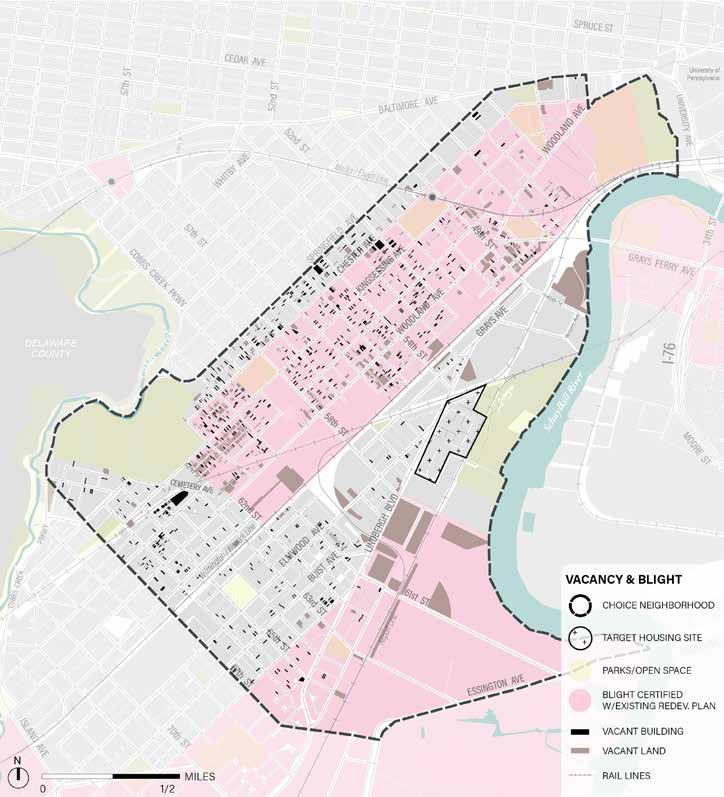
The African Cultural Alliance of North America is a nonprofit organization that advocates for the welfare and rights of African and Caribbean immigrants and refugees throughout the Philadelphia region. Services include social and legal support, health services, community development programs, organizing African arts and culture events, commercial corridor and small business development, job training, and youth programs.

CONTACT: 5530 Chester Ave Philadelphia, PA 19143 215-729-8225 acanaphila@gmail.com
Historically, Southwest Philadelphia has welcomed waves of different populations seeking affordability and access to jobs. This remains true today with a foreign-born population of 14 percent, similar to the citywide share of 13 percent. Foreign-born residents frequently come from Africa, Asia, and Latin America. The African foreignborn residents predominantly come from Western Africa, including Liberia, Ghana and Nigeria. Asian foreign-born residents primarily come from Vietnam and Cambodia, and Latin American foreign-born residents come from the Caribbean islands. The diverse population creates a rich cultural fabric that provides exciting opportunities to distinguish the area from other parts of the city. This is particularly visible along the three major commercial corridors that serve the Choice neighborhood:
Woodland Avenue from 58th to 68th streets houses more than 175 businesses with specialty retail shops, restaurants, small grocery stores, and clothing shops, with many African-owned businesses gathered near 65th
Street. The African Cultural Alliance of North America (ACANA), a nonprofit organization serving African and Caribbean immigrants, manages the corridor and has just completed a study to develop a more visible cultural identity for a portion of the corridor from 61st to 68th streets.
On Chester Avenue from 54th to 58th streets, convenience stores and local retail shops sell beauty products, clothing, and personal care products. ACANA is headquartered here and has plans to initiate clean-up efforts similar to their efforts along Woodland Avenue, and to assist the corridor in filling vacancies and restoring storefronts.
The northern portion of Woodland Avenue from 46th to 49th streets is slowly blossoming with locally-owned restaurants and small stores catering to the University of the Sciences student population. Another commercial corridor is taking shape along Elmwood Avenue, beginning at 58th Street and extending beyond the Choice neighborhood boundary to 70th Street. Corner stores and other small-scale retail are dotted throughout the neighborhood.

In the first seven months of 2019, there were over 1000 crimes committed in the Bartram Choice neighborhood according to the Philadelphia Police Department Crime Mapper. These include four homicides, 12 rapes, 68 robberies, 113 aggravated assaults, 82 burglaries, and 283 thefts. The constant threat of violence and perception of crime, which is made worse by high numbers of vacancies and blighted conditions across the neighborhood, has a significant impact on the quality of life in the community. As illustrated by the accompanying map, there are several hotspots for violent crimes in the residential areas of the Choice neighborhood, in particular towards the southwestern end. Bartram Village also falls within an area of elevated incidence of crime. The neighborhood is served by the 12th Philadelphia Police District, with regular patrols by car and on foot. The 12th District works closely with PHA’s police department on joint public safety initiatives.
One of the neighborhood’s greatest strengths is its location near University City, Center City and the larger region, and the extensive public transit network that connects it to these hubs. SEPTA’s trolley system is one of the longest operating streetcar systems in North America and serves as a direct link between University City and Center City. Four of the six City trolley lines (11, 13, 34 and 36) serve the Bartram Choice neighborhood with the #13 running along the commercial spine of Chester Avenue, the #11 along the Woodland Avenue commercial corridor, and #36 running along Grays Avenue and Lindbergh Boulevard (with stops at Bartram Village) before making its way along Elmwood Avenue. SEPTA has plans to make significant improvements to the trolley network, including acquisition of modern light rail vehicles and construction of station platforms that will make the entire system Americans with Disabilities Act (ADA) accessible.
SEPTA’s extensive bus network also serves the Bartram Choice neighborhood with five routes (37, 52, 64, 108, G). Of these routes, three (52, 108, G) run every 15 minutes or less, 15 hours a day, 5 days a week. In addition, two SEPTA regional rail lines pass through the neighborhood. Although the Airport Line does not currently have a stop in the neighborhood boundary, the Media/Elwyn line recently renovated the stop next to the Kingsessing Rec Center.
But having the infrastructure in place is only part of the story. A 2019 report by Pew, the Cost of Commuting for Philadelphians, found that while the base fare is less than in other comparable cities, residents in many of Philadelphia’s low-income communities who rely on SEPTA to get to work experience costlier trips. This is because communities like Southwest Philadelphia are farther from center city and require one or more transfers.
The completion of the Schuylkill Crossing in the summer 2020 will connect the Choice neighborhood to center city along the Schuylkill River Trail and provide a potentially lower cost commuter option. A number of on-street bike trails exist in the Choice neighborhood but conditions are inconsistent and limited to street markings and a few shared bike/ped segments.
The pedestrian scale of the Choice neighborhood makes it appear very walkable. But the neighborhood’s industrial legacy left behind a tangle of rail lines that dissect the street grid. The tangled web limits east-west pedestrian, bike and auto connections across the neighborhood, with a particularly dangerous at-grade freight crossing near 58th and Woodland Avenue. It also creates deadend streets and dark corners that combined with vacant properties make it uncomfortable and unsafe for residents to navigate the streets on foot. This makes it harder for residents to connect to services and amenities.
Historic sites like Bartram’s Garden, the Woodlands, and Mt. Moriah Cemetery and Nature Preserve bring history to life through their buildings, artifacts, stories, and programs. These treasures also anchor the corners of the Choice neighborhood with significant public green space.
The grand Beaux-Arts Kingsessing Recreation Center opened to the public in 1916 and is one of the city’s oldest and largest recreation centers, sitting on nearly 9 acres. It provides additional green space and is a beautiful complement to the Kingsessing Library next door that was built in 1919 by philanthropist Andrew Carnegie.
Neighborhood parks and playgrounds create much needed green space in the heart of the neighborhood including Clark Park, Comegys Playground, The Francis J. Myers Recreation Center, 63rd & Lindbergh Park, Connell Park, McCreesh Playground and Skatepark, and Deritis Playground.
Public access to the Schuylkill riverfront expanded in 2017 with the completion of Bartram’s Mile, a 1.1-mile running, walking, and biking trail through the grounds of Bartram’s Garden. This trail will soon connect to Center City via the Schuylkill River trail. The dock at Bartram’s Garden offers free fishing, boating, and other forms of recreation along the river. Additional investments are planned to create more water-related programs and foster a love of nature.
The John Bartram House, John Bartram High School, Weir Mitchell School, Tilden Middle School, The Woodlands, and Regent-Rennoc Court are listed on the National Register of Historic Places.

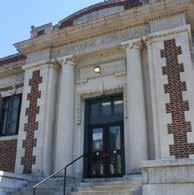
Mount Moriah Cemetery, c. 1855 ▲ Kingsessing Library, c. 1919 ▶ The Woodlands, c. 1770 ▼
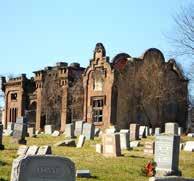
Did you know that the Choice Neighborhood is home to many historic landmarks listed on the National Register?


Several recent plans and studies of areas in and around the Bartram Choice neighborhood have paved the way for major investments in the coming years. The Bartram Choice plan builds on these efforts and aligns with these goals to foster the conditions necessary for public and private reinvestment.
IN THIS SECTION:
City-wide plans
District plans
Specific plans and initiatives Bringing it all together
Although Kingsessing, Southwest Philadelphia and the Bartram Choice neighborhood have not shared equally in the city’s growth of the last several years, the area has been the focus of several studies with hundreds of millions of dollars targeted in investments along the Schuylkill River and throughout the neighborhood.
The Bartram Choice plan aligns with and builds on these efforts. Outlined in this section are brief descriptions of these plans and initiatives, highlighting strategies that are directly connected to the Bartram Choice plan.
Philadelphia 2035, Citywide Vision, 2011
Philadelphia2035, the first written comprehensive plan for Philadelphia since 1960, lays out the official 25-year vision for the future growth and development of the city. It is divided into two parts. The Citywide Vision establishes policy and recommendations focused on three guiding themes: “Thrive” with new growth and opportunities; “Connect” to the region and the world; and “Renew” the city’s valued resources for future generations. The second part of Philadelphia2035 entails the subsequent development of 18 District Plans for every corner of the city that recommend specific physical improvements, zoning changes, and areas of focus.
Relevance to Bartram Choice: The Bartram Choice neighborhood boundary falls within two of these planning districts— the University Southwest District and Lower Southwest District—which are described below.
plans and initiatives
Here is a sampling of some of the many plans and initiatives that have influenced and been incorporated into the Bartram Choice Transformation Plan:
This plan seeks to demonstrate how civic assets—parks, libraries, schools and other institutions—can be revitalized to yield equitable prosperity for urban communities. The document approaches civic assets as a collective network—a commons—and imagines how they can better operate together to expand their individual and collective capacities for the public good.
Relevance to Bartram Choice: With an emphasis on Philadelphia and the city’s University Southwest District, the planning process focused on (1) the history and current conditions of the city’s civic assets, (2) learning what the community wants to see change, and (3) developing simple design ideas to ignite revitalization. The study re-imagines several key Southwest Philadelphia assets— Paschalville Library, Myers Recreation Center, the 12th Police District Headquarters, John Bartram High School, and Woodland Avenue—that extend outward into the community, layer different uses and community needs into each space, and welcome residents to these new neighborhood hubs. All of these assets fall within the Choice neighborhood boundary with the exception of Paschalville Library.
Philadelphia 2035, Citywide Vision, 2011
Civic Commons: Reimagining Our Cities Public Assets, 2016


University Southwest District Plan, 2013 Lower Southwest District Plan, 2016
Lower Schuylkill Master Plan, 2013 Modern Trolley Station Design Guide, 2017

Art@Bartram’s: Exploration, Discovery and Exchange, 2015

Mount Moriah Strategic Plan, 2018 Conceptual Design for Creating Cultural Identity on Woodland Ave, 2019
The Upper Southwest District Plan includes the northern half of the Choice neighborhood until roughly 58th Street.
The plan identifies four Focus Areas, one of which—49th Street—falls in the Choice neighborhood boundary. This is notable because 49th Street is one of only a few streets in the Choice neighborhood that crosses over the railroad tracks. It also has public transit.
The district plan recognizes the potential of 49th Street to link neighborhood parks, recreation centers (Kingsessing and Comegys), commercial corridors, trails, and the Schuylkill River, which is also why the Bartram Choice plan identifies 49th Street as a “priority street.” Improvements would enhance growth surrounding the University of the Sciences campus, draw more activity to Woodland Avenue, create safer access to the Comegys Rec Center at 48th & Woodland, improve circulation to the Grays Ferry Bridge, and make it easier for residents to reach the Schuylkill River Trail on foot or by bike.
Relevance to Bartram Choice: In addition to the emphasis on 49th Street, other relevant recommendations include:
▶ Redesign Bartram Village to provide better connections to the existing street grid as well as Bartram’s Garden and the 58th Street Greenway (This goal is a primary focus of the Bartram Choice plan. See LIVE Goal 2, Strategy A.)
▶ Improve the tree canopy of the Kingsessing neighborhood by planting trees along the key corridors of Woodland Avenue, South 49th Street,
▶
Chester Avenue, South 58th Street, Whitby Avenue, and South 54th Street. (Many of these streets are identified as “Priority Streets” in the Bartram Choice plan and are targeted for cleaning and greening. See CONNECT Goal 1, Strategy A.)
Create a targeted zone for DHCD’s Basic System Repair Program in Kingsessing to help residents maintain their homes. (This is also a goal of the Bartram Choice housing plan. See LIVE Goal 1, Strategy B.)
▶ Create a Request for Proposals and subsidize the development of scattered site affordable housing in a section of Kingsessing bounded by Chester Avenue, Woodland Avenue, 58th Street, and 57th Street. (The Bartram Choice plan aims to promote healthy, affordable housing and homeownership opportunities throughout the Choice neighborhood. See LIVE Goal 1, Strategy A.)
▶ Create a targeted vacant land stabilization zone in Kingsessing to prevent the spread and detrimental effects of vacant land. (The Bartram Choice plan targets buildings along priority streets to be stabilized through Philadelphia’s Doors and Windows Ordinance. See LIVE Goal 1, Strategy C.)
▶ Rezone the Lower Schuylkill Industrial properties to better attract research and development, advanced and artisanal manufacturing, and institutional uses. (Although the Bartram Choice plan does not address rezoning these properties, the plan proposes complimentary design interventions such as a prominent gateway at 56th Street and Lindbergh Boulevard and streetscape improvements along Grays Avenue and Lindbergh Boulevard to enhance PIDC’s anticipated development of these properties. See THRIVE Goal 5, Strategy A and CONNECT Goal 4.)
▶ Improve the Kingsessing Rec Center with repairs, ADA accessibility, and stormwater management. (The Bartram Choice plan recognizes the Rec Center as a major neighborhood anchor and green space. It seeks to create cleaner, safer connections to the center along “priority streets.” See CONNECT Goal 1, Strategy A.)
▶ Extend Bartram’s Mile and Schuylkill River Trails. (In anticipation of the completed swing bridge, see “Schuylkill Crossing” below, the Bartram Choice plan strives to enhance connections to the Schuylkill River Trail in and around Bartram Village. See CONNECT Goal 3, Strategy D and THRIVE Goal 5, Strategy A.)
▶ Improve the Woodland Avenue commercial corridor. (Bartram Choice also encourages improvements to the Woodland Avenue corridor, see THRIVE Goal 5, Strategy D.)
The Lower Southwest District Plan includes the southern portion of the Choice neighborhood, generally south of 58th Street. One of the focus areas cited by the plan is the Woodland Avenue and Elmwood Avenue corridors (between 58th and 70th streets), offering several recommendations that are echoed by the Bartram Choice plan.
▶ Support the growth and maintenance of existing commercial corridors and centers through efforts such as expanding the storefront improvement program along the Woodland Avenue corridor. (See THRIVE Goal 5, Strategy D.)
▶ Increase access to healthy foods for all residents. (The Bartram Choice plan also identified the need
▶
to make affordable nutritional food available to all neighborhood residents. See LIVE Goal 5.)
Support the creation of affordable and senior housing in the neighborhood. (Increasing the availability of affordable housing is a primary goal of the Bartram Choice plan. See LIVE Goals 1 and 2.)
▶
Implement bicycle network improvements, including on-road portions of the East Coast Greenway. (The Bartram Choice plan sees this portion of the East Coast Greenway as an underutilized neighborhood resource that will become even more important when the Schuylkill Crossing swing bridge is completed in 2020, forming a trail connection to center city. See CONNECT Goal 4, Strategy D.)
▶
Increase local access to trails through improved lighting, signage, and pedestrian and bicycle routes, including the Woodland Avenue Corridor. (See CONNECT Goal 4.)
▶
Plant street trees to increase tree cover and improve air quality as recommended in Greenworks, the Bicycle and Pedestrian Plan, and the Complete Streets Handbook. (See CONNECT Goal 1.)
▶
Complete stormwater management projects within the public realm where stormwater can be captured to reduce runoff. (Bartram Choice outlines a network of priority streets for cleaning and greening with the hopes of expanding the street canopy and green infrastructure while improving the appearance of the public realm. See CONNECT Goal 1 and LIVE Goal 2.)
▶
Incorporate public art into new developments and public spaces through PRA’s Percent for Art Program, the City’s Percent for Art Program, and the Mural Arts Program, which includes partnering with Mural Arts to expand art in Bartram’s Gardens to the Lower Southwest. (See THRIVE Goal 5.)

The Lower Schuylkill Master Plan (LSMP) envisions a vibrant 21st century innovation district that integrates opportunities for new and growing businesses with an emphasis on research and development, advanced and artisanal manufacturing, and institutional uses. It is part of a coordinated city strategy to create jobs and stimulate economic development by reigniting the 3,700acre corridor along the river as three modern industrial campuses. Two of those campuses—the Innovation District and the Logistics Hub—will be located immediately north and south of Bartram Village. The third—the Energy Corridor—will sit across the Schuylkill River from the Choice neighborhood. The first phase is anticipated to be completed in 2022 and is expected to create about 500 jobs.
Relevance to Bartram Choice: PIDC is coordinating the implementation of the LSMP and is a key partner in the Bartram Choice effort as the Neighborhood Task Force Lead. Multiple goals and strategies of the Bartram Choice plan are aligned with the anticipated development of the Innovation District and Logistics Hub. These include streetscape improvements along Grays Avenue and Lindbergh Boulevard, ground-floor retail space in new mixed-use buildings facing Lindbergh Boulevard on the Bartram Village site, creation of a gateway at 56th Street, and job-training programs for Bartram Village and area residents tailored to anticipated employment opportunities. (See THRIVE Goals 3 and 5.)
Innovation District Plan
: Proposed buildings
: Existing buildings
To maximize as an recreational University center R & D, one-story users to medium-size of development, market To foster river and of flex interior. it the bank eventually, well. The complementary Grays to the neighborhoods. At full SF of annual impact. New Infrastructure Private New New Total
INNOVATION Source:
SEPTA is preparing for a once-in-a-generation replacement of its trolley fleet, which presents a tremendous opportunity to transform Philadelphia’s trolley system into a state-of-the-art light rail system. One of the largest light rail systems in the United States, SEPTA’s trolley system serves almost 100,000 people on weekdays and provides an essential direct, off-street link between Southwest Philadelphia, University City and Center City. In addition to the acquisition of modern light rail vehicles, SEPTA will also make improvements to station platforms so that the entire system will meet accessibility requirements of the Americans with Disabilities Act of 1990 (ADA).
Modernization entails a long and complex process that involves coordination with multiple agencies (PennDOT, OTIS, Commerce) as well as the public. In 2017, SEPTA and the Delaware Valley Regional Planning Commission released the Modern Trolley Station Design Guide as a reference for planners, engineers and community members to understand the goals behind modernizing trolley corridors within the city. The guide is the foundation for station design, corridor design, and engineering strategies that support SEPTA’s Trolley Modernization program principles, as well as City of Philadelphia Complete Streets policies. SEPTA anticipates planning and execution of the 1.2 billion-dollar trolley modernization program will extend into the next decade.
Relevance to Bartram Choice: The modernization program will have a dramatic impact on the character of the streetscape surrounding improved stations. Much of the Bartram Choice neighborhood is served by and relies heavily upon the trolley system, including Bartram Village residents who have access to several stops just outside their door.

Schuylkill Crossing is currently under construction and anticipated to be completed in the summer 2020. The new swing bridge will meet ADA requirements and provide easy access for pedestrians and cyclists to the Schuylkill River Trail just south of the Grays Ferry Bridge. The crossing will complete a vital bike/ped connection between Southwest Philadelphia and Center City along the Schuylkill River Trail, which currently ends at Bartram’s Garden.
Relevance to Bartram Choice: In anticipation of the completed swing bridge, the Bartram Choice plan strives to make existing connections in and around Bartram Village to the Schuylkill River Trail more visible and accessible so that all residents may take greater advantage of these recreational opportunities as well as connections to center city employment options. (See CONNECT Goal 3, Strategy D and THRIVE Goal 5, Strategy A.)
As part of its Creative Communities and Watershed Protection programs, the William Penn Foundation funded Art@Bartram’s to maximize the potential of the historic Bartram’s Garden for both public life and public education.

The Lindy Institute for Urban Innovation at Drexel University—in partnership with the Philadelphia Mural Arts Program and the John Bartram Association—led the effort. The resulting action plan aims to build awareness of and encourage stewardship of Bartram’s Garden and Bartram’s Mile, using artmaking as a vehicle for connecting communities with the Garden.
Relevance to Bartram Choice: Art@Bartram’s recognizes the important role that Bartram’s Gardens plays as an anchor of the surrounding community and the potential it has to jumpstart conversations about
neighborhood change, history, environment, and place. To varying degrees, all four guiding principles of Art@ Bartram’s resonate in the Bartram Choice plan but the first principle, Bridge the Divide, overlaps most between plans. It recognizes the physical and psychological isolation of Bartram’s Garden from its neighbors and the city as a whole, emphasizing the need to lessen these barriers by reaching into the neighborhood at key gateways through artistic interventions. The Bartram Choice plan recognizes the potential of these intersections to become key nodes that bring community residents together through art and placemaking efforts that celebrate the area’s history, culture, and people. (See CONNECT Goal 1, THRIVE Goal 5.)
Expanding on its role as a living laboratory, community gathering place, and “Southwest’s backyard,” Bartram’s
Garden is moving forward with several new projects. These include a new boathouse, a nature-focused childcare center called the NESTT, FloatLab, and a mussel hatchery. The boathouse will be located on Botanic Avenue near 51st Street with a small café, exhibit space, classroom, boat and bike rentals to welcome the growing numbers of visitors anticipated with the Schuylkill River Trail expansion. The NESTT will be situated nearer to 56th Street and offer innovative hands-on learning opportunities from watershed education to African Diaspora culture, healthy living to horticulture for up to 200 students from infancy to Grade 8.
Scheduled for completion in 2020, FloatLab will be a one-of-a-kind, state-of-the-art installation and learning laboratory on the Schuylkill River waterfront. The project will use sound and light to interpret the ecological health of the river directly adjacent to Bartram’s Garden, and to teach the public how to become environmental stewards.
Relevance to Bartram Choice: At the intersection of art, history, horticulture, ecology, sustainable food systems, and community, Bartram’s Garden offers a tremendous range of opportunities for Bartram Village and area residents from learning to discovery, nutrition to exercise, employment to healing. The Bartram Choice plan strives to preserve and protect the natural resources of Bartram Village, Bartram’s Garden, and the river and enhance these opportunities. By blurring the edges between the sites and integrating natural features throughout the Bartram Village site, the plan aims to create more welcoming, visible connections to the neighborhood, through Bartram Village, and back to Bartram’s Garden and the Schuylkill River Trail.
The Mount Moriah Strategic Plan prioritizes the revitalization of Mount Moriah Cemetery as a civic asset to the surrounding Southwest Philadelphia district and the City of Philadelphia. Goals of the plan strive to reposition the cemetery as a green space amenity and historic center,
increase public access to the cemetery, engage with stakeholders to drive a culture of stewardship, develop supportive organizational structures, and ensure long-term sustainability of both the Cemetery and Nature Sanctuary.
Relevance to Bartram Choice: The Bartram Choice plan recognizes the extensive green space and historic feature that Mount Moriah offers to the Kingsessing / Southwest Philadelphia community. It’s location anchors the western corner of the Choice neighborhood at the end of Chester Avenue, which Bartram Choice identifies as a priority street in the neighborhood forming a major green axis that connects other green amenities including Myers Rec Center, Kingsessing Rec Center, and Clark Park. (See CONNECT Goal 1.)
The African Cultural Alliance of North America (ACANA) and the Community Design Collaborative just completed a conceptual design for the creation of a cultural corridor along Woodland Avenue from 61st to 68th Street. The vision is to form a regional attraction that celebrates the African diaspora and is inclusive of other cultures. Historically, Southwest Philadelphia has served as a “port of entry” for immigrants. Today, the area hosts one of the largest immigrant populations in the city, including African Americans, West African and Caribbean immigrants and refugees, and a smaller proportion of Asian and Latin American immigrants. This area also falls within the Woodland and Elmwood Avenue Corridors Focus Area, highlighted in the Lower Southwest District Plan.
Relevance to Bartram Choice: Bartram Choice aims to strengthen existing commercial corridors such as Woodland Avenue and Chester Avenue by supporting aesthetic and cleaning improvements. These pedestrianfriendly shopping corridors provide opportunities for social interaction and community building while offering vital services that are also transit-accessible. Bartram Choice
seeks to improve access to these main shopping corridors from the east side of the neighborhood by creating safe, well-lit, attractive connections across priority streets of 49th, 54th and 58th streets. (See THRIVE Goal 1 and CONNECT Goal 1.)
In 2017, Philadelphia City Council approved legislation to create the Rebuild program, paving the way for an historic investment in the city’s parks, recreation centers, and libraries through the Philadelphia Beverage Tax. The program is not only making physical improvements but also promoting diversity and economic inclusion in the design and construction industries, creating new career pathways for diverse Philadelphian to enter the building trades, and engaging residents to help shape improvements made to the facilities.
Relevance to Bartram Choice: Two major civic anchors of the Choice neighborhood—the Kingsessing Rec Center and Library and the Francis J. Myers Rec Center—have been selected for substantial improvements through Philadelphia’s Rebuild Initiative. The Paschalville Library, located just outside the neighborhood and heavily used by area residents, has also been selected for Rebuild investments. (See CONNECT Goals 1 and 3.)
There are several large parcels designated as Keystone Opportunity Zones in the Choice neighborhood along the Schuylkill River. Administered by Pennsylvania’s Department of Community and Economic Development, this program is designed to redevelop underutilized land
and buildings into business districts and residential areas by providing state and local tax benefits. Portions of the Choice neighborhood also fall within two different Federal Opportunity Zones. The first set of these zones was approved in 2018. They are designed to spur economic development and job creation in distressed communities by providing tax advantages to those who invest in the zones.
Relevance to Bartram Choice: As investments are made in the Bartram Choice neighborhood and signs of transformation begin to be more visible, these designations will provide added incentives to attract additional investment.
This map shows the many areas within the neighborhood that are the focus of ongoing revitalization efforts. These include two Rebuild sites, District Plan focus areas, federal Opportunity Zones, and commercial corridor investments.

Since 2011, when the city adopted its comprehensive plan for growth—Philadelphia 2035—Southwest Philadelphia has figured into multiple planning efforts, large and small.
The Lower Schuylkill Master Plan, University Southwest District Plan, Lower Southwest District Plan, Civic Commons: Reimagining Our Cities Public Assets, and Art@Bartram’s are just a few of the major efforts. With this in mind, the Bartram Choice Transformation Plan developed a focused set of actionable goals that align with and advance these planning efforts.
Philadelphia 2035 Citywide Vision (2011)
Civic Commons: Reimagining Our Cities Public Assets (2016)
University Southwest District Plan (2013)
Lower Southwest District Plan (2016)
Lower Schuylkill Master Plan (2013)
SEPTA / DVRPC Modern Trolley Station Design Guide (2017)
Art@Bartram’s: Exploration, Discovery and Exchange (2015)
Mount Moriah Strategic Plan (2018)
Conceptual Design for Woodland Ave (2019)
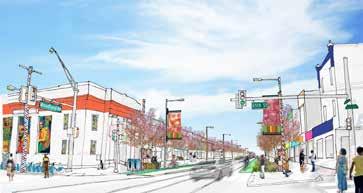
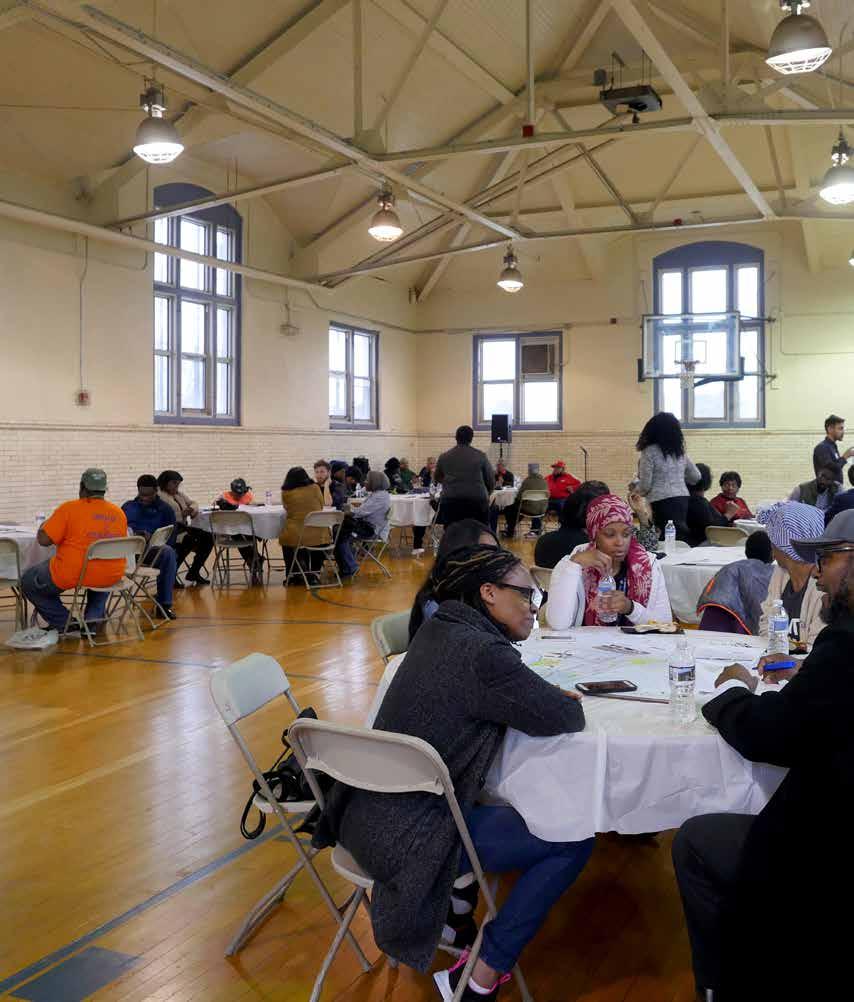
Residents were front and center during the planning process where their opinions, experiences, and preferences shaped the plan. They served in leadership roles on every committee and task force. A summer festival, leadership series, bus tour, and walkshop are just a few of the events that were designed to engage residents of all ages in the process alongside partners and stakeholders.

IN THIS SECTION:
Meet our team How our team is organized The process
They say it takes a village to raise a child. It certainly takes many dedicated partners and residents to create a visionary yet achievable neighborhood plan, particularly one that unites the desires and the will of such a large and established urban neighborhood. The Bartram Choice planning effort worked hard to bring together residents of the community living at Bartram Village and beyond with local partners and stakeholders to start to break down barriers and mend relationships. With so many passionate and devoted individuals and organizations working in the community to make it stronger and more vibrant, the planning process strived to share information and identify ways to enhance existing efforts and maximze the overall impact of limited resources.
Through a concerted effort, the planning process resulted in an aspirational vision with clear steps to follow and metrics to track progress. It is hoped that the good will shared and relationships formed or reestablished will continue to blossom so that the plan will be fully realized.
The Philadelphia Housing Authority (PHA) provides housing for nearly 80,000 people in the City of Philadelphia and is the fourth largest housing authority in the country. In this role, PHA develops, acquires, leases, and operates affordable housing for city residents with limited incomes. But PHA goes far beyond housing by providing education, training, services and other programs to help residents thrive and ultimately achieve self-sufficiency. These programs include free basic adult education, job training
programs computer skills, financial literacy, youth activities, and senior programs.
Pennrose was selected by PHA as the developer for Bartram Village because of its innovation, integrity and experience developing more than 200 similar properties. As one of the largest affordable housing providers in the region, Pennrose recognizes the impact it has on people’s lives and is committed to working side-by-side with partners, residents, elected officials, and public agencies to create exceptional living experiences.
PIDC was founded in 1958 by the City of Philadelphia and the Chamber of Commerce as the city’s public-private economic development organization. The non-profit jointventure strives to stimulate investment, support business growth, and foster developments that create jobs, revitalize neighborhoods, and drive growth to every corner of Philadelphia. In 2013, PIDC and the City of Philadelphia released the Lower Schuylkill Master Plan (LSMP). The Plan creates a framework to transition the 3,700-acre industrial corridor running along the Schuylkill River to the north and south of Bartram Village into a vibrant set of modern, competitive business campuses. PIDC is actively working to set the LSMP in motion and brought this experience and knowlege to the Bartram Choice plan as the co-chair of the Neighborhood Task Force.
Bartram Village has three resident council members— President, Vice-President, and Secretary/Treasurer—who form a direct link to residents of Bartram Village. All three members were deeply involved in the planning process as members of the Steering Committee and all of the Task Forces. They also served as neighborhood ambassadors. The Resident Council reviewed all of the ideas, materials, presentations, goals and strategies developed through
the planning process and provided feedback that was incorporated by the planning team before it was presented to residents or the community.

Residents of Bartram Village and the surrounding neighborhood were the focus of the planning effort and their participation was vital in shaping an effective plan. A concerted effort was made throughout the planning process to encourage Bartram Village residents and their neighbors to take an active part in the planning process. Special programs like the Neighborhood Leadership Series and the Artist in Residency program were specifically designed to give residents a broader understanding of how planning and development projects take shape in Philadelphia and how to share their voices and opinions with city officials. Bartram Village residents and their neighbors were members of the Steering Committee and Task Forces.
Bartram Choice was fortunate to have many partners involved with the planning process to help identify realistic opportunities and strategies. These partners served on the Steering Committee, Task Forces, and Action Activities Committee, and participated in our capacity building activities. The intention was to bring together all of these talented organizations to synthesize efforts and maximize the impact of our programs and resources.
▼
“It takes many partners and interested residents to create a visionary and achievable plan!”Residents, stakeholders and PHA staff on a tour of housing sites revitalized by PHA
The Bartram Choice Steering Committee (BCSC) served as the decision-making body for the Bartram Choice Neighborhood planning effort and was established to make sure that all policy and project decisions were wellinformed by the community. BCSC reviewed and approved the Transformation Plan priorities, early action activities, project design, community engagement and capacity building efforts. The BCSC is made up of representatives from PHA, Pennrose, PIDC, Bartram Village residents, neighborhood residents, and government employees (Philadelphia City Planning Commission, Department of Housing and Community Development, and the Office of Community Empowerment and Opportunity’s Place-Based Initiatives). Other members represent educational and workforce training facilities, community organizations, local business owners, and health institutions, including Bartram High School, Bartram’s Garden, Southwest Community Development Corporation, the Common Place, City Lights Network, ACANA, Southwest Philadelphia District Services, the Village, and 12th Police Precinct.
Three task forces focused on the main objectives of the Choice Neighborhoods Initiative—Housing, People, and Neighborhood. The task forces were responsible for identifying the goals for the plan and developing strategies to achieve the goals. The task forces also brainstormed ideas for early action activities to be completed during the planning process. The task forces were also responsible for proposing action activities to be completed when the planning process ends.
The task forces brought together professional partners, area stakeholders, business owners, non-profit organizations, Bartram Village residents and neighborhood residents. Each was chaired by professionals working at the city and neighborhood level. The intent was to combine the expertise of practitioners with the on-theground knowledge of community members while building a shared understanding of the possibilities and potential limitations.
▶
The Housing Task Force focused on developing a strategy to provide high-quality, well-managed, mixedincome housing that responds to the needs of the neighborhood.
▶
The People Task Force explored ways to help residents of Bartram Village and the surrounding community thrive. This included considering ways to expand access to effective education, meaningful opportunities for employment, quality health and wellness services, and well-designed, affordable housing.
▶
The Neighborhood Task Force identified ways to improve connections to basic services in the community such as grocery stores, banks, and a laundromat, doctor’s and dentist’s offices, a greater sense of safety, and overall appearance and character to attract public and private investment.
In addition to providing funds for the planning process, HUD awarded PHA with funding for Action Activities. Ideas for these activities come directly out of the planning process and are limited to physical improvement, community development, and economic development projects designed to jumpstart transformation of the neighborhood. These activities are to be realized in the year and a half following the completion of the neighborhood plan.
An Action Activity Committee was set up in summer of 2019, with Bartram Village and neighborhood residents and several planning partners. The Committee decided on criteria to evaluate the ideas submitted by the task forces. The Committee then assembled a long list of activities that were submitted to HUD for review in November 2019. With input from HUD, the Committee narrowed down the list and then each member voted on the projects to determine which action activities should be prioritized. .

With a population of nearly 40,000 spanning 2.78 square miles, the engagement strategy for the Bartram Choice effort aimed to connect with as many people as possible at a variety of locations, events, and times throughout the community. Transportation was provided for Bartram Village residents to all meetings not held on site. The engagement strategy was designed to provide residents of the Bartram Village and the broader community with opportunities to be active participants—by identifying priorities and shaping strategies that they could see themselves using and benefiting from. Hands-on activities were developed to collect feedback in different ways and to help give residents the tools and comfort level to participate and hopefully, to become champions of the plan.
Communication:
Spreading the word about Bartram Choice and sharing information in a timely manner was one of the biggest challenges of the planning process because of the size of the neighborhood. A website—BartramChoice.com—was set up at the start of the process to reach a wide audience. Acting as an information hub, the website hosts a calendar of events, meeting summaries, presentations, and photos, as well as contact information. In addition, information was shared through email and social media, as well as more traditional channels such as flyers, posters, news articles, and word of mouth.

▲
◀ Community Meeting 3, February 7, 2019



▼ Southwest Pride Day, 2018

Five large community meetings were held at key milestones throughout the planning process to share progress and gather feedback. The project kicked-offf with a festive meeting and interactive workshop at Kingsessing Recreation Center on April 24, 2018 that brought together Bartram Village and neighborhood residents with Councilwoman Jannie Blackwell, State Rep. Joanna E. McClinton, representatives of HUD, and many local partners.
On June 22, 2018, a Summer Festival at Bartram Village celebrated the launch of the needs assessment while residents of all ages enjoyed food, games, and entertainment.
At the Common Place on October 10, 2018, the planning team shared the results of both the Bartram Village Resident Survey and broader Community Resident Survey. Over 50 residents and partners engaged in lively discussions during a presentation and open house about the plan’s emerging themes and framework on February 7, 2019, at Ezekiel Baptist Church.
A final public meeting will be held in March 2020 to celebrate the plan’s completion and launch of the Action Activities.
The Bartram Village resident survey showed that most people get their news by word of mouth from family and friends as opposed to online. To increase participation in the planning process, the planning team identified seven Neighborhood Ambassadors—four who live at Bartram Village and three living in the neighborhood—to help get the word out to the community. These energetic ambassadors created a buzz about Bartram Choice by distributing flyers in their communities, sharing information about the planning process with their friends, neighbors, and networks, posting updates on social media, and encouraging people to become involved and attend meetings and events.

Luciana Boone has lived in Southwest Philadelphia for almost 20 years. In that time, she has taught at Tilden Middle School, operated a Family Child Care Home, and raised her children. She is very active in the community as a Block Captain, a panelist for the District Attorney’s Office Youth Aid Panel, and a graduate of the Citizens Planning Institute. Luci would like community members to be educated on the many resources available to them to make transformative generational changes. Her wish is for property values to increase and benefit the families who have raised children in the area.
Short-term changes she would like to see are safer streets and an increased level of pride for the area. “I have seen neighborhoods in Philadelphia change and wanted to be part of the change in my immediate community. I believe those who could be affected should be involved in the shift.”
The Needs Assessment launched during a Summer Festival at Bartram Village on June 22, 2018. Over 200 Bartram Village residents completed the lengthy survey that day! A total of 260 households (over 52%) filled out surveys by August 2018. The Festival brought neighbors of all ages outside to enjoy music, food, and activities for the kids such as painting and dancing.
To gather feedback from those who live, work or frequently visit the surrounding neighborhood, the planning team developed a shorter survey that launched in July 2018 and ran through September 2018. It was available online and on paper at over 20 nodes in the neighborhood including churches, libraries, and rec centers such as Grace Christian Fellowship, Paschalville Library, Southwest CDC, Rhythm & Brunch, and The Common Place. Eighty-nine residents completed this survey.

Separate reports with the full results of both surveys are posted at BartramChoice.com. As noted above, the findings were also presented during a Community Meeting and Workshop.

How we got the word out▼ Community Kick-Off Event on April 24, 2018 at the Kingsessing Recreation Center
Community members exploring the CNI and thinking about public spaces
Three focus groups were conducted between March and June of 2019. One focused on education, with representatives of local schools discussing issues such as literacy and bridging the basic skills divide. The second focus group discussed health, wellness, trauma, and healing. The third centered on employment, bringing together local community organizations working to improve job prospects for Southwest residents and begin to tackle issues like re-entry, green jobs, and skills development.
BARETEETH, the Bartram Village Community Center, and Youth HEALers Stand Up collaborated on a five-week arts program at Bartram Village during the summer 2018. The program involved discussions, photography, art and dance workshops, and rehearsals that explored the themes of home, displacement, and futurity, focusing on the participants’ current experiences with housing at Bartram Village.
The summer residency program involved five workshops that gave youth aged 7 to 17 the opportunity to take photographs for a visual time capsule of Bartram Village and to make t-shirts representing their collectivity. Youth also got to choreograph and perform a dance for the Stronger Youth Movements conference on August 18, 2018, in addition to writing and publishing a pamphlet about the present housing crisis at Bartram Village. Outside of the workshops, Bartram Village youth decided to meet an additional three times a week to allow more time to choreograph and rehearse their dance routine, produce the t-shirts and the pamphlet. Over 25 young residents of Bartram Village participated in the residency program.
Tracey Gordon has been a homeowner in the neighborhood for 24 years and a resident for 30. She is an active block captain and Ward Committee woman. While serving as a neighborhood ambassador for Philly 311 and organizing block clean ups, she was awarded the Philadelphia More Beautiful Clean Block Award. What excites her most about Bartram Choice is the opportunity to bridge the gap between the community and Bartram Village. Her favorite assets in the community are Cobbs Creek Parkway and Bartram’s Garden. One of her ideas for neighborhood improvement is to increase pride in the specific communities that the Bartram Choice neighborhood covers. Tracey was elected as Register of Wills for the City of Philadelphia in spring 2019.

▶
PHL + NYC Quality Affordable Housing Exchange: On July 26, 2018, several members of the planning team joined Bartram’s Garden and residents of the community on a one-day study tour of exemplary affordable housing developments in New York City. The tour explored case studies of housing created through inclusive design, highlighting public partnerships with community organizations. The tour also considered ways to integrate communitysupported services, the arts, public space, and other amenities into affordable housing developments.
▶ Walkshop: The planning team held a “Walkshop” for Bartram Village and neighborhood residents in April 2019. Members of the planning team joined two small groups of residents and neighbors on two walking routes through the neighborhood starting from Bartram Village. Participants were able to have informal conversations about the neighborhood in real time, highlighting favorite places, as well as obstacles, unsafe areas, vacant lots, and opportunity areas that might be addressed by the plan.

▶ Children’s Workshop: On July 1, 2019, the planning team held a creative workshop for Bartram Village children participating in the site’s summer camp. The first part of the workshop introduced the children to the field of planning and explored some of the issues the Bartram Choice plan is trying to address, including safe places to play. During the second part of the workshop, the children designed their own playground using art supplies and natural materials like sticks and stones, which resulted in a wide array of inventive creations. The children then had an animated discussion about where on the Bartram Village site they’d most like to see their designs. Lastly, they presented paintings that they had previously completed showing their vision for the future of Bartram Village. ▲ Neighborhood Walkshop ◀ Children’s workshop materials

▲
Turning to the experts to design new playspaces.
▶
Bartram Village children sharing their opinions on where playgrounds should go.


This popular series was designed for all Bartram Village and neighborhood residents to enhance communication and leadership skills, to meet neighbors with similar interests, and to learn how to take an active part in the Bartram Choice plan and other community planning and development efforts. Six two-hour sessions were held from November 2018 to February 9, 2019, at Bartram Village.


▲ (left) Learning how to handle difficult community decisions.
▲ (right) Neighborhood Leadership Series Celebration.
▶ (right) Neighborhood Leadership Series participants with speakers Dr. South and Chantay Love.
The sessions began with dinner from local restaurants and covered the following topics:
▶ Session 1: Right under our noses—the building blocks of change. This session examined ways to plan meaningful community development by mapping and building upon local assets and the passion and talent of area residents.
Speakers: Mary Morton, Urban Designer & Planner at WRT and Regina Young, Resident of Eastwick & Founder of Empowered CDC
▶ Session 2: Music to my ears—building consensus with your inside voice. This session explored planning as a shared problem-solving exercise, emphasizing ways to build consensus among different stakeholders and engage a wide range of ages and multicultural groups.
Speakers: Lamar Wilson, Wilson Associates
▶ Session 3: Planning in Philadelphia. This information-packed session provided an overview of the City’s vision for the future—Philadelphia 2035— and relevant district plans, and how city agencies and residents work together. Participants also learned about the Citizens Planning Institute (CPI), which introduces Philadelphians to city planning, zoning and the development process so that they can help shape change in their neighborhoods. Local CPI graduates also shared their experiences.
Speakers: Donna Carney, City of Philadelphia Citizen’s Planning Insitute; Martine DeCamp, Philadelphia City Planning Commission; Local citizen planners — Mark Harrell and Luci Boone
▶ Session 4: Change is good but so is affordability. With the recent attention Southwest Philadelphia is attracting, many worry about related issues of gentrification. This session explained the different tiers of affordable housing and how it is financed, and discussed strategies to preserve housing affordability long-term
S peakers: Ryan Bailey, Pennrose; Woo Kim, Principal/Urban Planner at WRT; Steve Kuzmicki, Southwest CDC
▶ Session 5: The power of design and nature [trauma and resiliency]. With trauma and mental health a large concern for area residents, this session began an important conversation about trauma, healing, and the connection between mental health and outdoor green spaces. Participants also discussed other holistic approaches to healing and coping with trauma.
Speakers: Eugenia South, MD, MSHP, University of PA; Chantay Love, Founder of EMIR Healing Center
▶ Session 6: Take the lead! The final session was led by long-time PHA Resident Council leaders who shared their experiences about coming together and speaking with one voice. This session coincided with a Bus Tour of three recently redeveloped housing sites owned by PHA.
Speakers: Asia Coney, PHA Resident Advisory Board
Afterwards participants joined one another for a final graduation celebration. Over thirty-two participants took part in the leadership series.



The vision for Bartram Choice plan centers around three themes: Connect, Live, and Thrive. These themes aspire to connect residents of the neighborhood to services, recreation, nature, and to each other, ensure the ability to live well, and provide opportunities for all residents to excel and thrive.
IN THIS SECTION: Plan framework Connect Live Thrive
These themes create the framework for the Bartram Choice Neighborhood Plan: Connect, Live, and Thrive.
The Bartram Choice Plan is sharply focused on CNI’s core goals of housing, people, and neighborhood, which are folded into the themes of Connect, Live, and Thrive.
The Bartram Choice neighborhood has several parks and recreation centers, active commercial corridors, and an expansive public transit system, but the physical connections from Bartram Village to many of these resources are limited to three streets that cross over the rail lines. The actual crossings are open, overgrown, and unsafe. In one location at 58th Street, the freight rail line crosses at grade with just a simple gate protecting pedestrians.
One of the many advantages of an urban location like this is that a car is not necessary for daily needs. Schools, doctor’s offices, a library, parks, and basic services are within walking and biking distance of Bartram Village. But the pedestrian experience is hampered by poor lighting, litter, vacant buildings and lots, crumbling sidewalks, scrapyards, and in some areas, industrial activity. Hard-tosee markings and unprotected bike lanes also discourage biking. A cleaner, safer, and more attractive pedestrian network along major routes of circulation would enable residents to safely access and take advantage of available services and amenities. This same network would help all neighborhood residents move more securely within the neighborhood and improve their access to the waterfront.
Everyone deserves the right to live a physically and mentally healthy life. Bartram Village residents and their neighbors enjoy a relatively high rate of health insurance. Yet they also experience high incidences of asthma, elevated blood pressure, and depression/anxiety/posttraumatic stress. Access to healthy, affordable food and safe places to exercise are also limited. Bartram Village residents and their neighbors are in great need of the piece of mind that comes with safe, secure, affordable housing; fresh, nutritious food; inviting spaces to walk and exercise without fear; and resources to heal the body and mind.
Southwest Philadelphia is a well-established community near significant employment centers and anticipated economic investments. Yet factors such as low-performing schools, limited educational attainment, low literacy levels, and limited access to technology make it difficult for residents to gain the skills necessary to obtain meaningful employment or participate in these developments. There are exciting signs of improvement among Bartram Village high school students who are going on to twoand four-year college degree programs. But it is crucial that a local job training and employment ecosystem be in place to foster confident, skilled residents who can achieve self-sufficiency and take part in the economic developments happening nearby. It is also important for the neighborhood to thrive by celebrating its history and culture, beautification efforts, expanded services, and welcoming gateways.
Create an inviting community that is clean, green, and safe with beautiful, active public spaces. Connect people to these places; to nature and recreation; and to each other.
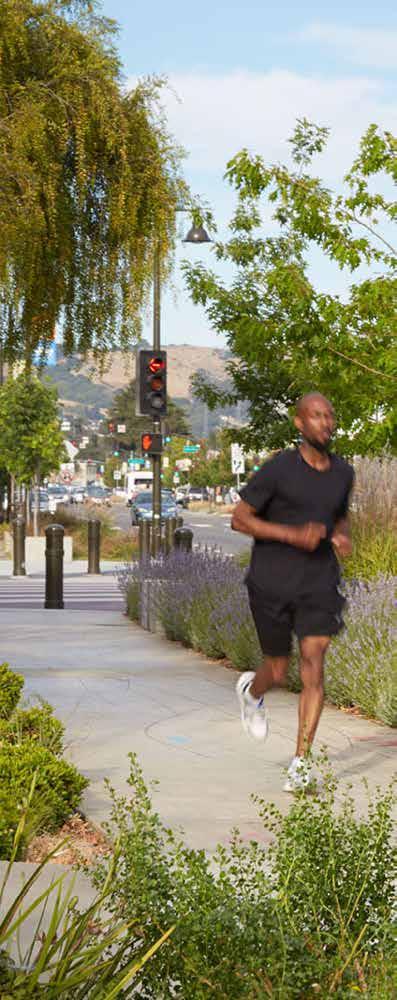

Green spaces and civic places are an important part of a vibrant neighborhood. They contribute to urban life by providing recreation opportunities, encouraging healthy lifestyles, enabling socialization, and connecting residents to one another. Southwest Philadelphia has a variety of unique open space and recreational assets—recreation centers, Bartram’s Garden, the Schuylkill River, Clark Park, Woodlands Cemetery—offering residents an exciting mix of experiences.
Feedback from residents makes it clear that while they value these facilities, it is often difficult to get to them, and distances between them sometimes stretch to a mile or more. These assets function more like green oases amid a sea of concrete.
Conditions on streets like litter, lack of lighting, poor sidewalks, and vacant lots make it unsafe and less enjoyable to walk, which is how the majority of residents get around. What’s more, because of the rail lines connections across the neighborhood are limited, it is essential that the few connections that do exist are easy and enjoyable to navigate as well as clean and safe.
The vision is for a safe, green, and beautiful network of streets and public spaces that connect residents to the many assets, amenities, and resources in the neighborhood. New open space amenities on the Bartram Village site will expand recreation offerings. Safety will be prioritized and enhanced through physical investments in street safety and wayfinding. These investments will create a model for other parts of the city on how to increase tree cover, combat urban heat island effect, lessen health issues like asthma, and improve air and water quality while beautifying and connecting the neighborhood. .
Goal 1
Develop a clean and green network of streets along primary circulation routes that connect major services, amenities, and green spaces to Bartram Village and the waterfront. ▶ Goal 2
Foster a safe neighborhood day and night for residents of all ages. ▶ Goal 3
Create a healthy outdoor environment that promotes physical exercise, social experiences, and wellness. ▶ Goal 4
Enhance the existing transportation network through safe street crossings, trail connections, and increased walkability.
This map shows the ways in which the CONNECT theme will physically transform the neighborhood through safer and more beautiful connections and revitalized open spaces.

Criss-crossing railroad lines in Kingsessing and Southwest Philadelphia make it difficult for residents on foot, bike and even in a car to get from one side of the neighborhood to the other.
Only a few streets such as 49th, 54th, 58th, and 65th extend from Gray’s Avenue and Lindbergh Boulevard to Woodland and Chester avenues, where the main commercial corridors are located. These happen to be the same streets that lead to the area’s major green spaces and civic places.
Children from Bartram Village (where half the population is under age 18) often walk by themselves to and from school and play spaces along these routes. Unsafe and unkempt rail bridges, an at-grade rail crossing on 58th Street, poor sidewalk conditions, and few trees detract from the pedestrian experience.
Because these major routes are widely used by Bartram Village and neighborhood residents to navigate their daily activities, it is crucial that these routes are clean, safe, and well-lit.
To have the greatest impact, the Bartram Choice plan has focused efforts on this primary circulation network, which we refer to as “Priority Streets” throughout the plan document.
This goal aims to add trees and greenery to improve the pedestrian experience while improving air quality, adding shade, and making the neighborhood more welcoming to residents and visitors alike. It also strives to target cleaning efforts and stablization initiatives along “priority streets.”
By creating a safe, walkable pedestrian network, Bartram Village residents and residents of the entire Choice neighborhood will be able to more easily cross the neighborhood, access services and public amenities, and interact with one another.
GOAL 1:
Develop a clean and green network of streets along main routes that connect services, amenities, and green spaces to Bartram Village and the waterfront.

Data shows that Southwest Philadelphia generally has much less street tree coverage than other nearby areas of the city. In December 2019, Philadelphia launched an Urban Forest Strategic Planning effort. PHA will continue to work with the Department of Parks and Recreation to support this goal through the Strategic Plan. Additional greening efforts will be coordinated with the Philadelphia Water Department, where possible, to make these streets feel safer and well looked-after, while also improving air quality and managing stormwater.

Permeable, planted sidewalk bumpouts help to increase stormwater absorption on neighborhood streets.
A green screen to sheild the salvage yard; fence art, safer rail road bridge, and tree trenches transform 58th Street into a more welcoming corridor

In order to create a feasible yet impactful plan, we are focusing efforts on the following Priority Streets, which are referenced throughout the plan.
Grays Avenue (49th to Lindbergh Avenue)
Lindbergh Avenue (Grays Avenue to 58th)
Elmwood Avenue (56th to 58th)
54th Street (Lindbergh to Chester Avenue)
58th Street (Lindbergh to Chester Avenue)
49th Street (Grays to Chester Avenue)
Woodland Avenue (48th to 58th)
Chester Ave (48th to 58th)
Add trees, greenery, and green stormwater infrastructure to “priority streets.”
Complete Streets are designed to accommodate everyone and ensure safety for all, including pedestrians, bicyclists, motorists, and transit riders, regardless of age, ability, or mode of transportation. While each Complete Street may look different, they may include: sidewalks, bike lanes, dedicated bus lanes, comfortable and accessible public transportation stops, frequent and safe crossings, curb extensions, accessible pedestrian signals, and more. These allow people to easily cross streets, bike to work, and wait safely and comfortably for public transportation. In June 2009, Philadelphia was the first city in Pennsylvania to establish a complete streets policy and in 2013, the city adopted its Complete Streets Handbook. The
Handbook acts as a guide for different members of the public: community groups looking to improve their streets, developers building new projects, and for city employees designing new streets.
Green City, Clean Waters is the City of Philadelphia’s $2.4 billion initiative to reduce stormwater pollution and runoff through green stormwater infrastructure (GSI), led by the Philadelphia Water Department (PWD). The initiative’s goal is to reduce the stormwater pollution entering the city’s waterways by 85 percent by 2035. Since the program’s adoption in 2011, PWD and private developers have added over 1,100 green stormwater tools to the city; these tools include stormwater planters, porous pavement, rain barrels, stormwater bump-outs, and more. Green stormwater infrastructure has the potential to create community green space, revitalize vacant lots, and achieve other economic, social, and environmental benefits. So far, PWD is bringing GSI improvements to Kingsessing Recreation Center, Myers Recreation Center, and other areas of Southwest Philadelphia. Residents can get involved as well, through PWD’s Rain Check program, which provides qualified residents with a free rain barrel to capture stormwater runoff from roofs.

70% of BV residents rated cleanliness and air quality as fair to very poor
85% of neighb. residents rated cleanliness and air quality as fair to very poor
How would you rate the health of the neighborhood?
Wherever you see “What we heard” in the plan, it represents the findings from the Needs Assessment Surveys. Unless specifically noted, these infographics summarize the feedback provided by Bartram Village residents.
Which of the following issues negatively impact the neighborhood?
BV Residents:
#1 #1
Litter in public areas
Neighborhood Residents:
#2 #2
Dumping of trash in neighborhood Lighting
Litter in public areas
#3
Strategy B:
Unsafe street crossings on Lindbergh Ave
#4 #3
Sidewalk conditions
Poor lighting
Work with Clean PHL litter program to provide additional trash cans and organize regular neighborhood clean-ups of priority streets.
Again and again residents of Bartram Village and the Choice neighborhood noted what a problem litter is in their community. This goal strives to increase the number of trash cans along priority streets by 20 and will aim to organize two neighborhood clean up days each year.

Having more trash cans at regular intervals along priority streets, particularly at transit stops, will help address this chronic issue. Regular clean-ups will engage the entire community and encourage residents to take ownership of the beautification of their neighborhood.
▼ Litter often found in the neighborhood
Kingsessing Rec Center
21% of BV residents feel safe at night
Less than 20% of BV residents feel safe allowing children to walk and play outside
44% of BV residents feel safe during day
22% of BV residents think it is safe for seniors
Clean and green highly visible vacant lots along priority streets.
Vacant or unmanaged land and buildings can attract litter and crime, detracting from the surrounding area and making people walking and living nearby feel unsafe. Cleaning up these lots sends a signal that the street and its properties are being cared for. One of our planning partners, the Pennsylvania Horticultural Society (PHS), is actively addressing vacant lots across the city through its LandCare Program, which cleans, greens, and maintains these lots.
PHS currently maintains 60 of the 125 vacant lots in the Bartram Choice neighborhood. Over the next 5 years, it will strive to inrease this total to 90 lots with an emphasis on priority streets and highly visible locations.

▼ A vacant lot in the Choice neighborhood “cleaned and greened” by PHS
CleanPHL is the City of Philadelphia’s initiative to make a cleaner, lowerwaste city. Aside from the litter index, which provides an estimated litter count and rating for different areas of the city, CleanPHL also develops Neighborhood Litter Control Plans. These plans are developed through the Streets Department in partnership with other City agencies and nonprofit partners, and Southwest Philadelphia was the first neighborhood to pilot the neighborhood litter control plan in March 2018. The plan was created in partnership with the Southwest Community Development Corporation and other organizations serving the area, focusing on 49th to 72nd Streets between Lindbergh Avenue and Woodland Avenue.
A large part of enhancing the connectivity of a neighborhood is making sure residents feel safe utilizing the connections that are available to them. Safety is a large concern for both Bartram Village and neighborhood residents. Through the needs assessment and task force discussions, residents expressed particular concern for the safety of children and young people as they walk to and from neighborhood destinations like schools and play areas. Seemingly minor changes like adding more street lights, and using design principles to ensure public spaces are visible and well-managed without dark pockets, go a long way to making residents feel safer moving about their neighborhood.
Residents strongly expressed a desire for more lighting on the grounds of Bartram Village and in the immediate streets surrounding the community, particularly to enhance the safety of the many children who live there and walk to and from daily activities.
Clear sightlines, windows overlooking walkways and public spaces, and lighting will be carefully integrated into the design of the redeveloped Bartram Village site to enhance safety.
Under the direction of planning partner PIDC, additional street lighting is proposed along Grays Avenue and Lindbergh Boulevard from 49th Street to 58th Street as part of pedestrian streetscape improvements. It is hoped that construction could begin in 2021.
Upgrade and add additional lighting within redeveloped Bartram Village and on Lindbergh and Grays avenues from 49th Street to 58th Street.
How would you rate the safety of the neighborhood?
84% of neigh. residents rated safety fair to very poor
73% of BV residents rated safety fair to very poor
Strategy B:
Add security cameras and signage indicating
presence within Bartram Village, especially where kids get off school bus and interior of site.

Residents of Bartram Village feel additional security cameras and signage indicating the area is being monitored will make them feel safer when moving around the site.
When the Bartram Village site is redeveloped security cameras and signage will be installed as part of a comprehensive safety plan.
▼ Pedestrian-scale lighting can enhance safety while creating a sense of place

#2
better street and site lighting
#1 more security cameras in public spaces #3 less trash and illegal dumping
What would make you feel safer?
The layout and design of the reimagined Bartram Village site incorporates the principles of Crime Prevention Through Environmental Design (CPTED) to deter crime. These strategies include designing streets to increase pedestrian and bicycle traffic; orienting buildings with windows overlooking sidewalks, parking lots, and play spaces; and using landscaping and trees to make the site more inviting.
New buildings proposed along Lindbergh Boulevard will be placed near the street edge with attractive storefronts to invite more activity.
▼ Windows and benches increase “eyes on the street” and increase safety
their
Incorporate “design for safety” principles into the redevelopment of Bartram Village and future development along Lindbergh Boulevard and Grays Avenue.
Do you (BV residents) agree with the following statement: “I feel safe allowing children to walk/play outside”
20% yes 35% sometimes 45% no
PHA has partnered with the Community Forgiveness and Restoration Initiative (CFR) to bring its unique program to the Kingsessing/Southwest community through the conveyance of a vacant office facility located on Springfield Avenue. The facility will be converted to classrooms where mentors and instructors will work with returning citizens around soft skills training, computer literacy, personal coaching, family reconciliation, and other supports to enable them to transition back into the community and move forward with their lives.
DHCD will work with the City’s Commerce Department to promote the Business Security Camera Program to business owners along the neighborhood’s commercial corridors. This program encourages Philadelphia businesses and commercial property owners to install surveillance cameras, making areas safer for shoppers and the community while growing their vitality and economic performance.
The program reimburses up to 50% of the total cost of eligible equipment. The maximum award for a single
commercial property is $3,000. There is no maximum for business associations or community-based organizations installing multiple cameras in a business district. Participants must register their system online with the Police Department SafeCam program. SafeCam enables Police investigating a crime to quickly determine if there is a camera located nearby.
PHA is in the process of reorienting its Public Safety Department to a community policing model that promotes proactive crime prevention, problem-solving, and community collaboration. PHA has contracted with national public safety experts (Robert Wasserman and Robert Haas of Hilliard Heinze) to develop the program and provide technical assistance and training.
Assigned PHA officers will be trained and rebranded as Public Safety Officers (PSO) to “own” the development from the perspective of safety and security. They will be trained in community organizing, meeting facilitation, problem solving, and related areas to help build relationships of trust with residents. Training will also focus on identifying PHA, City and other resources that can be focused to proactively address emerging public safety issues. They will work with the Resident Council, property management team, and PHA Resident Programs & Partnerships staff to identify problems related to crime, perceptions of safety, and other issues of concern to residents, and then work collaboratively to identify strategies to address these concerns.
Strategy D:
Increase support systems for returning citizens to assist in their transition back into the community and prevent recidivism.
Promote technology as a Tool for Crime Prevention.
What would make it easier for BV residents to exercise?
New local gym/ indoor fitness locations nearby Greater feeling of safety
Better, brighter lighting on main streets
#1 #2
#3

Throughout the planning process, both Bartram Village and neighborhood residents expressed a desire for more and safer ways to lead healthy, active lifestyles.
This goal aims to make it easier for residents to be physically active by taking advantage of nearby recreational facilities and to support their overall health and wellness.
Which amenities are needed most in the neighborhohood?
#1 a library
#2 a playground/ tot lot
Integrate a variety of “play” spaces for all ages on the Bartram Village site.
The vision for the reimagined Bartram Village site responds to residents’ desire for a playground or tot lot and for fitness locations nearby. It includes a variety of active play and exercise spaces for residents of all ages. These spaces will support physical and imaginative play, as well as adult recreation so that adults can participate and/or socialize while keeping an eye on children playing nearby. Special programming will encourage residents to use the spaces and to build a sense of commnunity.
The design also integrates more passive, contemplative spaces for reading, yoga or meditation. Homes are designed with windows overlooking these green spaces with clear sightlines to provide additional safety.
indego
Indego is Philadelphia’s bikesharing system. There are three different pricing schemes— monthly, yearly, and daily passes— with a subsidized option for those with Pennsylvania ACCESS cards. Currently, only one Indego station at Clark Park serves the Bartram Choice neighborhood/ Southwest Philadelphia, however, the 2018 Indego Business Plan identifies certain areas of the Choice neighborhood as potential locations for future stations. One of Indego’s goals is to expand from its current 121 stations to over 250 stations, allowing for expansion into neighborhoods that are not currently served and with a focus on low-income areas and communities of color. Potential new locations for stations include Bartram’s Garden, Kingsessing Recreation Center, and Myers Recreation Center.

Strategy B:
Expand bicycle infrastructure and amenities both at and near Bartram Village, including bike parking and storage, trail connections, and a bikeshare station.
There are several on- and off-street trails that pass through the Choice Neighborhood, including Bartram’s Mile, which will soon connect to the Schuylkill River Trail, and the 58th Street Greenway, which brings people to the Cobbs Creek Trail further west. But these trails are not heavily used in part because most are on-street, unprotected, and not clearly marked.
The city’s Office of Transportation, Infrastructure, and Sustainability (OTIS) is currently conducting public outreach in anticipation of streetscape improvements along Grays Avenue and Lindbergh Boulevard in the next few years that propose adding a two-lane protected bike trail. The redeveloped Bartram Village site will support these improvements and strengthen the connection to the Schuylkill River Trail along 56th Street. The redeveloped site will also include bike storage facilities.
In addition, PHA, Bartram’s Garden, and the City’s Office of Transportation, Infrastructure, and Sustainability have discussed adding Bartram’s Garden to the list of sites to be considered for an INDEGO bike share station during the next funding cycle. These interventions are meant to make it much more convenient for Bartram Village and area residents to take advantage of these nearby assets.
What would make it easier for you to exercise? #1 new Local Gym / Indoor Fitness locations nearby
#2 a greater feeling of safety
#3 better, brighter lighting on main streets
Strategy C:
Through the Needs Assessment, the Leadership Series, and Task Force meetings, it became clear that Bartram Village residents love spending time at Bartram’s Garden but it also became evident that many residents do not feel comfortable walking around outside. When asked what would make it easier for them to exercise, the top three responses were “a greater sense of safety” and “better, brighter lighting on main streets” (in addition to a gym nearby).
This strategy embraces the principles of Crime Prevention Through Environmental Design (CPTED) by encouraging more pedestrian activity and takes advantage of the much loved nature paths of Bartram’s Garden and Schuylkill River Trail next door.
The design of the redeveloped Bartram Village provides a series of interconnected sidewalks and paths that form walking loops of different lengths. Residents can choose their own distances and destinations. Weaving the walking paths into the major circulation routes will ensure that buildings are oriented with views of the paths, placing more “eyes on the street” and increasing residents’ sense of safety.
47% of BV residents have tried walking, biking, or jogging along the Schuylkill River Trail
60% of BV residents rated the quality of the neighborhood for walking as fair to very poor
81%
BV residents report never having taken a fitness class at Kingsessing Recreation Center
Create safe, well-lit walking loops of different lengths throughout Bartram Village and connecting to Bartram’s Garden and the Schuylkill River Trail with wayfinding and mileage signage.
With efficient trolley access bringing people to and from Center City and points beyond, to the beautiful trail system along the Schuylkill River, to the fact that most Bartram Village residents report walking as their most common form of transportation, Southwest Philadelphia is a multimodal neighborhood in terms of how residents get around. But in many cases, safety and quality issues impede the experience of all these forms of transportation.
Poor sidewalk conditions, trolley stops where cars are tempted to pass while passengers board or exit, and inconsistently marked bike lanes on major streets are areas of concern for residents. Helping to address these issues through an inclusive approach to mobility will enable residents to get where they need to go faster and more safely. It will also improve the commuting options and experiences of the many expected employees travelling to the future innovation hubs located directly north and south of Bartram Village.
What is your primary form of transportation?
Throughout the Choice neighborhood there are stretches with crumbling sidewalks that make navigating the streets challenging. The plan would like to advocate for sidewalk repairs along priority streets to re-establish a safe pedestrian network. Many of these improvements, however, will have to occur through redevelopment. For example, when Bartram Village is redeveloped, sidewalk improvements will be integrated.
Which trolley stop do you use most often?
GOAL 4:
Enhance the existing transportation network through safe street crossings, trail connections, and increased walkability.
sidewalk conditions on priority streets.
▲
Street furniture, trees, and planting beds can help increase safety at key crossings
Strategy B:
Avenue from 49th to 58th streets.
Bartram Village residents regularly walk along Lindbergh Boulevard and Grays Avenues to get to destinations in the neighborhood. Many of these blocks are lined with industrial and auto-related activity, and the wide road conditions attract fast-moving car traffic that frequently darts around stopped trolleys. These combine to make a very unfriendly pedestrian experience.
Throughout the Bartram Choice planning process, residents of Bartram Village and the neighborhood, as well as area stakeholders repeatedly mentioned concerns over pedestrian safety, especially for the significant population of children who live in the neighborhood and walk to area schools. Many children are often unable to take advantage of recreational and community facilities and programs due to safety concerns.
Mapping “High Injury Network (HIN)” streets in Southwest Philadelphia (as identified by Vision Zero) shows that there is good reason for concern. All of the major east-west cross streets are part of the HIN as is Lindbergh Boulevard and Woodland Avenue. By focusing efforts on these “priority streets”, we hope to improve safety for all and support the goals of the City’s Vision Zero.
One way to improve conditions for walkers is through safe, well-marked pedestrian crossings, curb bump-outs, and green planted buffers.
Vision Zero is a strategy aimed at eliminating all traffic-related deaths and severe injuries, while increasing safety, health, and mobility for all.
It was first adopted by Sweden in 1997 as a national policy. Now many states in the U.S. are adopting Vision Zero policies.
Successful Vision Zero programs recognize that increasing the number of people walking and biking makes these activities safer, and at the same time improves the health of a city.

Philadelphia has developed a three-year action plan that focuses on a “High Injury Network.” This Network was developed with data on reportable crashes in Philadelphia from 2012-2016, gathered from PennDOT. Data used were only for crashes that resulted in a fatality or significant injury.
To learn more about Vision Zero and to take the pledge, visit: VisionZeroPHL.com

Add traffic calming elements and prominent pedestrian crossings along Lindbergh Boulevard and Grays
This strategy proposes temporary short-term interventions such as painted crosswalks as an Action Activity. It also strives for more permanent interventions as part of anticipated improvements to Lindbergh Boulevard and Grays Avenue by the City’s Office of Transportation, Infrastructure and Sustainabilty, and PIDC.
When the Bartram Village site is redeveloped, a gateway at 56th Street will integrate a pedestrian- and bikefriendly intersection. It is also hoped that through Trolley Modernization, longer-term improvements could be made to increase safety for trolley riders entering and exiting vehicles, as well as pedestrians, cyclists, and motorists.
One idea that was welcomed by a variety of stakeholders during the planning process was to create a shelter that could integrate and celebrate the neighborhood’s culture, assets, and/or history and project the area’s unique identity. For example, integrating a green roof could support the pollinator corridor that the John Heinz Wildlife Refuge and Audubon Society are working to establish along Lindbergh Boulevard and tie into Bartram’s Gardens. Interpretive information could be included to explain the features along with descriptions of upcoming events.
Additionally, the safety and usability of the 56th and Elmwood Avenue trolley stop will be greatly enhanced by the transformation of the 56th Street intersection into a major gateway into Bartram Village with a signalized traffic stop and well-marked pedestrian crossings and bicycle infrastructure.
According to the Needs Assessment, these trolley stops are the most frequently used by Bartram Village residents. They are also important neighborhood stops for their proximity to Bartram’s Garden, the waterfront, and the Richard Allen Charter School. Given the anticipated development along the waterfront by PIDC, these stops have the potential to become even more heavily used.
Currently, amenities at these stops are limited to a bench at the 54th and Lindbergh Boulevard stop. It is hoped that in conjunction with the Trolley Modernization process, improvements can be made to improve the comfort and safety of passengers waiting for trolley service.
The 58th Street Greenway is primarily a separated bike path stretching from Bartram’s Mile to the Cobbs Creek Trail with some on-street segments. Adding signage, greening, and better bike lane markings along the trail will enhance the overall connectivity of Southwest Philadelphia to various open space assets and other trail systems.
Enhance the safety and comfort of the trolley stops at 54th and Lindbergh Boulevard and 56th and Elmwood Avenue.
Improve and restore bike lanes on Grays Avenue & Lindbergh Boulevard (from 49th to 58th streets) and improve the 58th Street Greenway.
This map shows streets identified by Vision Zero as part of its High Injury Network (in pink). Many of these are also identified as “priority streets” in our plan, which we would like to see cleaned, greened, better lit, better marked, and made much safer for pedestrians.

Create an environment that fosters the health and wellness of all residents of all ages, through healthy and affordable housing, access to medical services and nutritious food, and to spaces that heal the mind and body.
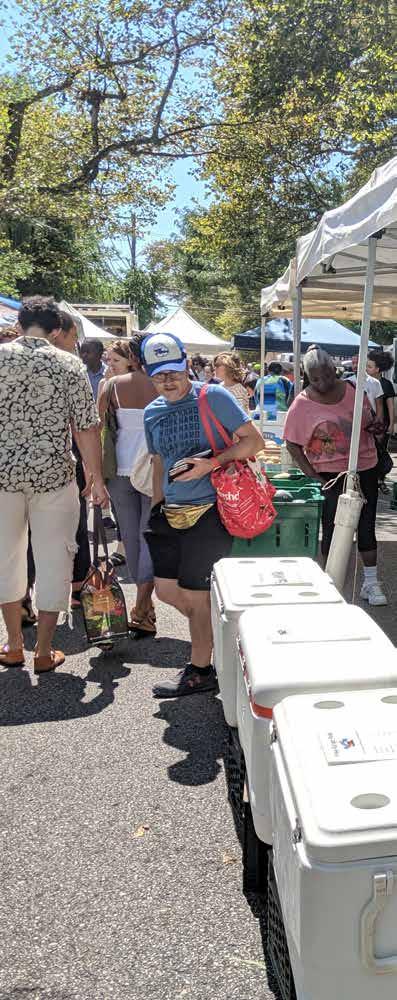
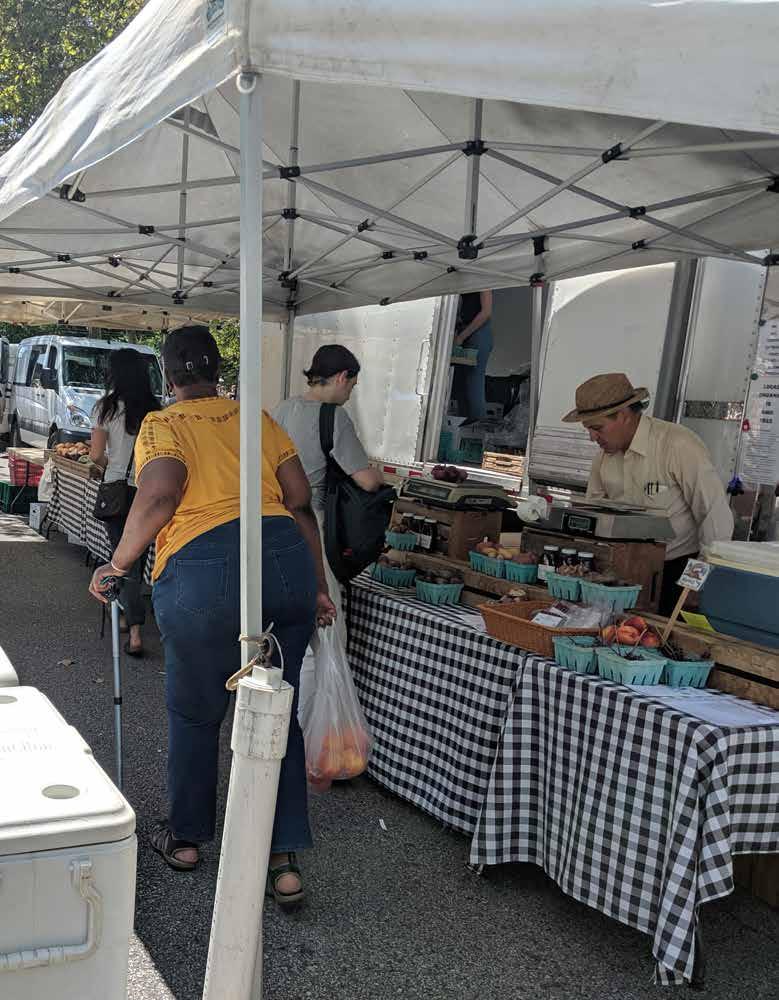
Home is home. A place where people live and come back to each day. It should be safe, welcoming, and secure; a comfortable place to recharge, gather strength, and find support to be able to live life to the fullest. But at Bartram Village and in the Bartram Choice neighborhood, residents worry about the condition of their housing and mounting development pressure. They are also deeply concerned about their safety and that of their children. Incidents of crime and trauma run high. These factors are reflected in the health of residents, many of whom experience high blood pressure and anxiety, depression, and post-traumatic stress.
The vision for the reimagined Bartram Village site is to create not just shelter but a beautiful, holistic healthy community that is carefully knitted with nature. Bartram Village will become a vibrant community that will promote physical activity and social interaction. It will improve access to medical services as well as affordable nutritious food. In turn, Bartram Village will enable residents to take advantage of the neighborhood’s many resources and live well!
Goal 1
Promote healthy, affordable housing and homeownership opportunities throughout the Bartram Choice neighborhood. ▶ Goal 2
Provide attractive, affordable housing in a healthy built environment at Bartram Village. ▶ Goal 3
Enhance the physical health of residents by expanding access to a wider range of quality health services. ▶ Goal 4
Establish an environment that promotes positive mental health and healing. ▶ Goal 5
Improve access to nutritious, affordable food.
This map shows the ways in which the LIVE theme will physically transform the neighborhood through better access to services and amenities that will help residents live healthy, full lives.
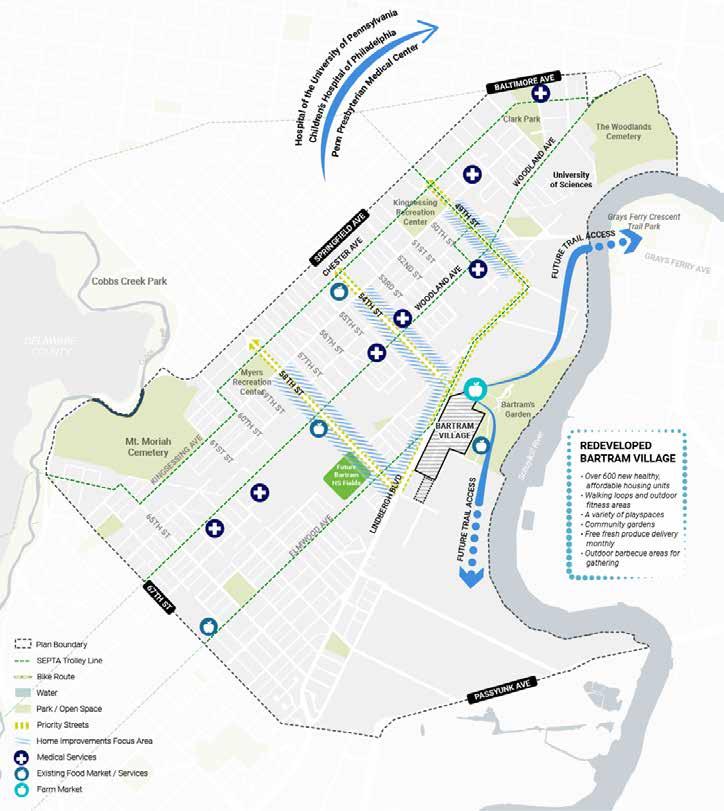
There are several desired outcomes of this goal. The first is to make homeownership a possibility for Bartram Village and neighborhood residents so that they may build wealth. Another is to help stabilize some of the existing housing stock by stabilizing existing housing on “priority streets” (identified in the plan under “Connect”). Lastly, this goal strives to support local entrepreneurs/developers and build local talent, capacity, and jobs.
What
In an effort to promote healthy, affordable housing throughout the Choice neighborhood, PHA is partnering with three community-based organizations on a demonstration program to renovate long-term vacant PHA-owned properties in the Choice neighborhood into affordable homeownership opportunities. These organizations include the Southwest Community 14% vacant housing units in the Choice Neighborhood
10% vacant housing units in Philadelphia
45% owner occupied in the Choice Neighborhood 55% renter occupied in the Choice Neighborhood 48% renter occupied in Philadelphia
GOAL 1:
Promote healthy, affordable housing and homeownership opportunities throughout the Bartram Choice neighborhood.
Strategy A: Launch a demonstration program to transform vacant properties owned by PHA into affordable homeownership opportunities for low- to moderate-income neighborhood residents.
types of housing do you feel are needed in the neighborhood? Renovated existing homes for homeownerhip
housing
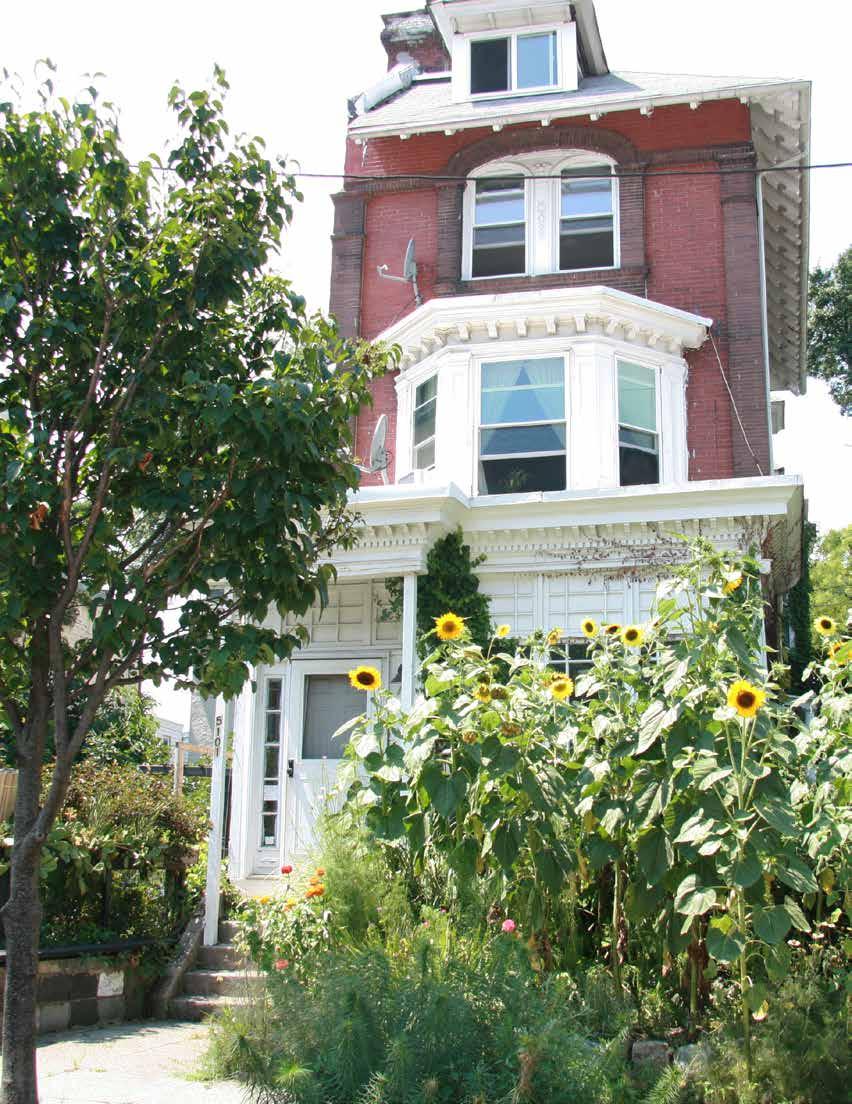
Many Philadelphians are struggling to pay for housing. This is especially true for the city’s lowest-income households. According to Housing for Equity: An Action Plan for Philadelphia, completed in 2018:
▶ 26% of Philadelphians are living in poverty
▶ There were 24,000 eviction filings in 2017
▶ There are 42,900 on the waiting list with Philadelphia Housing Authority
▶ 5,600 Philadelphians are experiencing homelessness
To address these needs, the Action Plan strives to provide new housing for 36,500 households and preserve 63,500 occupied homes over the next 10 years. In an area such as the Bartram Choice neighborhood where housing values are low compared to other parts of the city, the already vulnerable population is at risk for being pushed out of their homes and neighborhood by outside investors.
spotlightDevelopment Corporation in conjunction with their Jumpstart Southwest program; ACANA; and Southwest Philadelphia District Services.
Under this demonstration, these organizations will: ▶ Select a development team, ▶ Evaluate the rehabilitation needs of the properties, ▶ Develop a project scope and budget ▶ Negotiate with banks and lenders to secure project funding ▶ Oversee the rehabilitation of the properties ▶ Identify income-qualified households (<80% of AMI) to purchase the renovated homes
It is hoped that this program will increase the capacity of these organizations to implement their own development projects, eliminate blight associated with vacant properties, create employment opportunities for local workers, and create quality affordable homeownership opportunities so that low and moderate income households have the opportunity to reap the benefits of the improved neighborhood.
This map shows the location of individual properties owned by PHA that are targeted for redevelopment by local neighborhood organizations with the goal of providing affordable homeownership opportunities for local residents.

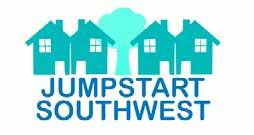
Jumpstart Southwest is a community development program designed to stimulate residential housing development and neighborhood revitalization while creating employment opportunities for local neighborhood residents. The program was first implemented by developer Ken Weinstein in the Germantown neighborhood of Philadelphia before expanding into other neighborhoods. In Southwest Philadelphia, Jumpstart is being led by the Southwest Community Development Corporation (SWCDC).
The program provides training, mentoring, networking, and financing options for aspiring local developers. Participants/mentees are neighborhood residents who are interested in learning about residential real estate development and how it can be used as a tool for change. The program aims to create opportunities for locals to invest and develop in their neighborhood, build wealth locally, support scattered-site rehabilitation, encourage a mix of affordable and market-rate housing, improve neighborhood safety through blight reduction, and help first-time investors. To date, Jumpstart Southwest has completed five cohorts.
These city-based programs are designed to assist homeowners in making critical repairs to their homes and investments in their properties. The goal is to help existing residents remain in their homes while protecting their investments, improving the quality of their lives, and also stabilizing the neighborhood.
PHA and its planning partners will work with the local Council offices to organize two blitzes per year with a focus on priority streets and other high profile locations.
Choice neighborhood and Bartram Village residents expressed a strong desire to reduce the number of vacant lots and abandoned buildings. By focusing on the major pedestrian corridors that cross the neighborhood and connect to primary points of interest, the plan hopes to create a network of safe streets that will improve the neighborhood’s appearance and safety.
DHCD will work with the local Council offices, Licenses & Inspections, and Community Life Improvement Program (CLIP) to stabilize 25% of the vacant buildings currently in the neighborhood, over five years.
Strategy B: Promote the Healthy Rowhouse Project and DHCD’s Basic Systems Repair Program by holding a biannual housing repair blitz and workshop for neighborhood residents, targeting homes along “priority streets.”
Strategy C: Identify vacant buildings particularly along priority streets and highly visible areas to be stabilized through Philadelphia’s Doors and Windows Ordinance.
What would make the neighborhood feel safer to you?
BV Residents:
Better street lighting #2
More security cameras #1
Neighborhood Residents:
Would you like to work toward buying a home in the next few years?
#4
Fewer vacant lots/ abandoned buildings #3
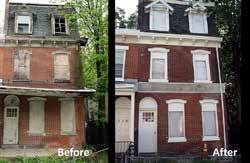
Less trash and illegal dumping
Less trash and illegal dumping #2
Fewer vacant lots/abandoned buildings #1
Better street lighting #3
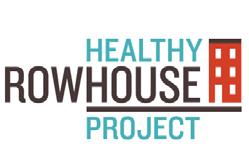
#4
More security cameras
The Healthy Rowhouse Project was founded in 2014 by the Design Advocacy Group and is dedicated to improving substandard conditions of rowhouses occupied by low- to moderate-income Philadelphians. Healthy Rowhouse works with the city and nonprofit partners to create cost-effective loan and grant programs to ensure residents can live in healthy homes. The program is also helping preserve the city’s iconic housing stock, preventing displacement, allowing seniors to age in place, creating jobs, and revitalizing neighborhoods.
69% of BV residents said yes
The Doors and Windows Ordinance is a code enforcement tool to tackle blight, crime, and health impacts related to vacant and abandoned buildings. It requires property owners of abandoned buildings on blocks where 80 percent of buildings are occupied to install working doors and windows in all structural openings, or to be subject to hefty fines. Owners who do not comply are subject to fines amount to $300 daily for each opening (window or door) that remains boarded or open. Since the program started in 2011, it has resulted in a significant decrease in crime.
JUMPSTART SOUTHWEST assisting aspiring local developers to invest in and rehab homes
The City of Philadelphia’s Basic Systems Repair Program (BSRP) provides free emergency repairs to correct electrical, plumbing, heating, structural, and roofing issues in eligible owner-occupied homes. Examples of issues include leaking or broken sewer and/or water lines, violations from the Water Department, Philadelphia Gas Works, PECO or Philadelphia Licenses and Inspections, roof leaks that have
PWD installing green infrastructure such as tree trenches to manage stormwater and improve quality of life
ASTHMA PREVENTION PROGRAM
improving physical conditions that trigger asthma
caused a 4-square foot or larger section of ceiling to collapse, and structural repairs to exterior walls.
Those who are eligible must: have not received BSRP services in the last three years; own and live in the single-family house; be current or under current payment agreement for both property taxes and water bills; meet the incom e guidelines; and not own any other residential property.
PHA working with local agencies to transfer vacant PHA properties into affordable homeownership opportunities
Restore, Repair, Renew is a new loan program to help Philadelphia homeowners access low-interest rate loans to invest in their properties.
These loans can be used for a wide variety of home repairs related to health, safety, weatherization, accessiblity, and overall quality of life. Eligible repairs include: roof, siding, foundation, window and door
replacement, electrical repairs, lead-based paint, and mold and radon mitigation.
The goal is to help residents remain in their homes, improve their homes, and strengthen their communities.
For more information, visit: http:// restorerepairrenew.org/
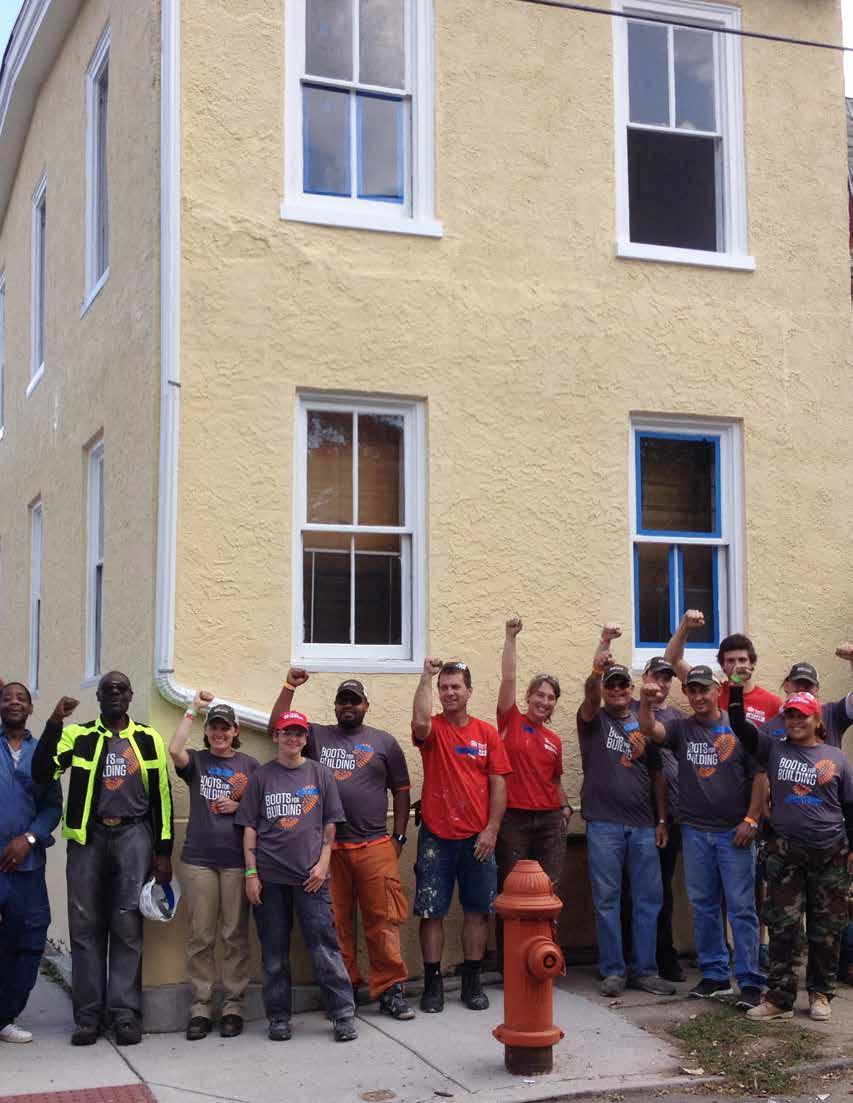
Tools being used in Philadelphia to make communities more resilient to forces of gentrification:
The City of Philadelphia uses several strategies to help communities like Southwest Philadelphia combat the negative impacts of gentrification:
Resident engagement – The Citizen’s Planning Institute (CPI) educates local residents, who want to make a difference in their communities, about the city’s planning, zoning, and development process and how they can shape and preserve their neighborhoods. Registered Community Organizations (RCOs) are community groups concerned with the physical development of their community who are informed of projects that will be reviewed by the Zoning Board or Civic Design Review Committee. They also hold public meetings that enable residents to provide feedback on planned development in their neighborhoods.
Home Repair – Recognizing the need to preserve the existing housing stock and to help keep residents in their homes, the City offers several programs such as the Basic Systems Repair Program that offer free emergency repairs.
Tax Relief – Another strategy to help keep homeowners in their homes is tax relief. These programs include the Low-Income Senior Tax Freeze for citizens of a certain age and income, and the Owner-Occupied Real Estate Payment Agreement (OOPA), which allows homeowners to make affordable monthly payments on property taxes that are past due.
Support for Renters – Among the programs available to assist renters are the:
▶
Shallow Rent Subsidy , which provides short-time assistance for a defined period of time.
▶
Eviction Prevention Program , which provides a tenant helpline, connections to legal services, and financial counseling.
▶
Small Landlord Loan Program is designed to preserve naturally occurring affordable rental housing in low-income neighborhoods by providing loans and technical assistance to those who own a total of four or fewer units that need health and/or safety-related repairs. All loans must be made to properties with rents that are affordable to households at or below 100% of Philadelphia County Area Median Income (“AMI”) with one third of these loans to properties leased at rents affordable to households at or below 50% AMI.
▶
Tax Relief for Landlords with Affordable Units
Strategically Investing along Transit Corridors – Philadelphia has an extensive public transit system that connects residents to employment and critical services. By investing in development near transit stops, the City is trying to remove barriers and provide residents of all incomes access to and between basic resources such as housing, education, employment, and supportive services.
Bartram Village currently sits on a lovely 22-acre site with huge old trees and a lot of greenery. The setting hints at the area’s agricultural past and is rare for such an urban setting.
The current site has 41 very long residential buildings with large empty voids between them resulting in outdoor spaces that are rarely used by residents.
The plan calls for the demolition of all of the existing buildings at Bartram Village over time with the goal of creating a welcoming, attractive, healthy mixed-income community that addresses residents’ concerns and desires for:
▶ A safe environment: Reducing the size of the buildings and orienting them to the street grid will put more eyes on the streets.
▶ A beautiful, green community: The design will preserve some existing trees and integrate a variety of green spaces to play, sit, meditate, grow, and enjoy. These spaces will extend the landscape of Bartram’s Garden while preserving and celebrating the area’s botanical history.
▶ Positive health and well-being: The design will promote physical activity and positive well-being with active playspaces, connections to bike/pedestrian trails, a healing garden, walking loops, and views of nature.
▶ Breaking down the barriers: Stronger connections to the surrounding neighborhood with clear entrances will make the site more inviting and a mix of housing types will encourage a greater mix of incomes.
Three larger multi-family buildings with ground-floor retail spaces and several walk-up apartment buildings will line the site along Lindbergh Avenue, creating an attractive street edge. The interior portion of the site will comprise a mix of stacked and traditional townhouses as well as walkup apartments.
Senior housing will be provided in two multi-family buildings along Lindbergh Boulevard with closer access to public transit. Accessible housing will be carefully integrated in a manner that is indistinguishable. Similarly, replacement units and market-rate housing will be located side-by-side.
GOAL 2: Provide attractive, affordable housing and a healthy built environment at Bartram Village.
Strategy A: Blend a variety of mixed-income housing types at Bartram Village to meet the needs of residents including accessible, hearing impaired, and senior housing that is indistinguishable from other housing on the site.
83% of BV residents would like to live in a townhouse
21% need accessible housing for those with disabilities, hearing and/or visually impaired
68%
BV residents wish to return to the site when redeveloped
56% would like to see redeveloped site with all affordable housing
10% of BV residents are 55 or older
44% would like to see redeveloped site with affordable and some workforce or mixed-income
Strategy B:
Use green building and landscape design practices to support the health and well-being of residents and the site.
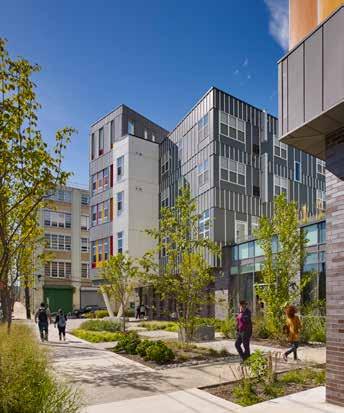
The design of the buildings and site at Bartram Village will integrate green building practices and low impact development to the maximum extent possible. Buildings will adhere to a nationally recognized green building rating system such as Enterprise Green Communities or National Green Building Standard. To combat asthma and protect resident health, green building materials will be used such as: low- and no-VOC paints, primers, coatings, adhesives and sealants; low- and no-formaldehyde cabinetry; environmentally-preferable flooring including Green Label or Green Label Plus-certified flooring and hard surface flooring in bathrooms; and wall and ceiling surfaces with mold prevention treatments.
The buildings will also be designed to maximize daylight and views of nature, and be arranged to promote physical activity in an effort to create a peaceful living environment. The site will incorporate a series of well-lit walking loops of different distances that connect to paths through Bartram’s Garden. Bike parking and storage will encourage residents to take advantage of the site’s access to the Schuylkill River Trail and 58th Street Greenway. An outdoor exercise area and variety of playspaces will encourage residents of all ages to get moving. Pocket gardens, a community garden, green gathering spaces and barbeque areas will offer many ways for residents to relax, reflect, recharge, and interact with neighbors. [See Blossom at Bartram for more details about the vision for the redeveloped Bartram Village.]
C: Integrate green infrastructure to manage stormwater, protect water and air quality, and celebrate nature.
Rain gardens, bioswales, and a green median are among the green stormwater infrastructure features that will be used to manage stormwater on-site. [See “Design character” in Blossom at Bartram.]
▼ Green infrastructure features benefit the environment while supporting resident health and well-being.
It is encouraging to see that a relatively high percentage of Bartram Village and neighborhood residents have health insurance and a primary care doctor (or office) to visit when in need of care. Four medical facilities are located in the community, which also borders the Hospital of the University of Pennsylvania and Children’s Hospital of Philadelphia campuses. Bartram Village residents who responded to the survey acknowledged that many medical services are available locally with a few exceptions— substance abuse support and domestic violence resources. Regarding the quality of basic care, the majority of Bartram
Village and neighborhood residents rated it as “good” to “very good.” However, the quality of more specialized services such as substance abuse and addiction, vision care, and mental health care were not rated highly.
Based on the survey findings, a bigger gap than the availability of services appears to be an awareness of health services and programs and ease of getting to medical facilities, which is a primary focus of the plan’s strategies.

Enhance the physical health of residents by expanding access to a wider range of quality health services.
How do you feel the quality of healthcare in the neighborhood could be improved?
More healthcare facilities in the neighborhood #1
A shuttle to major medical facilities #2
#3
Extended hours at health-related facilities in the neighborhood
90% of BV survey respondents have a primary care doctor
Strategy A:
Designate a “wellness area” in the redeveloped Bartram Village to host regular health-related events, including an annual health resource fair that promotes affordable health insurance and regular check-ups, and provides on-site vision, dental, and hearing screenings.
Our goal is to make sure Bartram Village residents are aware of area health services and programs and have access to medical insurance and providers. This strategy includes providing annual screenings timed in advance of the school year so that required health forms for children’s school activities can be completed. Aetna and Better Health Network have committed to offer these on-site services. In addition, we will strive to increase the number of Bartram Village residents with health insurance to 95% in five years.
Designing a multi-purpose space in the new Community Building on the redeveloped Bartram Village site will serve as an important resource for the entire community. Paying particular attention to features that could accommodate health screenings and provide privacy will inform the design, making it easier to hold regular health-related events.
Strategy B:
Coordinate quarterly on-site information sessions and forums with health partners to address specialized resident concerns including anxiety, domestic violence, and substance abuse.
These forums will address of the more specialized needs— anxiety, substance abuse and trauma—that residents noted in the survey are not readily available.
PHA will partner with EMIR, Anti-Violence Partnership of Philadelphia, and PHMC, to offer services including counseling, youth anti-violence programming, and victim services at Bartram Village. Programming will include yoga, meditation, health and wellness, victim services, and group therapy sessions. With a designated new wellness space in the new Community Center, partners will have the opportunity to offer one-on-one services on-site as needed.
Recognizing that many asthma triggers are caused by household issues such as mold, the Children’s Hospital of Philadelphia (CHOP) created the Community Asthma Prevention Program Plus Home Repairs program (CAPP+) as a part of the hospital’s Healthier Together initiative. The program aims to address the impact of unhealthy housing on pediatric asthma outcomes as well as reduce asthma-related emergency department visits and hospitalizations in West Philadelphia.
CAPP community health workers make an initial home visit to evaluate the house for eligibility for home repairs, which is then forwarded to the Philadelphia Housing Development Corporation (PHDC). PHDC then conducts a property assessment and provides basic repairs for the homeowner.
Strategy C:
In partnership with CHOP’s Community Asthma Prevention Program (CAPP), hold bi-monthly workshops and information sessions to increase awareness of air pollution and asthma prevention.
Asthma is the most common chronic illness diagnosed in children, and it’s the number one diagnosis for admission at the Children’s Hospital of Philadelphia. It was also the top health concern cited by Bartram Village residents in the survey. The CAPP program is designed to increase knowledge about asthma; improve the quality of life for children with asthma; and train members of the community to teach their peers about asthma. In conjunction with CAPP, PHA will hold information sessions 6 times a year at various location in the Choice neighborhood.
96% of BV survey respondents have health insurance 95% of BV survey respondents’ children have health insurance
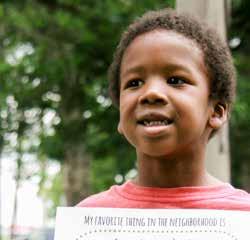
Top 3 health conditions facing BV residents
#2 Depression, Anxiety, PostTraumatic Stress
#1 Asthma / Breathing Issues
Violence and trauma and the stress and anxiety that results are major factors affecting the lives of residents in Southwest Philadelphia. According to the Philadelphia Police Department Crime Mapper, over 1,000 crime incidents occurred in Southwest Philadelphia in the first seven months of 2019. In 2010, the Robert Wood Johnson Foundation, Clinical Scholars at the University of Pennsylvania and the Health Annex in Philadelphia collaborated on a report, “Addressing stress and violence in Southwest Philadelphia,” that recognized the depth of this challenge and aimed to develop a model to support
those affected by violence. Throughout the initial phases of the Bartram Choice planning process, residents of all ages as well as educators, service providers, and public safety officials reiterated the persistent threat of violence and associated impacts on residents.
This goal aims to provide a variety of tools and resources to assist residents in coping with stress and trauma. It also seeks to create a soothing and peaceful environment onsite at Bartram Village.

Establish an environment that promotes positive mental health and healing.
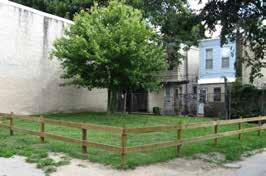
Conducted by Eugenia C. South, MD, MS; Bernadette C. Hohl, PhD; Michelle C. Kondo, PhD; John M. MacDonald, PhD; Charles C. Branas, PhD, published in the Journal of the American Medical Association, July 20, 2018.
A trial study exploring the effect of greening vacant land on mental health revealed the correlation between the greening of vacant lots and crime/ health indicators. In neighborhoods below the poverty line, when lots had greening interventions, the study showed significant social and mental health benefits: people were 75 percent more likely to go outside and socialize, feelings of depression went down by 41 percent, and selfreported poor mental health showed a reduction of almost 63 percent for those living near greened vacant lots. Findings also revealed that gun assaults decreased by 29 percent.
The greening interventions involved simple strategies such as trash removal and cleanup, planting new grass and trees, installing low wooden perimeter fences, and performing monthly maintenance.
The EMIR Healing Center and Anti-Violence Partnership of Philadelphia, which was introduced to the community through the Neighborhood Leadership Series, will provide alternative therapies and support to Bartram Village and community residents using a holistic and trauma-informed approach to violence prevention and trauma.
EMIR will offer workshops and services on-site once per month including individual and group counseling, stress management, grief and loss counseling, and techniques to strengthen families and commitments. Services may also include yoga sessions and musical therapy.
Encourage residents to attend onsite programming that promotes positive mental health and healing from trauma, including group sessions, mediation and yoga sessions, and individual counseling.
In addition to asthma/breathing issues, stress-related conditions round out the top 3 health conditions facing BV residents
#2 Depression, Anxiety, PostTraumatic Stress
#1 Asthma / Breathing Issues
#3 High Blood Pressure
There are many recent studies that demonstrate the wideranging benefits of spending time in nature. These include reduced risks of type II diabetes, cardiovascular disease, premature death, stress, and high blood pressure. This strategy is intended to create a variety of opportunities for residents and visitors to Bartram Village to spend time outdoors—in pocket parks, healing and community gardens, and other safe green spaces that allow time for exercise, social interaction, reflection, and enjoyment. Programming will be offered to activate these spaces and invite residents to use them regularly.
The design of the buildings will incorporate healthy building materials and take advantage of natural light and views outside to foster a strong connection between residents and nature. Features such as well-lit walking loops of different distances, outdoor gym equipment, a variety of play spaces, bike parking and storage, as well as connections to the Schuylkill River Trail will make it easy and safer for residents young and old to be physically active.
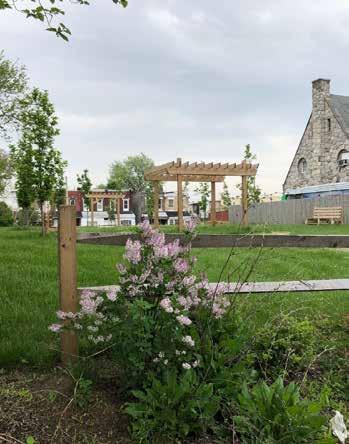
Strategy B: Integrate comfortable, green, and inviting outdoor spaces that invite meditation and foster healing.
Strategy C: Maximize daylight and views of nature, and promote physical activity through the design of the buildings and site at Bartram Village.
Bartram Village sits on the edge of a large section of the Choice neighborhood that is identified as either “low” or “no access” with regard to food security. This is compounded by the low incomes of Bartram Village and Choice neighborhood residents, making it very difficult to buy nutritious and affordable food.
Are there times during a typical week that you do not have enough food to eat?
Do you feel the following are available in the neighborhood?
44% of BV survey respondents said yes, at least once or twice a week
What are some of the reasons?
54% not enough money
31% too difficult to get to the store
12% not enough time to shop or cook
76% of BV residents think that a grocery store is “really” or “somewhat needed” in the neighborhood 60% of BV residents rated the availability and of highquality, affordable fresh fruits, vegetables and food in the Choice neighborhood as “fair to very poor.”
This map shows how easy or difficult it is to walk to a healthy food source depending on where you live in the neighborhood.
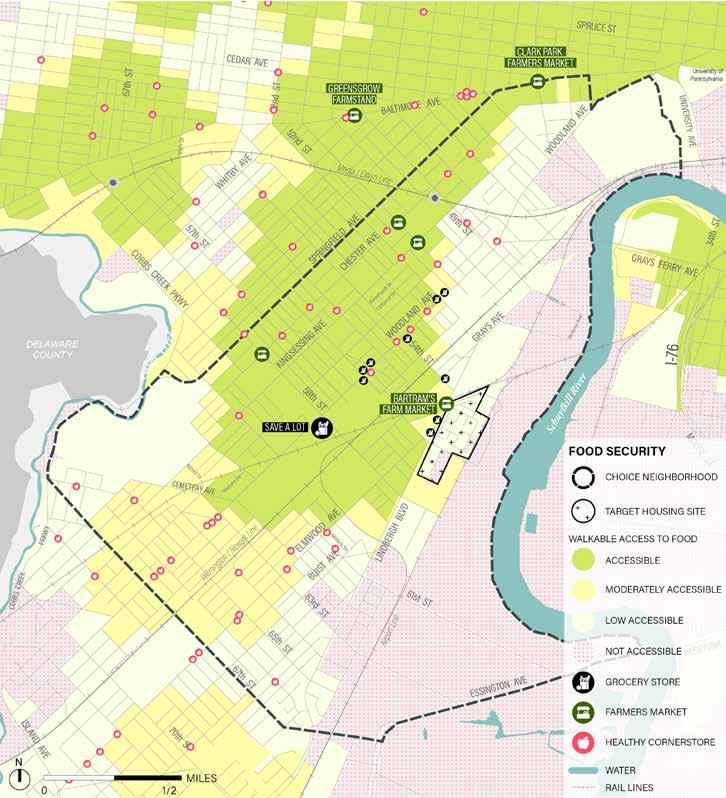
In the past year, Philabundance partnered with PHA to bring fresh fruits and vegetables to the Community Center at Bartram Village for residents to enjoy at least once a month.
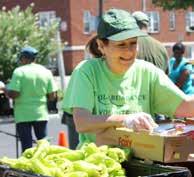
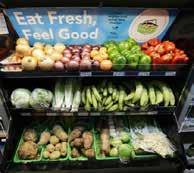
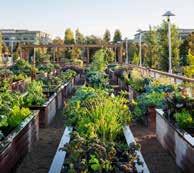


PHA will continue to partner with Philabundance and the Share Food Program to offer two new farm stands located near Bartram Village that offer fruit, veggies, meat and eggs. With the Share Food Program, PHA Coordinators will schedule new times and dates for fruit and veggie drop offs for the After School Program and seniors at Bartram Village. In partnership with the Department of Parks and Recreation, Bartram Village will also host the Winter Foods Program to support youth with meals during winter break, ensuring they have a nutritious meal during the holidays. Working with the Food Trust, residents will be able to attend workshops on how to prepare vegetables and produce through their Heart Smart Program.
Establishing a shared kitchen responds to several desires and needs expressed by residents throughout the planning process. Food service is one of the top fields in which Bartram Village residents are employed and the second most desired job training program Bartram Village residents expressed interest in the survey is in the field of cooking.
There was also a strong interest expressed by residents in task force discussions to have a shared Health Department-Certified kitchen in order to develop homegrown catering, baking, and food-related small businesses. This is a need that has been identified in the Choice neighborhood by organizations such as ACANA, which works closely with the large immigrant population in the community. Given the initial language and educational barriers that immigrants often face, small businesses such as restaurants and cooking provide employment opportunities that are more accessible.
Establish a monthly delivery of fresh fruit and veggies on-site at Bartram Village.
Explore locating a community kitchen on or near Bartram Village with cooking and nutrition classes as well as space for culinary entrepreneurs.
Another significant factor is the development associated with the Lower Schuylkill Master Plan, which is anticipated to bring approximately 500 new jobs adjacent to Bartram Village in the next few years. Employees working on the these two modern industrial campuses will undoubtedly be interested in coffee, lunch, and catering services. Investing in, training and nurturing local entrepreneurs will position them so that they can benefit from the anticipated development.
PHA’s Section 3 Center will offer opportunities for residents to receive business and financial support, training and mentorship to start a culinary business. With access to a commercial kitchen near Bartram Village, PHA hopes to support 6 residents in using the commercial kitchen to support catering opportunities and/or prepare meals for events and programming at Bartram Village and PHA city–wide events.
Offering on-site programming on food preparation and education will support families and the community. We plan on hosting family cooking sessions and youth culinary classes to promote healthy eating, career exposure and intergenerational interactions.
and under, as well as students 19 and older enrolled in a qualifying school program. Currently, 50 Bartram Village residents ages 3 to 18 are using this program. With increased promotion of the program and in partnership with other organizations that promote healthy food options and access to nutritional foods, our goal is to increase the number of residents that utilize the Summer Foods program by 11 percent.
Bartram Village residents are fortunate to live next to Bartram’s Garden, home to the Sankofa Community Farm. The farm produces and distributes over 15,000 pounds of produce each year, some of which is offered at the weekly summer farm stand at Bartram Village. The vision for the redeveloped Bartram Village includes a small community garden space that would provide direct access to a garden plot where they could harvest their own fresh fruits and vegetables. A “sharing shed” near the garden would provide a communal set of tools that could be checked out by residents.
Partnering with The Food Trust for the Healthy Corner Stores Network, we will have opportunities to promote nutritious food offering at local stores through grant opportunities. The Pennsylvania Fresh Food Financing Initiative is a state-wide program that allows communities to invest in expanding grocery stores in order to increase access to healthy, affordable grocery food options and to improve economic opportunities for lower-income, underserved communities in urban, rural and suburban areas across the state. Programming includes training both store owners and community members on healthy food options, marketing healthier products, food safety, and possible cosmetic improvements to the store. Our goal will be to connect with primary and surrounding corner stores (total of 3) to coordinate this initiative with stores near Bartram Village.
PHA will also partner with the Food Trust on its Heart Smarts Program to offer incentives to residents for attending lessons on nutrition and also incentives for stores to boost their inventory of healthier grab and go items and signage promoting healthier options.
The City of Philadelphia currently has over 1,000 sites serving free summer meals and snacks to youth ages 18
In partnership with Uplift and Lyft, Lyft Grocery Access will support Bartram Village families with a discounted rate to travel to participating grocery stores for food shopping. Assisting underserved communities who often have to travel long distances or use public transportation for grocery store visits, the program ensures that families have access to healthy food options like fresh fruits and vegetables. Participants will receive shared rides for $2.50 to and from the grocery store. Our goal would be to enroll 20 percent of the target households in the program over five years.
Strategy C: Create a community garden space on the redeveloped Bartram Village site.
Strategy D:
Promote Summer Foods Program at Bartram Village for children ages 3-18 to have breakfast and lunch from June to August to residents and local community members.
Coordinate with corner stores to increase fresh food offerings.
Expand pilot ride share program at Bartram Village to transport residents to local grocery store at reduced cost.
Foster access for people of all ages to education, skills, jobs, services, inspiration and encouragement so that they can thrive. Enable the neighborhood to blossom by celebrating its history and strengthening its commercial corridors and identity.
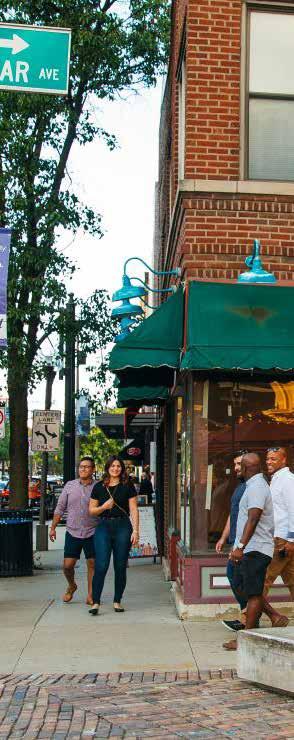
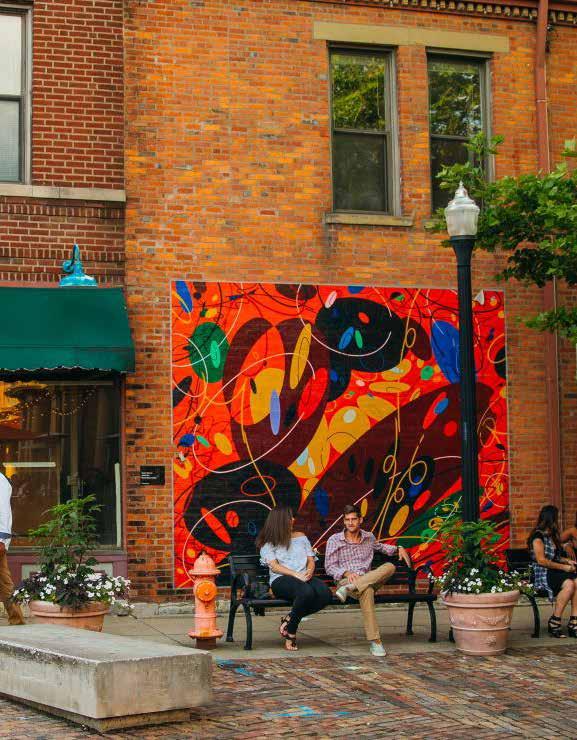
The intent of the Choice Neighborhood Plan is not simply to replace housing at Bartram Village but to connect residents to educational resources, training programs, and meaningful opportunities so that they may thrive. There are several investments planned in and around the Choice neighborhood, and there are many needs in the community that can be turned into opportunities. The set of goals under “Thrive” are designed to position residents to take advantage of these significant developments.
Goal 1
Develop a pathway success beginning in early childhood. ▶ Goal 2
Nurture a culture of literacy at Bartram Village. ▶ Goal 3
Cultivate a local employment training ecosystem that aligns with neighborhood needs and opportunities. ▶ Goal 4
Bridge the basic skills divide. ▶ Goal 5
Strengthen the identity and vibrancy of the neighborhood.
This map shows the ways in which the THRIVE theme will physically transform the neighborhood through new job opportunities, better access to enrichment resources, and enhanced commercial corridors.

At Bartram Village, where 48% of residents are 18 or younger, it is critical to create a supportive pathway to education that begins with the youngest residents and continues to build skills and confidence through high school and beyond, opening doors to employment and self-sufficiency.
The Needs Assesment findings showed that Bartram Village residents attend a wide variety of schools in the area in part because public schools in the area are among the lowest performers in the city (see Chapter 2: About the Neighborhood). As a result, supportive programming fills an important gap to help keep students on track.
This goal strives to go beyond traditional classroom education and support the whole child, the child’s family, and extended community so that the child can thrive.
schools do Bartram Village children attend?
60% of BV respondents’ children under 5 are enrolled in a formal early childhood education program such as Head Start
67%
Graduation rate for Bartram High School
What additional services would help your children do well in school?
Homework club on-site at Bartram Village #2
Individual tutoring #1
Summer programs #3
The Parent/Child + Home Program is an evidence-based school readiness model that provides both young children and their parents with tools to read and learn. The program offers one-on-one home visits with families as well as monthly parenting workshops on-site at Bartram Village.
Participants in the Parent/Child + program are 50 percent more likely to be prepared for kindergarten than their peers, scoring 5 times higher on social emotional skills than peers, and have 30 percent higher graduations rates than their peers.
Through this effort, we will expand the project to include a Parent/Child+ Early Learning Specialist for Bartram Village to provide in-home support to families. Our goal would be to enroll 26 percent more children between the ages of 1-5 into the Parent/Child+ program over 5 years (15 families).
With such a young population and high percentage of single parents at Bartram Village and throughout the neighborhood, there is a major need in the area for affordable, quality childcare nearby. This strategy will help parents understand the importance of quality early childhood education and guide them in navigating available resources. PHLPreK is a resource for both families and childcare centers to ensure quality early childhood education services in the city of Philadelphia including registration for early childhood education programs and Head Start programs and technical support for childcare providers that enroll in the Keystone Stars Program.
Our goal is for 60 percent of families in Bartram Village with children under the age of 5 to enroll in a Head Start or early childhood education program within 5 yerars. With a Coordinator connecting residents to discuss barriers and goal planning, residents with children under the age of 5 will be directed to early childhood education centers to enroll in preparation for Kindergarten. Southwest Philadelphia has many childcare providers that have or receiving technical support from PHLPreK as the agency and plans to expand the number of seats available to 5,500 seats.
Strategy A: Expand Parent/Child+ Home Program to Bartram Village to support parents and infants/ toddlers.
Strategy B: Establish direct resource to childcare centers in the local area that provides quality childcare and slot availability through partnership with PHLPreK.
If you have high-school aged children, what path are they taking after high school?
7% are pursuing job training or an apprenticeship program
What are some of the reasons that people struggle to get a job or stay employed in the neighborhood?
Criminal history #2
20% are entering the workforce
Issues finding childcare
Lacking the skills needed for available jobs #3 32% are going on to a 2- or 4-year college
PHA’s vision for after school programs involves partnering with local agencies that are embedded in the community to offer after school activities that provide a wide range of learning opportunities, including STEM, music and career exploration.
Our goal is to introduce STEM or a new music program to engage children in the sciences and math, enrolling 20 percent of Bartram Village youth ages 6 to 15 in the after school programs. PHA’s Resident Programs and Partnership (RPP) Department will be completing a RFP process during the Summer of 2020 for partners to submit proposals and a scope of work around innovative after school programming to start in the fall of 2020.
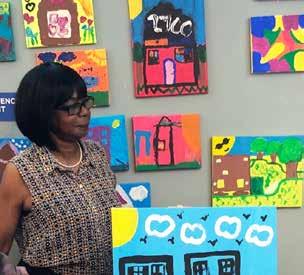
Enhance after school programming at Bartram Village to include the arts, reading, science, and music with partner agencies.
The newly established Director of Site Based and Senior Programs at PHA will strengthen relationships with local agencies in the neighborhood and direct residents to upcoming initiatives for summer programming for students to attend and take advantage of career exploration and training opportunities. New partnerships include recruiting efforts for residents to attend local programs including a Career Exposure Summer Program at Tilden Middle School, Hammers with Heart Trade Camp at the Common Place and summer work opportunities with WorkReady.
Coordinators will connect 20 percent of Bartram Village youth ages 14-21 over the next 5 years to internship and/ or pre-apprenticeship opportunities with our partners at WorkReady, Careerlink® and Year Up to start their career pathway, credential attainment and prepare youth for future employment.
Tilden Middle School located at 66th Street and Elmwood Avenue is one of the first “community schools” in Philadelphia, a program developed under Mayor Kenney in 2016. Community schools address a neighborhood’s unique needs within the school setting, bringing together community organizations, volunteers, and programs to serve the school’s youth, parents, teachers, and neighbors. At Tilden, area residents can take advantage of job hiring fairs, English language classes, a free monthly food pantry, free nutrition classes in partnership with VETRI, and free BenePhilly services. Tilden is also working to provide physical, social, emotional, and mental health services for local families.

Strategy D:
Establish pre-apprenticeship opportunities and internships to expose students to careers, skills advancement and graduation.
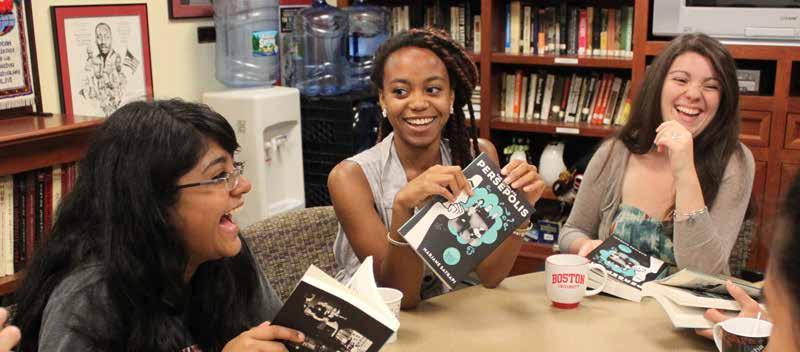
One of the most surprising findings from the Needs Assessment survey was the number one amenity desired by Bartram Village residents—a library. The Kingessing Library is located in the neighborhood and Pashcalville Library is just outside the boundary. Follow up discussions at Task Force meetings and with local services providers and educators, as well as first-hand observations by the planning team indicated that literacy is a challenge for residents of Bartram Village as well as the larger Choice
neighborhood. A frustration often shared by parents is not being able to participate in their children’s education by assisting with homework or reading to them.
Getting people of all ages to become proficient readers at Bartram Village is a priority. This goal strives to create an environment that encourages reading in a variety a ways that make it fun and easy to do at any age.
What amenities do you think are needed in the neighborhood?
#1 Library
Strategy A:
Establish a Philly Reading Coaches initiative at Bartram Village to provide volunteers to boost reading skills of children at Bartram Village.

This strategy focuses on building reading skills for young children from kindergarten through 3rd grade by giving them the individualized attention so that they may improve their skills. Recently launched in Philadelphia, Philly Reading Coaches pairs trained volunteers with young readers for 30 hours of reading time. Each child who participates in the program is given 25 books to take home. According to the program, children who can read well by 4th grade have a better chance for high school success. Currently, two out of three Philadelphia students are struggling to meet this goal.
Our goal is to enroll 10 Bartram Village students each year to participate in the program and track progress.
Two out of three Philadelphia students are struggling to read well by 4th grade
27-42%
Percentage of students in the four public schools who are reading at grade level for grades K-2
(according to the School District of Philadelphia School Progress Report for School Year 2017-2018)
Philly Reading Coaches is a new program based on the SMART program that has been running in the state of Oregon for over 26 years. Studies show significant improvement in students’ ability to read with just 60 minutes of one-on-one reading time a week over the course of a school year. Children with 25 books in their home are also more likely to complete two more years of school on average than kids with no books in their home. Visit www.getsmartoregon.org/theory-ofchange/ for more information.

This strategy strives to assist adult residents who may wish to improve their reading skills as well as furthering their education. PHA’s newly established Director of Site Based and Senior Programs will strengthen relationships with providers in the neighborhood and direct residents to these resources, including Tilden Middle School, Southwest Catholic Social Services and PHA’s Workforce Development Center, which opened in 2019. The program coordinator will also review potential barriers such as childcare and transportation to remove obstacles and encourage participation.
PHA Workforce Navigators will offer an Orientation Session on site at Bartram Village once per month to discuss literacy opportunities and connect residents to local partners or at PHA’s Workforce Center, which offers GED or Adult Basic Education Classes.

A comfortable, bright and inviting space in the new Community Building will celebrate the power of reading. Reading is knowledge and knowledge is power. By creating an attractive space where residents of all ages can gather to read or simply borrow a book will help spark interest in reading regularly. Outdoor spaces will also be designed with benches for reading and reflection. Residents will also be given guidance and encouraged to set up book clubs across multiple generations.
PHA Coordinators will coordinate book clubs including one for seniors, an intergenerational book club to encourage youth and senior interaction, and a toddler book club so that the reading nook has structured, recurring events. Both adults and children will have opportunities to decorate the reading nook to fit their needs, be creative, and create an environment that encourages reading and literacy.
Utilize PHA Workforce Navigators from the Workforce Center to guide residents to literacy, GED and Adult Basic Education Classes.
Design a reading
in the Community Building with a lending library and encourage a variety of
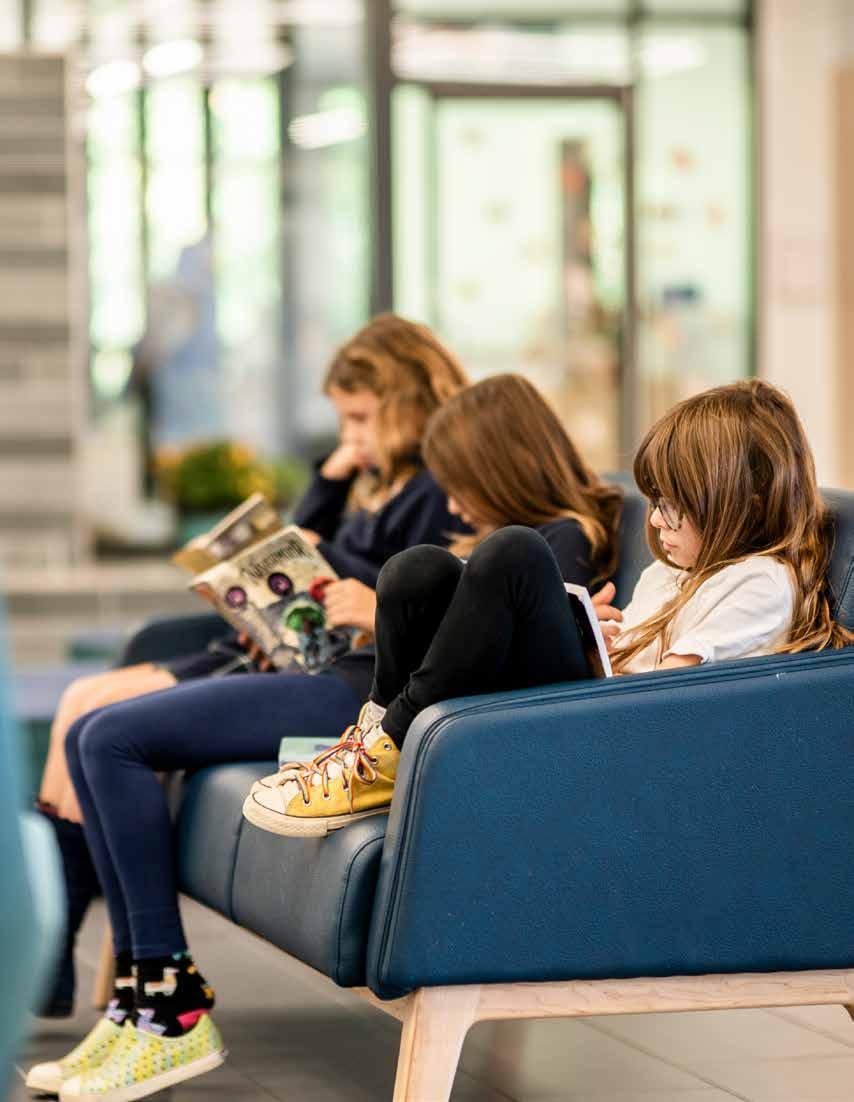
The rate of unemployment in the Choice neighborhood is quite high at 15% compared to the already high rate of 11% in the city. At Bartram Village, 68% of work-able residents are unemployed. This correlates directly to lower incomes. This goal focuses on three distinct target groups: those aged 18-24, un- and under-employed, and those seeking re-entry. A major emphasis is to better align training programs to local employment positions and to simulate local job opportunities that help improve neighborhood conditions such as building repairs, green infrastructure, and quality childcare.
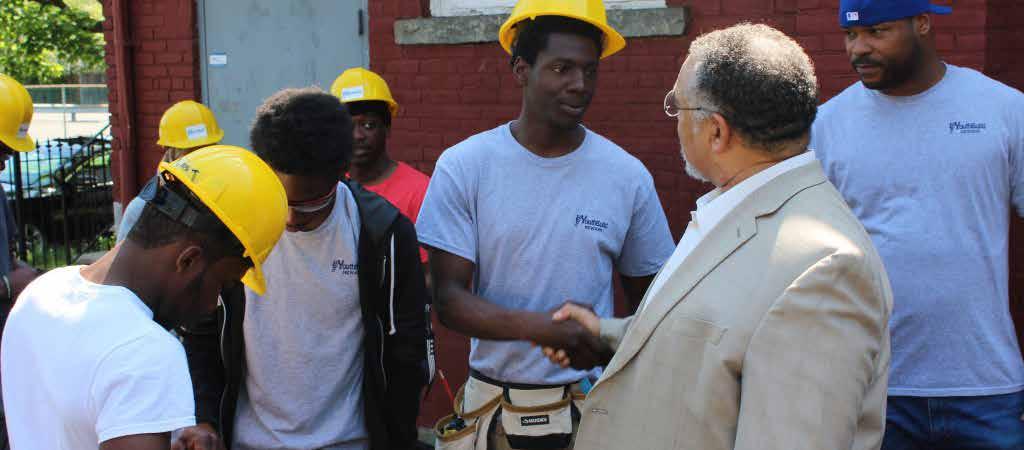
GOAL 3:
Cultivate a local employment ecosystem that aligns with neighborhood needs and opportunities.
What transportation-related issues present a challenge in your daily life?
Cost of transit services #2
Road condition/ potholes #1
Pedestrian safety #3
#3
Customer Service
68% unemployment rate at Bartram Village
[according to data provided by PHA March 2018 – rate of unemployment among work-able household members]
Which job training programs are of most interest to you?
#2 Cooking
#1 Nursing / Healthcare
Strategy A:
Collaborate with providers and local employers to create training programs for green jobs, child development, and construction that meet employers needs and provide full-time opportunities for residents, including partnership with PowerCorps, REBUILD, Property Maintenance Guru Training and landscaping training.
The age, condition, and expense to repair and maintain most of the housing in Southwest Philadelphia presents a constant challenge for homeowners. Addressing this need with local contractors presents a tremendous opportunity to build local capacity, put people to work, and stabilize building conditions. Similarly, local talent could be developed to make repairs under Philadelphia’s Healthy Rowhome Project, Basic Repairs System, and Community Asthma Prevention Program. [see descriptions of these programs under “LIVE!”]
Philadelphia’s innovative Water Department is hard at work installing green infrastructure at nearly every scale throughout the city to manage stormwater and water quality for Philadelphians. Its Green City, Clean Waters program is beautifying neighborhoods, fighting extreme summer heat, creating natural habitats, enhancing public space and schools, and even making neighborhoods safer. It’s also creating green jobs in the city that provide highvalue employment opportunities for residents. The Bartram Choice planning effort is working with PowerCorps and the City’s Department of Parks and Recreation REBUILD initiative to create local training opportunities to enable residents to take part in the green jobs economy.
In an area with such a high percentage of children and single parents, finding affordable quality daycare nearby is another ongoing challenge. Providing local child development associate (CDA) training opportunities will give local residents marketable skills and equip the community with higher skilled caregivers through our partners at Congresso and District 1199C.
Our goals is to enroll 15 percent of our workable adult residents (ages 18-30) in a training program in the next five years that provides industry recognized certification, wrap-around services and case management throughout the training program to completion.
Which job readiness programs would be of most interest to you?
A rent freeze program for the first year of employment #2
#1
#3
#4
Small business loans
Continuing education leading to a job-related certificate or degree program
What types of services do feel are missing in the neighborhood?
Job placement, computer training, literacy classes, resume assistance, career development and re-entry
Strategy B:
Enhance partnership with PowerCorps to enroll residents from all housing sites including Bartram Village. Programming includes reentry services.
PowerCorps provides career pathways for young adults (ages 18-26) in green infrastructure, electrical and urban forestry. Residents will earn a stipend, receive mentorship and technical training in land care and environmental stewardship.
We plan to enroll 10 percent of our residents in PowerCorps or a similar job training program such as the Center for Employment Opportunities that provides reentry services and case management services throughout the training program and completion.
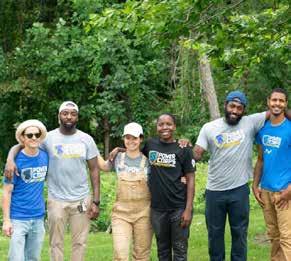

The internet provides a wealth of information at people’s fingertips, but this information is not very accessible without a computer or a basic set of computer skills. And now that most job applications are online and communication is through email, even finding employment opportunities can be out of reach or incredibly frustrating to navigate. The purpose of this goal is to assist residents in developing skills that are critical to have in today’s world.

What types of services do you feel are missing in the neighborhood?
How do you typically find information about your neighborhood?
Job placement, computer training, literacy classes, resume assistance, career development and re-entry
Strategy A:
Utilize PHA Workforce Navigators to connect residents to financial literacy, job readiness workshops, and homeownership workshops.
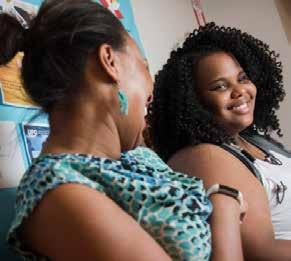
Workforce Navigators will also host quarterly workshops on-site at Bartram Village to share program information, recruitment events, and market services.
PHA’s Workforce Development Center opened in April 2019 in North Philadelphia to provide one-stop services for training and literacy programming to residents and the community, Bartram Village residents have access to the Center. PHA Workforce Navigators will offer an orientation session at Bartram Village once a month about the programs including but not limited to FSS program, job search readiness workshops, and Section 3 Orientation and training programs. For recruitment events at the Workforce Center, PHA Coordinators will coordinate a shuttle to provide transportation to and from the events for residents to attend.
Word of mouth, friends, family
#2 #3
Local newspapers/ newsletters
Internet/social media
Many residents have limited internet and computer access.
22% of residents have a computer with internet access at home
Strategy B:
In partnership with the Urban League, host digital literacy events at Bartram Village.
The Urban League will be on-site to offer computer literacy workshops in the computer lab covering basic computers, how to navigate the internet, email etiquette, managing a professional image on social media, and using Microsoft Office. The hands-on curriculum and highly trained facilitators will work with residents to enhance their digital fluency.
Coordinators and the Bartram Village Computer Lab Monitor will schedule workshops in the computer lab and track attendance. Goal includes engaging 25 percent of Bartram Village seniors to participate in digital literacy instruction.
Strategy C:
Create a Computer Lab Monitor training program to up-skill Computer Lab Monitors at all PHA sites including Bartram Village to assist residents with computer literacy and job search needs in onsite computer labs.
Through the assistance of a VISTA volunteer, PHA will design a training program to provide detailed instruction on operating a computer lab, using Microsoft Office, and providing technical support to residents.
Up to 17 Computer Lab Monitors will participate in the training program that will include hand-on instruction to enhance computer and technical skills and to provide additional services to residents at their assigned computer labs. The Lab Monitor at Bartram Village will be able to run workshops on job applications, basic computer skills, and assist residents visiting the Computer Lab with technical support issues.
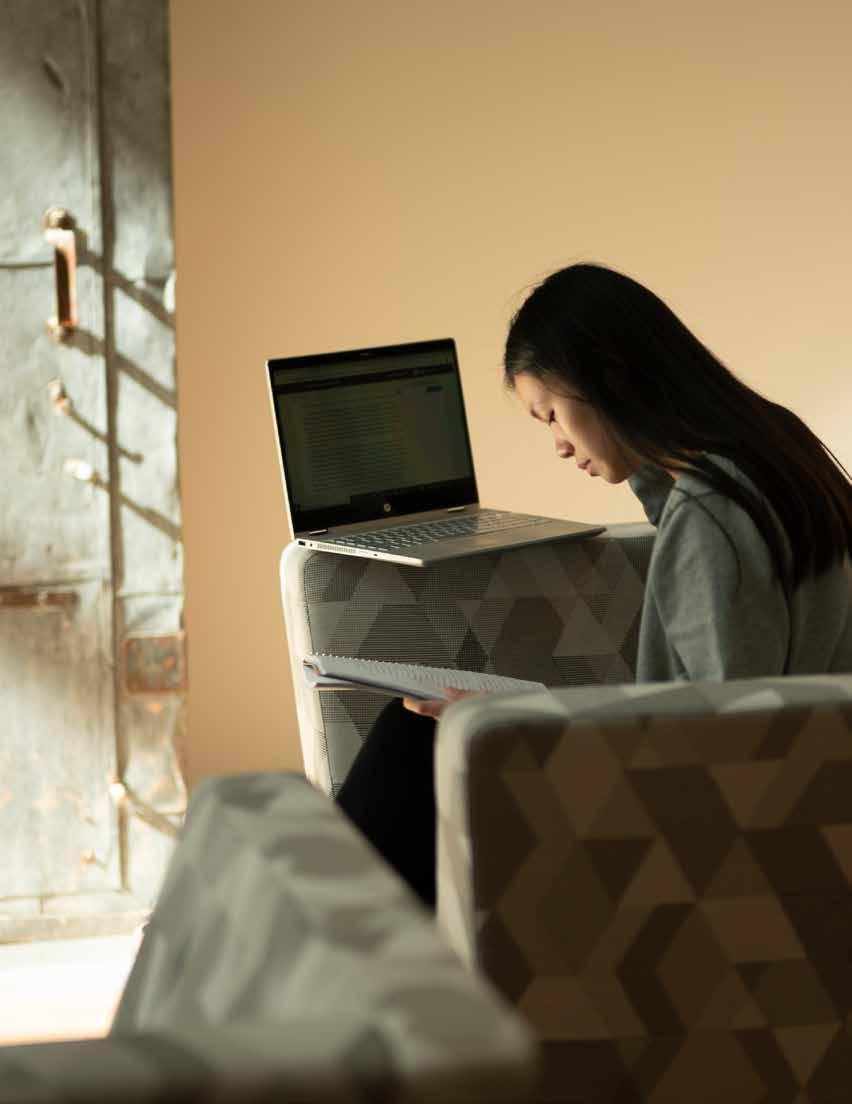
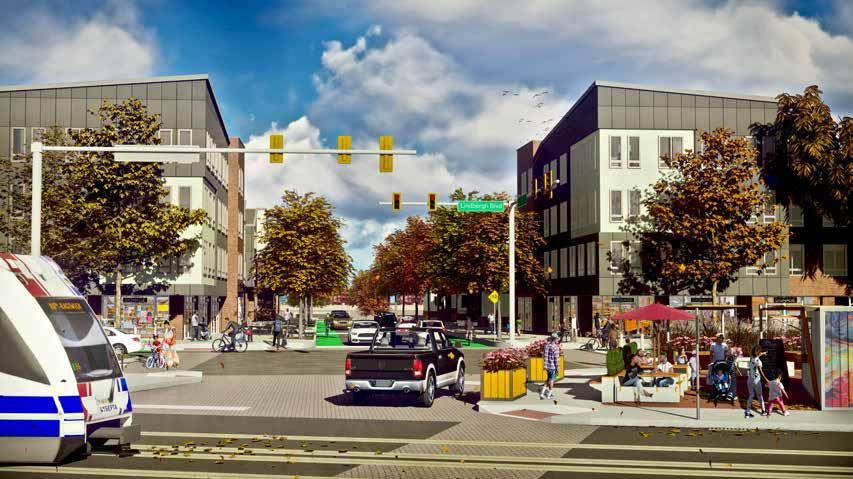
GOAL 5: Strengthen the identity and vibrancy of the neighborhood.
What improvements should be made to Woodland and Chester avenue corridors?
How would you like the next generation to view this community in the future?
Beautiful, safe, clean, green, peaceful with artwork, paintings and a sense of history; a place to be proud of
Gateways are a powerful placemaking strategy that can be used to celebrate a neighborhood’s identity, history, and culture while helping to orient visitors. Several potential gateways were identified through the planning process, including 56th Street and Lindbergh Boulevard, 49th Street and Woodland Avenue, and 65th Street and Woodland Avenue.
49th Street and Woodland Avenue is a major entry point into the Choice neighborhood from both University City to the north and Center City, as people drive across the Grays Ferry Bridge and land in Southwest Philadelphia. This intersection is identified as a Focus Area in the University Southwest District Plan, which recommends placemaking and mixed-use development along surrounding streets to generate more activity.
65th and Woodland Avenue is a focal point of the recent study prepared by ACANA with the Community Design Collaborative that explores creating a cultural identity along Woodland Avenue.
The 56th Street and Lindbergh Boulevard intersection is the focus of this strategy as it is a key entry point to the Schuylkill River Trail system from the Southwest
neighborhood. In addition, this intersection will soon become a major point of entry to PIDC’s Logistics Hub that is planned along the Schuylkill River directly south of Bartram Village. Bartram’s Garden is also planning exciting projects on the river at 56th Street, including a new mussel hatchery and float lab. In addition, Woodland Academy, is planning an innovative new learning center—the Nest— along 56th Street.
With all of this anticipated development coming together at 56th and Lindbergh, reimagining the redeveloped Bartram Village site offers the potential to create a major new entrance to Bartram Village that also becomes a highly visible gateway for the area.
The vision is to celebrate the area’s people and culture, as well as its horticultural and industrial history. It will incorporate green infrastructure and integrate safer, more visible crossings for pedestrians, as well as bicyclists connecting to the 58th Street Greenway. A plaza space on the Bartram Village site will frame the enhance to the gateway, and may also incorporate features such as public art or banners.
Action Activity: Establishing a gateway in this location is such a priority for the community that it was selected as an Action Activity. Currently, there is a vacant parcel owned by Empowered CDC bordered by 56th Street, Lindbergh Boulevard, and Elmwood Avenue. The vision is to transform the site into a lively public space incorporating a community art project, landscaping, and amenities to support public programs.
Strategy A: Create a neighborhood gateway at 56th Street and Lindbergh Boulevard with signage, public art, and enhanced pedestrian crossings.
▲
Strategy B:
◀
There are many opportunities to celebrate this neighborhood’s diversity of stories, drawing on—its botanic history, its Native American roots, the industrial legacy, famous past residents, and the African and other immigrant communities who have called Southwest Philadelphia home in the past and today. These themes will continue to be explored and celebrated as the designs for the redeveloped Bartram Village site and 56th Street Gateway evolve.

Bishop Richard Allen was a minister, educator, writer, and one of America’s most influential Black leaders. He opened his first AME church in Philadelphia in 1794.
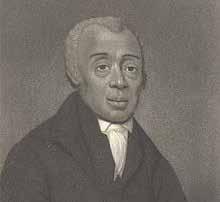
Woodland Avenue, c. 1960, courtesy of the City of Philadelphia Department of Records.

▼
“Bridging the Gap” by Willis “Nomo” Humphrey at 58th and Woodland Avenue (Mural Arts).
Highlight the rich history and culture of Southwest Philadelphia through public art, placemaking, and wayfinding signage, where appropriate.
Improve
and
Avenue and Chester Avenue commercial corridors.
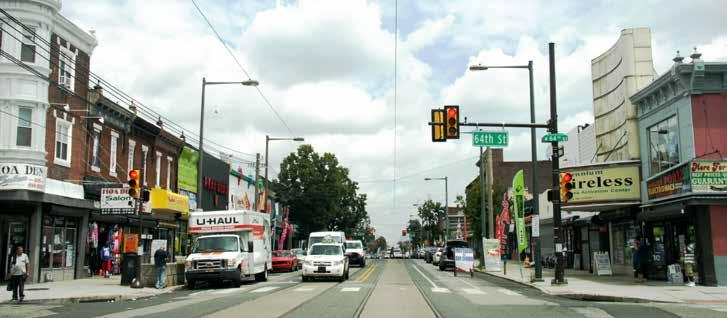
of
Residents have expressed a reluctance to do much of their shopping along these corridors because of their reputation as being unclean and not well looked after. However, several organizations are already working to improve cleanliness along certain sections of Woodland and Chester Avenues. For example, ACANA manages a volunteer street and sidewalk cleaning program on Woodland Avenue between 58th and 66th Streets and hopes to expand its reach in the near future. Building upon these efforts, as well as working with city agencies such as the Commerce Department and Streets Department to increase the cleanliness of the commercial corridors, will improve the shopping experience and attract more visitors and patrons.
The Choice neighborhood’s bustling commercial areas, primarily along Woodland and Chester avenues are full of interesting businesses and helpful services. However, residents report that they would frequent these corridors more often if they were cleaner, better cared for, and safer. The City of Philadelphia Commerce Department offers a variety of programs and technical assistance to businesses hoping to improve or expand services. These include a popular storefront façade improvement grant program, a security camera grant program, equipment and interior improvement loan programs, and one-on-one support through a local business services manager. ACANA has so far assisted five businesses along Chester Avenue in completing the storefront improvement program. Building on these efforts will further enhance the corridors and motivate more business owners to make improvements.
Woodland


The Bartram Choice plan aspires to improve the quality of life throughout Kingsessing and Southwest Philadelphia. In this section, we focus on Bartram Village to see how the goals of the plan come together to form a beautiful, safe, welcoming community of which residents can feel proud, with access to the services and amenities that will enable them to blossom.
IN THIS SECTION:
Putting it all together at Bartram Village
The design takes shape Housing plan overview Design character
In the previous section, we outlined the overarching goals and strategies for the Bartram Choice plan that strive to position residents to Connect, Live and Thrive. In this section, we illustrate how we applied the plan’s goals and strategies to Bartram Village with the hope of reconnecting the site and its residents to the surrounding neighborhood and creating a walkable, green, mixed-income community with new housing in a beautiful setting with jobs and amenities nearby, and safe connections to center city and the larger region.
The diagram to the right explores some of the potential opportunities to tie into and enhance nearby amenities such as Bartram’s Garden, the Schuylkill River Trail, PIDC’s anticipated Innovation Hub, the existing trolley network, and area services. These features will become the building blocks that form the foundation of the plan.
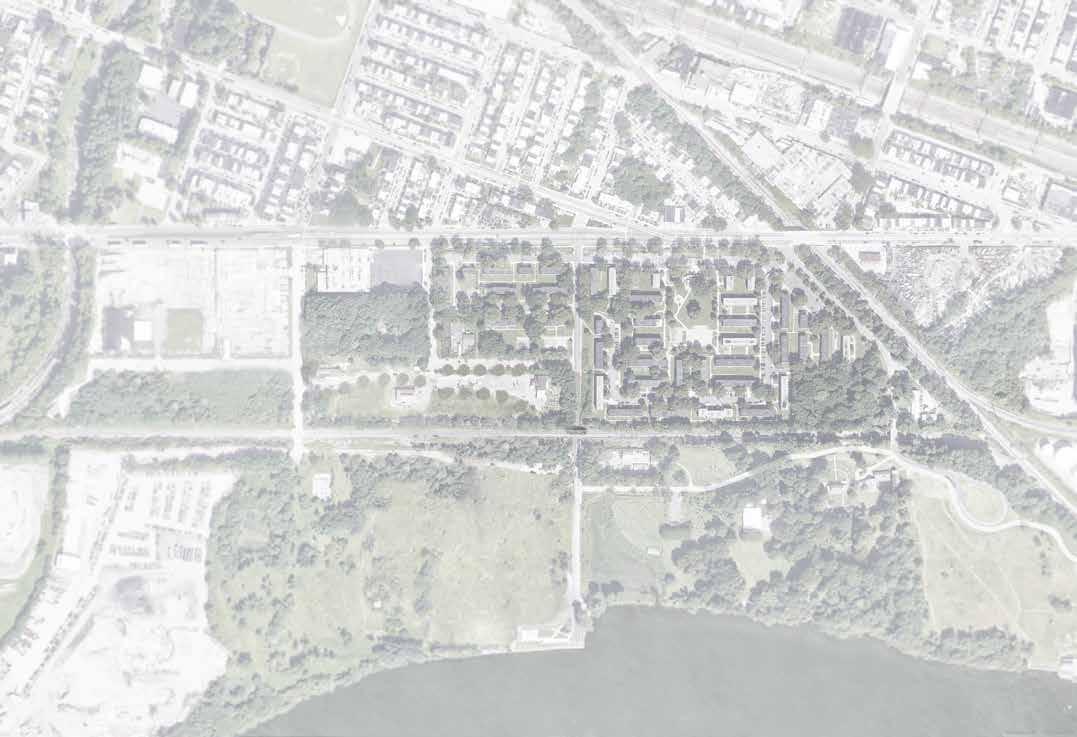


Although Bartram Village is located in a dense urban environment with much to build on, the site’s layout and location within the industrial corridor create obstacles that make it difficult for residents to take advantage of the city’s offerings and thrive:

▶ Isolation and inactive street frontage: The long three-story buildings are out of scale with nearby homes and create an extended stretch of inactivity along Lindbergh Boulevard. Lack of a clear “front door” also makes the site uninviting to the community.
▶ A disconnect in the circulation network: Traffic zips along Lindbergh Boulevard and criss-crossing rail lines further isolate the site physically from the surrounding neighborhood and also make it difficult and unsafe to walk to recreation centers, the grocery store, and basic services along the commercial corridors.
▶
Indefensible space: The long three-story buildings do not provide clear views of walkways or outdoor spaces, resulting in unsafe and unused spaces.
▶
Limited waterfront views: The current layout of the site does not take advantage of the topographic character with limited opportunities for residents to enjoy views of the waterfront.
▶
Few outdoor recreational opportunities: Although 40% of the site comprises “green” space, the open space at Bartram Village is underutilized in part because of the design and programming.
▶
Lack of spatial hierarchy: The grassy open spaces are not varied in a way that invites residents to gather, whereas a central gathering place could foster a sense of community.
LANE PEDESTRIAN PATH TROLLEY LINE MAIN ROAD INNER ROAD INNER ROAD
The task forces and planning team turned these challenges into opportunities when exploring ideas and alternatives for the Bartram Village site. As the plan took shape, the design embraced the goals of helping residents to Connect, Live, and Thrive.
▶ Reconnecting with the neighborhood: Beginning at the street level, the plan strives to stitch Bartram Village back into the neighborhood and to make it easier for residents to connect to area amenities. This includes safe walking routes and transit connections, an emphasis on improving conditions along priority streets, generating more street activity, welcoming the community, and extending the natural environment into the neighborhood.
▶ Design for safety: Safety is the top concern for residents and top priority for the site. Two and threestory buildings are oriented toward the streets so that windows overlook pedestrian pathways, parking lots, and green spaces. Points of entry are clearly defined and the site is beautifully landscaped to indicate that this is a community that is being cared for.
▶ Activating the street edge: Larger multi-family and senior buildings are placed along Lindbergh Boulevard forming a street edge. Retail spaces on the ground floor create visual interest and generate “more foot traffic,” which reinforces safety.


▶ Protecting and celebrating nature: Bartram Village is blessed with beautiful trees and open spaces that expand the leafy refuge of Bartram’s Garden next door. The buildings and site integrate green building practices to preserve the site’s natural beauty. Landscape elements are designed to serve multiple purposes including managing stormwater, protecting air and water quality, creating wildlife habitat and pollinator gardens, while providing places for human residents to enjoy.
▶ A place for people of all ages and abilities: Bartram Village is designed to be equitably accessible and enjoyable by all residents. For the young population, there are a variety of creative playspaces that invite imagination and curiosity while allowing for exercise. Safe walking / jogging paths and adult recreation areas will strive to get all ages moving. Benches and barbecue pits invite adults, families, and friends to interact while providing clear sightlines of playspaces.
▶ Building a sense of pride: A variety of new housing alternatives; enhanced connections to services, amenities, jobs, and transit; a clean, safe, green, and attractive place to call home will help make Bartram Village become a desirable place for residents to choose to live.

Open spaces were designed to be very visible from people’s homes to place more “eyes-onthe-street” and encourage a sense of ownership to enhance safety. A couple of high points are designed to provide outdoor amenity spaces with views of the waterfront.
BIKE LANE
PEDESTRIAN PATH TROLLEY LINE MAIN ROAD INNER ROAD TROLLEY STOP
The proposed main street network is designed to create stronger connections between Bartram Village, Bartram’s Garden, and the neighborhood while building awareness and use of existing civic and cultural spaces. The site design aims to improve safety and shape a more walkable environment by adding a walking path besides the street sidewalk that connects major green spaces along the main walking loop.

PUBLIC USE FACADES WALK-UP FACADES IMPROVED RESIDENCE FACADES



The streetscape along Lindbergh Boulevard will feature attractive storefronts and paths into the site, inviting people to enjoy the open spaces that are designed to host flexible programming and encourage informal interactions.




Given the limited opportunities to locate significant development elsewhere in the Choice neighborhood, the focus of the Housing Plan is centered around two major goals—preserving and stabilizing affordable housing in the neighborhood (as described in LIVE Goal 1) and the redevelopment of Bartram Village into a mixed-income community (LIVE Goal 2). This section focuses on Goal 2.
The vision for housing at Bartram Village took shape in response to the feedback and preferences expressed by residents of Bartram Village and the surrounding community. The chart to the right offers a snapshot of how this input formed the basis of the housing component of the plan. The site planning and design also integrates many of the goals and strategies of the “people” and “neighborhood” plans.
At the center of the Housing Plan is one-for-one replacement of every public housing unit currently on site, as well as the right of return for existing residents of Bartram Village. The Housing Plan proposes to replace the existing 500 units of housing at Bartram Village with a total of 644 new residential units in a variety of building types, including townhomes, senior apartments, walk-up apartments, and multi-family buildings on-site at Bartram Village. One hundred of these units will be located “offsite” on a parcel adjacent to Bartram Village, where the building types include a combination of townhouses and one multi-family building.
A total of 500 units will replace those currently located on the site in addition to 30 affordable homeownership units and 114 workforce/non-Income restricted rental units, which are considered “non-replacement” units.

Residents said... We listened.
Rental housing in the neighborhood is poor quality, due largely to the old housing stock.
644 new homes will replace 500 obsolete housing units.
83% of BV residents want to live in a townhouse type of building. The new housing types are mostly townhouse-style buildings.
21% of residents desire homes that are customized to address disabilities.
Approximately 40% of all new homes could be fully ADA accessible; vision and hearing impaired homes will be built to suit.
10% of BV residents are 55 or older. Two new senior apartment buildings will be located along Lindbergh Boulevard.
44% of residents desire a mixture of new affordable and workforce housing.
69% of BV residents aspire towards homeownership.
New housing should promote positive physical and mental health.
New non-residential programming should be included on-site.
78% of new housing units are affordable to extremely low-income, very low-income and low-income families; The remaining 22% are designated as workforce or market-rate housing
30 homeownership townhouse units are planned for the Bartram Village site and at least 6 affordable homeownership opportunities are targeted in the neighborhood.
Playgrounds, walking trails, and healing gardens are among some of the features that will foster positive physical and mental health.
Over 22,000 SF of non-residential space is planned which may include a commercial kitchen, small business incubator, gym, office space, and/or community room.
Strive to make the community resilient to the forces of gentrification.
Redevelopment should occur with minimal disruption to BV households.
Redevelopment of Bartram Village will replace all 500 existing public housing units.
Implementation of the plan will involve multiple phases of redevelopment with one off-site opportunity site (currently vacant).
Retain the site’s “green” character.

Public safety is a concern.
Apply strategies of trauma-informed planning to the site’s design.
The redeveloped BV site has been carefully designed to preserve old growth trees and to incorporate green stormwater infrastructure and a variety of green spaces.
New homes are oriented to the street with front doors to provide clear views and maximum defensible space.
Access to and views of nature, healing gardens, opportunities to exercise and socialize, and a central community building are just a few features of the redeveloped Bartram Village.
Bartram Residents First: The Bartram Choice Housing Plan will above all serve the needs of Bartram Village residents— with housing that supports the positive development of households, not just provide new shelter. Clear communication, a safe and nurturing community, access to good childcare, health services, and jobs will be key components. Design of homes and spaces that cater to the elderly, youth, and disabled residents will also be priority. Every public housing unit at Bartram Village will be replaced on site and all current Bartram Village residents in good standing will have a right to return to the redeveloped units.
Restore Health : Bartram Choice aims to promote a healthy body, mind, and environment by creating a safe community that encourages people to interact, heal, and thrive. Well-lit walking paths, bike trail connections, and playgrounds will make it easy to be physically active. Healthy building materials, daylight, views of nature, and social spaces that bring people together will support mental health and well-being. The site and buildings will be designed to preserve green space and protect natural systems.
Build Wealth: Bartram Choice will create multiple paths for residents to build wealth. Underutilized, vacant, and blighted houses in the neighborhood will be targeted for renovations and set aside for low-income residents to become firsttime homeowners. Supportive programs will assist Bartram Village residents in improving their credit, enhancing their financial management and employment skills, and learning how to become homeowners. The process of making homes available will also be used to nurture local entrepreneurs by teaching neighborhood residents how to invest, finance, renovate, manage and sell properties.
Leverage Uniqueness: Bartram Village sits at the intersection of a rich multi-cultural history that is intertwined with horticulture, industry, innovation, the waterfront, and urban form. The design of the renovated Bartram Village will celebrate these roots and plant the seeds of a more resilient and contemporary community where people are well-connected to resources, opportunities, and one another.
Strength in Diversity: The redeveloped Bartram Village site will reflect the increasing diversity of families and the neighborhood. By integrating a variety of housing types and sizes that support intergenerational living and a variety of needs, Bartram Choice will foster a welcoming and inclusive mixed-income community.
Preserve Long-Term Affordability : Bartram Choice will strive to make the community resilient to the negative impacts of gentrification. This will happen first by replacing all of the existing Bartram Village units one-for-one with new public housing units on site and having PHA retain ownership of the site. In addition, the units developed will have long-term affordability restrictions.

The Housing Plan is appropriate in the context of the local housing market as supported by a market study conducted by Econsult Solutions.
The Market Analysis indicates the need for affordable housing. Approximately half of neighborhood households earn less than $30,000, or 40 percent AMI. These households are unable to afford the current market rate of rental housing in the area. Given the extent of low-incomes in the neighborhood, and if there is any upward pressure on rents or home prices, the need for affordable housing will increase. The Choice neighborhood has seen minimal new housing stock product in recent years and some elements of the economic development plans for the area will be completed in the next two years. Given the waiting lists at other affordable housing developments produced using low income housing tax credits, and the income levels in and around the Choice neighborhood, absorption could occur at rates of 15 to 20 units per month.
While the Choice neighborhood currently has a high need for affordable housing, recent and upcoming developments in and around the area, as well as a competitive real estate market directly to the north, will likely heighten demand for market rate housing—both to rent and to own—in the near future, especially in the northern portion of the Choice neighborhood. The area provides opportunities for traditional row home development, stacked row homes, and multifamily buildings. Boarded up rowhomes in this area also provide opportunities to redevelop the existing housing stock into productive use at a lower cost than building new.
While the homeownership rate in the Choice neighborhood is currently low, the density of high-wage employment opportunities in University City, the competitive real estate market directly north of the Choice neighborhood,

and the abundance of new amenities and developments in the area will likely attract homebuyers in the near future. Econsult estimates that if development of new and renovated units is timed appropriately as to not saturate the market, properties in this area could sell within 30 days with price points at or slightly above the average sale price ($225,000 to $275,000) in the near term.
The Market Analysis indicates that rental rate growth will probably lag but that absorption will increase in the near term with the completion of some elements of PIDC’s Innovation District and the swing bridge connecting Center City to the neighborhood along the Schuylkill River Trail.
Alternatives for the target housing site, Bartram Village, were considered but not pursued because (1) rehabilitation cost exceeds $100 million—over 80% of the Total Development Cost of the entire site—determining that it is not economically viable to rehabilitate Bartram Village units. Residents have also expressed desire to demolish and build new. (2) Building 500 units of new housing elsewhere is unrealistic in Philadelphia—a fast growing city with high demand for developable land.
The Housing Plan strives to serve existing residents, neighborhood residents, and renters and homeowners across a broad range of incomes. The Housing Plan serves existing neighborhood residents by providing high-quality, energy-efficient, new rental housing in the neighborhood as a strong alternative to the existing older, housing stock. Two senior-only apartments in the Bartram Choice housing plan will serve existing Bartram Village seniors and households on PHA’s senior waitlist. At the same time, the site plan is designed to respond to Bartram Village’s young population with playgrounds for all ages, a multiuse playing field, basketball court, and walking trail.
The Housing Plan aims to attract new renters in the following ways: (1) Philadelphia families seeking affordable new homes with easy access to jobs in Center City, University City and Philadelphia International Airport.
(2) Target marketing to thousands of anticipated employees on PIDC’s new industrial campuses.
(3) Millennials and retirees (Philadelphia’s fastest growing cohorts) looking for new housing with easy access to world class recreational assets.
Currently, there are 1,056 bedrooms in 500 units at Bartram Village. The Housing Plan proposes a total of 644 new units of housing, comprising 1,463 bedrooms, on two sites—Bartram Village and a large vacant parcel next to it by the Richard Allen Preparatory Charter School.
The Housing Plan proposes 1,260 bedrooms in 544 new residential units on the Bartram Village site.
Responding to the desire of current residents to live in townhomes, the plan proposes a total of 277 townhome style units. There are also seven walk-up apartment buildings and one multi-family apartment building.
Older residents expressed a strong desire for dedicated senior buildings. As a result, two senior buildings with a total of 90 units are located along Lindbergh Boulevard, with easy access to retail, services, and transit. Responding to residents’ interest in owning a home, the plan includes 30 new affordable homeownership units on-site.
The basis for the unit mix was informed by the market analysis as well as the needs and preferences of current Bartram Village residents and the surrounding neighborhood. At the moment, there are a large number of children, large families, and many intergenerational households living at Bartram Village. As a result, the plan includes a significant number of 3- and 4-bedroom units.
Up to 41% of the units could be made accessible. In addition, the plan proposes a total of 356 parking spaces.
Of the total, 500 units will replace those currently on the site and remain affordable; the homeownership units will also be affordable. The remaining 114 “non-replacement units” will provide workforce/non-income restricted rentals.
The Housing Plan responds to the pressing need for quality affordable housing in the neighborhood.
Currently, a vacant lot is nestled behind the Richard Allen Preparatory Charter School, across 57th Street from Bartram Village. The offsite parcel is designed to seamlessly extend the character of the reimagined Bartram Village with the main “green boulevard” extending through the site to 58th Street. On this site, the plan proposes a total of 100 new housing units, including one multifamily apartment building, 44 stacked townhomes, and 7 townhomes, totaling 203 bedrooms. Sixty-five percent of these units can be designed to be accessible and 50 parking spots are included.
All with the exception of 69 units in the Bartram Choice housing plan are designated to be affordable rental units. Affordable rental units are categorized as replacement units and non-replacement units. While both types cater to households earning 0-80% of Area Median Income (AMI), affordable replacement units will mostly serve Philadelphians earning less than 30% of AMI—our most vulnerable citizens.
Income mixing of every phase of housing is governed by the following federal/state parameters:
▶ Under the HUD Choice and RAD programs, every existing unit at Bartram Village must be replaced
▶ Affordable units financed via the Low-Income Housing Tax Credit program must contain:
+ 10% of units per phase at or below 20% Area Median Income
+ 52% of units per phase at or below 50% AMI (inclusive of the above 10% at 20%)
+ Balance of units at or below 80% AMI as long as the average AMI for the phase is less than 60%
It is the goal of Pennrose and PHA to gradually increase the number of market rate units per phase
with the exception of senior-only phases. Affordable homeownership units are scheduled to come online in the last phase, but can occur independently pending development of new infrastructure.
Currently, the plan provides a significant amount of parking. On-site there are 306 spaces for 544 units and off-site there are 50 spaces for 100 units.
The parking strategy for this urban location takes into account several factors:
▶ Immediate proximity to the public trolley system.
▶ Direct access to the bike path that in the near future will connect the site to center city.
▶
Senior developments generally have a lower parking requirements.
This neighborhood is also serviced by both Uber and Lift, which makes access to nearby amenities more accessible without a car.
Rental Assistance Demonstration (RAD) is a powerful tool introduced by HUD in recent years to empower housing authorities to preserve and improve public housing properties by leveraging debt and equity to reinvest in their portfolio. From a lease compliant tenant’s perspective, he/she will be able to move into a newly constructed/ newly renovated unit without changes in rent. PHA will keep residents informed about development plans and Bartram Village Resident Council will continue to represent its tenants. Tenants are not subject to new eligibility screenings, and if relocation is required during construction, tenants will have a right to return. If tenants are required to move temporarily, PHA will provide advance written notice and detailed information about the move. PHA will provide tenants with relocation assistance and cover the costs associated with moves. Returning tenants will continue to be eligible for all PHA supportive service programs. Under the RAD program, every public housing unit at Bartram Village will be replaced.
Unit Type
Total Unit Size (Bedrooms) Parking 1 2 3 4
Multi-Family 21 - 15 6Stacked Townhome 159 16 60 71 12 Townhome 118 - 41 36 41 Homeownership (Townhome) 30 - 9 9 12 Senior 90 82 8 -Walk-Up 156 47 104 5 -
Total 544 145 237 127 65 306 (0.56 sp/unit)
Unit Type Total Unit Size (Bedrooms) Parking 1 2 3 4
Multi-Family 49 38 11 -Stacked Townhome 44 4 9 31Townhome 7- - 7 Homeownership (Townhome)- -Senior- -Walk-Up- - -
Total 100 42 20 31 7 50 (0.50 sp/unit)
This diagram illustrates the wide variety of building types proposed in the Housing Plan. D

C G H
I
MULTI-FAMILY- SENIOR MULTI-FAMILY- ELEVATOR MULTI-FAMILY- WALK-UP STACKED TOWNHOME
TOWNHOME
NON-RESIDENTIAL
C
A B C E
2 OR 3-STORY TOWNHOME 3-STORY STACKED TOWNHOME SENIOR APARTMENTS (WITH RETAIL ON 1ST FLOOR)
MULTI-FAMILY BUILDING 3-STORY WALK-UP APARTMENTS
H I
COMMUNITY BUILDING JOB-TRAINING/COMMUNITY USE (1ST FLOOR) OFF-SITE HOMEOWNERSHIP UNITS D B

▲
The overarching vision for a renewed Bartram Village is as much a celebration of the site’s unique location next to Bartram’s Garden—Southwest Philadelphia’s “backyard”— and the Schuylkill River, as well as the area’s rich botanical and ecological history, as it is the integration of nature and active living as a way to encourage positive health and well-being. The site design emphasizes pedestrian movement, connections to open space, Bartram’s Garden and the riverside trail, and opportunities for social interaction and enrichment.

Connections to the neighborhood and to Bartram’s Garden are reinforced through a major gateway at Lindbergh Boulevard and 56th Street and a revitalized entrance leading to Bartram’s Garden along Harley Avenue (near 54th Street). The Lindbergh and 56th Street intersection is conceived as the main entrance into Bartram Village, framed by mixed-use development and public plaza space. 56th Street provides connections to the Bartram’s
Mile Trailhead along the river, and will soon become a major entry point for others heading to Bartram’s Garden, Woodland Academy’s new “NESTT,” and PIDC’s Innovation Hub.
The corner entrance at 54th Street/Harley Avenue will be activated by ground-floor retail space and a public plaza that opens up into Bartram Village, creating a welcoming entrance for the community. A grove of trees will run along Harley Avenue with a new walking path, enhancing the visibility and entrance to Bartram’s Gardens.
Enhance walkability and safety by strengthening connections to transit stops and bike/ped trails. Fostering a sense of safety and community cohesion is another priority of the site design. The mixed-use buildings along Lindbergh Boulevard will bring amenities and resources closer to residents while activating the corridor. Paying close attention to the orientation and proximity of housing units to the site’s open spaces and circulation routes ensures the creation of defensible space and “eyes on the street” throughout the site. Smaller open spaces are distributed along walking paths with clear views so that they do not feel unsafe or isolated.
The site is interwoven with a number of pedestrian walkways of different lengths that can be used as an walking/exercise loop as well as a pleasant way to get from one destination to another. Major public open spaces,

programmed for creative playgrounds and informal gathering, are disbursed throughout the site to ensure equitable access to a variety of places and activities.
The community building sits prominently alongside a central open space in the heart of the site forming a central gathering place. The location next to the green is designed to encourage use of the outdoor areas during programs and events.
The realities of the site’s topography also informed the site design, allowing natural slopes and embankments to become features of interest while still creating more logical internal circulation for all modes of travel. A tree-lined median along the major street that runs through the length of the site forms a green thread that unifies the site. Some of the large heritage trees will also be preserved wherever possible, particularly along the frontage of Lindbergh Boulevard, where they will be integrated into a linear pedestrian plaza.
To tie the site design into the neighborhood, the reimagined Bartram Village integrates a variety of townhomes that reflect Philadelphia’s rowhome tradition with a more contemporary twist. Traditional features such as gabled roofs are combined with a more modern palette of large windows, door overhangs, textures, and materials. The larger mixed-use buildings and walk-up apartments face Lindbergh Boulevard defining a more prominent street edge. These building types share similar design elements and materials with the townhomes to create a unified community or village feel.
All of these elements will create a compact, pedestrianfriendly and mixed-use village that is carefully woven with the neighborhood through the use of an interconnected network of paths, sidewalks, streets, and bike routes providing connections to public transportation, retail, parks and open space, and to the wider neighborhood.
Through the extensive resident and community engagement process, we have prioritized three design principles to guide the open space design framework at Bartram Village: Provide wellness and social opportunities through outdoor amenities; create an enriched planting palette; and restore an authentic identity.

Common areas between houses are important features that can facilitate social activities in neighborhoods. Providing a variety of outdoor spaces can enhance social interaction and encourage residents to come and spend time together. Flex lawn areas are strategically located throughout the reimagined Bartram Village to foster not only occasional friends and family gatherings, but also have the flexibility to accommodate larger community events.
The locations of the creative playgrounds and outdoor fitness area are designed to provide social interaction opportunities.


Native plants at Bartram’s Garden

Creative play precedent: Ivydale primary school, London, UK


Create an enriched planting palette.
A healthy native plant population provides food and shelter for native wildlife, filters and manages stormwater, prevents erosion, and provides the biodiversity needed to support a functioning ecosystem, even in an urban environment like Bartram Village. Taking inspiration from Bartram’s Garden with a focus on native plans and those discovered by the Bartram family are: magnolias, mountain laurels, azaleas, and rhododendrons with their colors and unique shapes; black gums, viburnums, and sumacs that create brilliant fall color. Canopy and accent trees add visual interest to Bartram Village’s open space character and create a more pedestrian-friendly sense of scale. The heritage trees along Lindbergh Boulevard will be retained as part of the site’s cultural heritage.
Developing a planting palette that is unique to the Bartram Village community can provide a sense of ownership and identity for the residents, and become a social tool to help sustain the community. The transformation of Bartram Village presents an opportunity to create a design that is highly seasonal and changes year-round without becoming too complex or costly to maintain.
Cultivate
Green spaces can encourage social connectedness in the community. The plan for the redeveloped Bartram Village site incorporates an interconnected network of open spaces that offer a backdrop for programming for people of all ages and generates social, economic, and environmental benefits for existing and new residents.
By finding the right mix of outdoor amenities and green spaces, Bartram Village will convey a sense of pride and identity to the neighborhood.






Connect Bartram Village with adjacent resources and within itself.
By providing physical and visual connections using paths, plantings and buiding frontage, Bartram Village residents will be immersed in the natural environment. Meanwhile, the pedestrian loop interwoven with various open spaces will provide a safe and pleasant walking experience.



Shape a healthy and thriving community.
By taking advantage of the site’s natural topography, the site will capture and manage rainfull runoff in designated green infrastructure such as bioretention basins, rain gardens, grass swales, and green roofs. A sustainable community will significantly improve the overall environmental health and reduce utility costs in the long run.
These absorbent planting zones can be further rejuvenated by strategic planting selections to establish pollinator gardens and help reduce asthma.





Completing a plan of this scale is a tremendous accomplishment. But it is just the first important step toward implementation and the realization of the vision. This section outlines a carefully detailed roadmap to guide implementation. Included are metrics to track our progress along the way.
IN THIS SECTION: A road map for implementation Plan implementation

Now that we have a plan for where we want to go, the next step is to map out how to get there. This plan was designed to be both visionary and aspirational but also highly practical and achievable with the partners and resources we have identified. Successful implementation of the plan will rely not only on the efforts of our key partners and stakeholders, but also the effort and persistence of residents and members of the Choice Neighborhood community.
Core Team Members, who have been deeply involved in the formulation of the plan, will become the major stewards overseeing the plan’s implementation. PHA will coordinate implementation of the plan and will regularly report on progress to Bartram Village residents.
PHA and Pennrose will lead the implementation of the Housing Plan, working together to achieve the redevelopment of Bartram Village into a mixed-use, mixedincome neighborhood that better serves residents and connects them to the rest of Southwest Philadelphia. As the selected developer, Pennrose will redevelop Bartram Village in 11 phases, utilizing a variety of funding and financing mechanisms detailed in the following section. PHA will also work closely with the City of Philadelphia and other dedicated stakeholders to implement the other pieces of the Housing Plan that seek to enhance housing quality, expand homeownership opportunities, and manage vacant properties in the broader Choice Neighborhood.
PHA and Pennrose
PIDC and City Departments, PHS
PHA and neighborhood partners
PIDC will take the helm of neighborhood-related improvements, coordinating the Plan’s vision to “Connect” with that of their investments directly north and south of Bartram Village as part of the Lower Schuylkill Master Plan. They will work jointly with relevant City departments, including the City’s Office of Transportation, Infrastructure, and Sustainability and others to transform priority streets according to this plan. PIDC and PHA will also coordinate closely with key stakeholders actively working in the neighborhood on greening, commercial corridor revitalization, and public safety.
Finally, PHA will also take the lead in implementing the goals and strategies related to supportive services, which fall under the themes of “Live” and “Thrive.” PHA will enhance and expand its existing suite of services offered to Bartram Village residents. PHA will also coordinate closely with other service providers in the neighborhood as well as philanthropic and institutional funders to bring new resources to the neighborhood.
Working with community residents and the Housing, People and Neighborhood Leads, PHA will build on the planning process, continuing to encourage and support a high level of engagement by Bartram Village and other neighborhood residents and partners. The Housing, People and Neighborhood Leads will function as an Executive Leadership Committee, and will meet periodically and communicate regularly on issues and opportunities relevant to Plan implementation. The goal of the committee will be to explore and pursue opportunities
to implement the Transformation Plan’s key goals and strategies and, where needed, to refine these strategies to fit new and emerging funding opportunities. Major implementation decisions will be reviewed and addressed by the committee, with their specific role dependent on the nature of each decision. Working with the development team, residents and other key stakeholders, PHA anticipates applying for a Choice Neighborhoods Implementation and/or other major grant funding in the near future. As funding opportunities emerge, the implementation structure may evolve and expand to reflect the scope of funded activities, and to ensure a high degree of partner and community engagement in shaping major directions.
It is PHA’s intention that the implementation process will support and facilitate ongoing communications with, and meaningful input from, all of the major stakeholders involved in the Transformation Plan planning process. The Executive Leadership Committee will provide input on all implementation issues, consulting with the community on an ongoing basis. The PHA Board will ultimately make decisions on any future actions that impact the Bartram Village physical plant and/or PHA residents. In this process, they will consider input from the Executive Leadership Committee, Bartram Village residents and other stakeholders.
Community residents will continue to be engaged and
provide feedback throughout the process of implementing HUD-approved CNI “action activities”. In addition, PHA and its development partners will keep the community informed and engaged through various mechanisms as appropriate, including the project website, the PHA Experience newsletter, media coverage, targeted mailings and community and partner meetings. Periodic meetings and/or special events will be held with the Bartram Village Resident Council, community groups, and other stakeholders to help ensure ongoing awareness of Transformation Plan goals, provide opportunities for additional input and advise of new and emerging developments. Training for community residents may be provided during implementation, as needed, to support community engagement and capacity building.
The Executive Leadership Committee will provide a forum for tracking and following up on partner commitments made as part of the planning process. As the project moves to implementation, the process of tracking partner commitments and ensuring accountability will be refined
to support new and emerging commitments. PHA has extensive experience with this type of activity as a result of effectively implementing a wide array of large-scale grant programs that depend on partner commitments. Examples where PHA has successfully ensured follow up on partner commitments include five HOPE VI grants, CNI implementation and planning grants, Jobs Plus, and many others. PHA will build on this experience and existing infrastructure over the course of implementing the Bartram Choice Transformation Plan.
Data on Bartram Village residents including income, income sources, and demographics will continue to be collected and analyzed by PHA. Participation in PHA or PHA partner-sponsored job training and placement, adult education, financial literacy counseling, affordable homeownership counseling, and other supportive services will be tracked and monitored by PHA. Data on housing unit production, leverage, and related issues will be provided by PHA’s development partner and monitored by PHA. As the project moves into the implementation stage, the Executive Leadership Committee will work with a variety of stakeholders (DHCD, Bartram’s Garden, School District, PIDC, etc.) to collect and review data relevant to monitoring the Transformation Plan goals.
Pennrose Management Company (PMC) has extensive experience managing public, HUD-assisted, mixed-income projects. Along with this experience comes the knowledge of LIHTC compliance requirements.
PMC, an affiliate company of Pennrose, is a real estate management firm initially established in 1981 to provide management services exclusively for properties developed by Pennrose. PMC has its own compliance department, which ensures that all the regulatory requirements for HUD, LIHTC, FHLB and other local financing sources are being met. PMC is also a Certified Management Agent with PHFA and a Certified Management Organization. ▲ Obery Court, Annapolis, MD [WRT/Pennrose]

PMC and PHA have long been committed to providing supportive services and will work together to ensure a smooth transition for residents through relocation.
The Housing Plan calls for the demolition of all units at Bartram Village. PHA has committed to one-forone replacement of all public housing units that will be demolished, as well as for the right of return for existing residents. The Housing Plan narrative provides details on the phasing and unit counts for replacement units to be developed on-site. Relocation Coordinators will work closely with impacted families to ensure that they fully understand their replacement housing options, and that they have the tools and resources needed to make informed choices.
PHA will also track residents and keep them informed of construction progress and the timing for the availability of replacement housing throughout the temporary relocation period. Relocation Coordinators will work with Pennrose to ensure that re-occupancy of replacement units proceeds smoothly and with as minimal disruption to the returning families as possible.
Bartram Village resident families will be provided with comprehensive and coordinated relocation services by PHA’s Relocation Department. Counseling and other support services will be offered both during the temporary relocation and reoccupancy periods to help with the moving process and ensure a minimum level of disruption to families. Residents will be provided with all notices and benefits as required under the relevant regulation and/or statute including payment for moving and associated costs.
PHA has an extensive track record of providing effective and resident-sensitive relocation services, and this experience will be used to help ensure a successful effort at Bartram Village. Relocation Coordinators will meet with

families well in advance of the move to complete a family assessment, explain relocation benefits, and to discuss temporary and permanent relocation options and other relevant issues. They will be available to provide assistance and support to residents throughout the relocation process, coordinating with Pennrose and communicating relevant information on reoccupancy schedules and the like on a regular basis.
PHA will assist in identifying units that meet each family’s needs including accessibility needs, as appropriate. Options that will be available and offered to residents include temporary relocation to another PHA public housing unit until replacement units are ready; permanent relocation to another PHA public housing unit; and, temporary or permanent relocation to a private market unit using a Housing Choice Voucher, where such vouchers are funded by HUD. Residents who use vouchers will be provided with a detailed briefing on key aspects of how the voucher program works, including counseling on identifying housing units in high opportunity areas, how voucher portability works, and fair housing laws and regulations.
To date, we have received the following commitments to begin realizing the Bartram Choice plan:
Activity Total Source
Affordable Housing Demonstration $498,400 PHA Donation of 6 properties
Commmunity
Forgiveness & Restoration
$79,200 PHA Donation of 1 property
Commercial Corridor Cleaning $250,000 City Funds
Community Trash Cans $18,000 EPA
Since many plan elements (Connect, Live, Thrive) will be implemented in conjunction with the phased redevelopment of Bartram Village, we will focus the preliminary financing plan on housing development.
Implementing a plan of this size and scale will require State, City, PHA, and private funding. The adjacent diagram shows two typical “capital stacks” or sets of funding for mixed-income housing led by PHA and Pennrose.
Administered by the IRS, this program is the largest source of new affordable housing in the U.S. The program does not provide housing subsidies rather it provides tax incentives to encourage developers to create affordable housing. LIHTC will likely be the primary source of funding for the residential component of this plan with several rounds of credits required to complete the plan. Recent changes in Pennsylvania law allow for households earning up to 80% of AMI to qualify for Low Income Housing Tax Credits as long as average income of all households in phase fall below 60% AMI.
LIHTC awards fall into two categories—9% LIHTC and 4% LIHTC—which both necessitate some degree of fundraising and match commitment from the applicant. LIHTC 9% awards are highly sought after because of the significant provision of equity financing, however this also has resulted in the 9% LIHTC awards being very competitive and difficult to secure. LIHTC 4% awards are slightly less competitive but they are more resourceintensive for the applicant.
PHA is committed to the redevelopment of Bartram Village. Should the Bartram Choice plan receive a HUD CNI Implementation Grant, the estimated timeline would be approximately seven years. Without a substantial grant of this size, implementation will take longer.
With regard to the People Plan, PHA is committed to providing a similar suite of services described in the plan depending on available funding and other fundraising strategies, but these may not be as comprehensive or proximate to Bartram Village.
With regard to the Neighborhood Plan, PHA is committed to supporting on-going community and Council efforts to implement core tenets of the neighborhood strategy through collaborative grant applications.
To implement the full vision without federal subsidy (CNI, RAD, etc.), we will need six (6) 9% LIHTC awards over the next 12 years in addition to $37.5 million in PHA Equity to make the remaining six 4% LIHTC deals feasible. Award of CNI Implementation funding (approx. $24.5 million for housing) will accelerate the time frame to 7 years and make possible Neighborhood Plan investments and People Plan elements (approx. $10.5 million).
Capital Stacks (funding sources) for Low-Income Housing Tax Credit (LIFTC) projects in Philadelphia in partnership with PHA
Outlined below is the income mix by phase. As described in the previous section, the focus of the Housing Plan is on the replacement of the 500 existing units. As development advances, affordable workforce and market-rate units will be introduced into the mix.
It is expected that each of the 11 phases will take 18 months to develop, not accounting for relocation, demolition, entitlement, funding application, and community engagement and that a six-month overlap can occur while one phase is concluding and another is beginning.
2021
PHASE 1 PHASE 2 PHASE 3 PHASE 4 PHASE 5 PHASE 6 PHASE 7 PHASE 8 PHASE 9 PHASE 10 PHASE 11
18-month Phase
The phasing strategy envisions a total of 11 phases for the redevelopment of Bartram Village, beginning with two “off-site” phases.
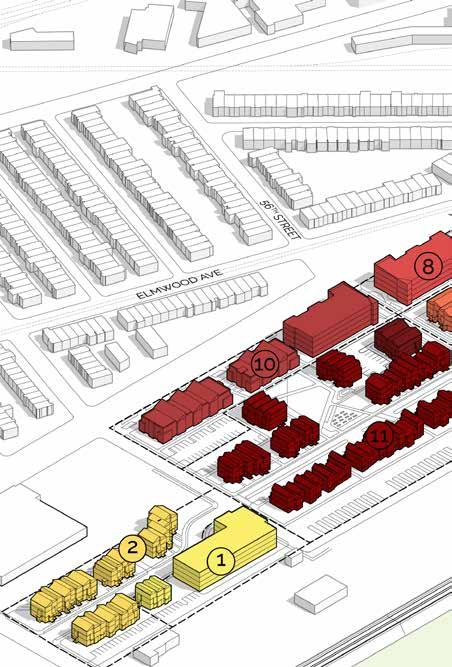
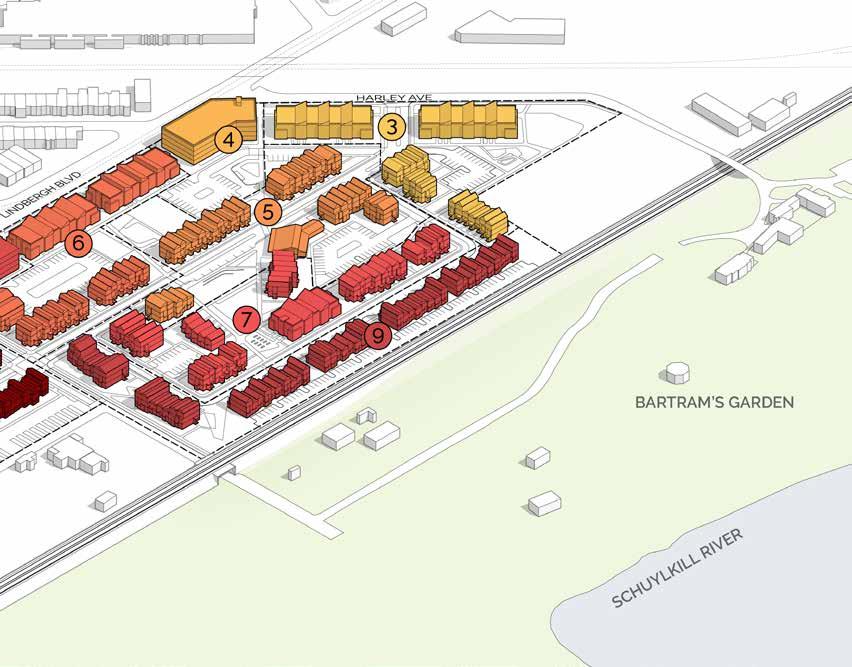
The first phase of development will take place on the “offsite” parcel south of 57th Street. This family phase consists of one multi-family building with 49 units, 6 stacked townhouse units, and one townhouse.

The total number of units in this phase is 56. All of these will be replacement units.
Phase 10
Unit Type Total
Multi-Family 27 Stacked Townhome 0 Townhome 0 Senior 0 Walk-Up 42 37 54%
Total 69 Accessible Units
Unit Type Total
Multi-Family 0 Stacked Townhome 32 Townhome 8 Senior 0 Homeownership 30 Walk-Up 0 11 16%
Unit Type Total
Total 70 Accessible Units Total 56 Accessible Units
Multi-Family 49 Stacked Townhome 6 Townhome 1 Senior 0 Walk-Up 0 51 91%
Unit Type Total
Multi-Family 0 Stacked Townhome 38 Townhome 6 Senior 0 Walk-Up 0 14 32%
Total 44 Accessible Units
Unit Type
Multi-Family
The second phase of development will complete the “off-site” parcel with 44 additional units. This phase will comprise a mix of stacked (38) and individual townhouse (6) units, as well as a green space that opens up onto the green “boulevard” that will eventually run through the redeveloped Bartram Village site.

The total number of units in this phase is 44. Of these, 40 units (90%) are replacement units, and four (10%) are affordable workforce units.
Total 44 Accessible Units
Total Program 2 Unit Type Total Multi-Family 0 Stacked Townhome 38 Townhome 6 Senior 0 Walk-Up 0 14 32%
Phase 3 will be the first phase “on-site” at Bartram Village, commencing redevelopment of the existing site at the northern end. An important new entrance to Bartram Village will be located further down Harley Avenue where a new intersection will enhance safety.

This family phase consists of walk-up apartments and townhouse type buildings, in addition to development of the first segment of the tree-lined boulevard and reconstruction of Eastwick Terrace.
The total number of units in this phase is 80. Of these, 68 (80%) will be replacement units and 12 will be nonreplacement units. Eight of these units will be targeted to affordable workforce and 4 units will be market rate.
Unit Type Total
Total 80
Accessible Units
Multi-Family 0 Stacked Townhome 23 Townhome 9 Senior 0 Walk-Up 48 24 30%
Unit Type Total
Total 45
Accessible Units
Multi-Family 0 Stacked Townhome 0 Townhome 0 Senior 45 Walk-Up 0 45 100%
Unit Type Total
Multi-Family 0 Stacked Townhome 33 Townhome 14 Senior 0 Walk-Up 0
The second on-site phase is a single mixed-use senior building at one of the prominent corners of the site along Lindbergh Boulevard. Ground-floor programming along with an outdoor plaza will advance the plan’s health and educational goals. It was also create a dynamic sense of place and inviting entry point into the site.
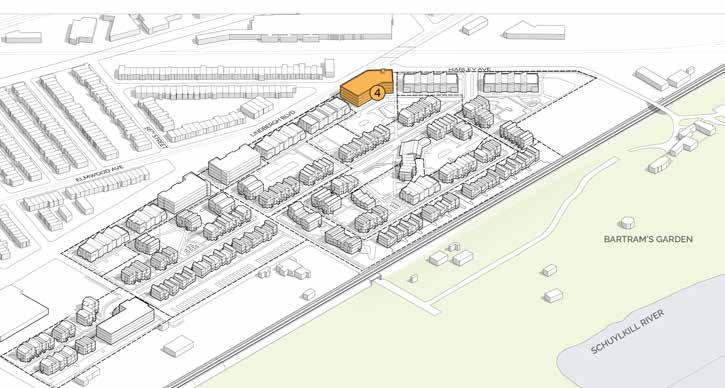
The total number of units in this phase is 45. All of these are senior housing units, and also considered replacement units.
Unit Type Total
Multi-Family 0 Stacked Townhome 23 Townhome 9 Senior 0 Walk-Up 48 24 30%
Total 80 Accessible Units
Unit Type Total
Multi-Family 0 Stacked Townhome 0 Townhome 0 Senior 45 Walk-Up 0 45 100%
Total 45 Accessible Units Total 47 Accessible Units
Unit Type Total
Multi-Family 0 Stacked Townhome 33 Townhome 14 Senior 0 Walk-Up 0 12 26%
Unit Type Total
Multi-Family 0 Stacked Townhome 18 Townhome 8 Senior 0 Walk-Up 48
Phase 5 will focus on the second segment of the internal tree-lined boulevard and family housing on both sides of this new infrastructure investment. A new community building is included in this phase.

The total number of units in this phase is 47. Of these, 38 will be replacement units and 9 will be non-replacement units. Seven of the non-replacement units will be affordable workforce units and two will be market-rate units.
Unit Type Total
Total 80
Accessible Units
Multi-Family 0 Stacked Townhome 23 Townhome 9 Senior 0 Walk-Up 48 24 30%
Unit Type Total
Multi-Family 0 Stacked Townhome 0 Townhome 0 Senior 45 Walk-Up 0 45 100%
Total 45
Accessible Units Total 47
Unit Type Total
Multi-Family 0 Stacked Townhome 33 Townhome 14 Senior 0 Walk-Up 0 12 26%
Accessible Units
Unit Type Total
Total 74
Accessible Units
Multi-Family 0 Stacked Townhome 18 Townhome 8 Senior 0 Walk-Up 48 28 38%
Unit Type Total
Multi-Family 0 Stacked Townhome 19 Townhome 15 Senior 0 Walk-Up 18
The sixth development phase includes two walk-up apartment buildings along Lindbergh Boulevard and another set of townhomes along the boulevard and 56th Street.
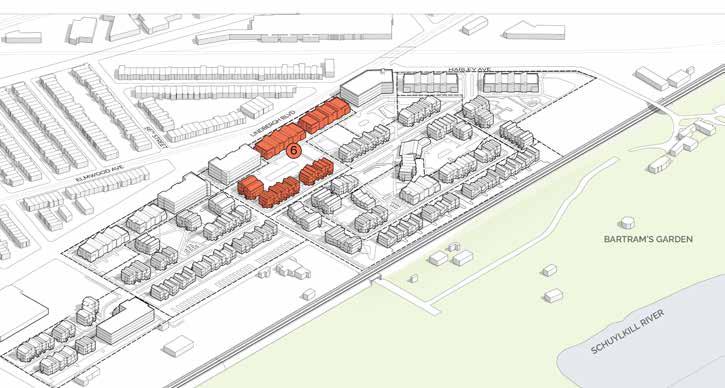
The total number of units in this phase is 74 Of these, 56 will be replacement units and 18 will be non-replacement units. Of the non-replacement units, 11 will be affordable workforce and seven will be market-rate units.
4
Unit Type Total
Multi-Family 0 Stacked Townhome 0 Townhome 0 Senior 45 Walk-Up 0 45 100%
Total 45
Accessible Units Total 47
Unit Type Total
Multi-Family 0 Stacked Townhome 33 Townhome 14 Senior 0 Walk-Up 0 12 26%
Accessible Units
6
Unit Type Total
Multi-Family 0 Stacked Townhome 18 Townhome 8 Senior 0 Walk-Up 48 28 38%
Total 74 Accessible Units Total 52 Accessible Units
Unit Type Total
Multi-Family 0 Stacked Townhome 19 Townhome 15 Senior 0 Walk-Up 18 7 13%
Phase 8
Unit Type Total
Multi-Family 0 Stacked Townhome 0 Townhome 0 Senior 45 Walk-Up 0
Phase 7 continues the reconstruction of Eastwick Terrace and develops family housing on one side of this road.
The total number of units in this phase is 52. Of these, 36 will be replacement units and 15 will be non-replacement units. The non-replacement units will comprise 10 affordable workforce and five market-rate units.
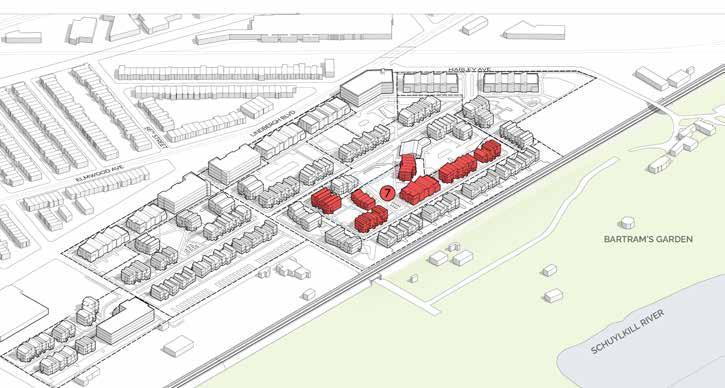
Unit Type Total
Multi-Family 0 Stacked Townhome 33 Townhome 14 Senior 0 Walk-Up 0 12 26%
Total 47 Accessible Units
Unit Type Total
Multi-Family 0 Stacked Townhome 18 Townhome 8 Senior 0 Walk-Up 48 28 38%
Total 74 Accessible Units Total 52 Accessible Units
Unit Type Total
Multi-Family 0 Stacked Townhome 19 Townhome 15 Senior 0 Walk-Up 18 7 13%
Unit Type Total
Total 45
Accessible Units
Multi-Family 0 Stacked Townhome 0 Townhome 0 Senior 45 Walk-Up 0 45 100%
Unit Type Total
Multi-Family 0 Stacked Townhome 28 Townhome 34 Senior 0 Walk-Up 0
The eighth phase includes a single mixed-use senior building at the corner of 56th and Lindbergh Boulevard that will form half of a new gateway into the Bartram Village site, as well as the Innovation Hub, Woodland Academy’s new NESTT, and planned investments at Bartram’s Garden.

The total number of units in this phase is 45. All of these are senior housing units, and also considered replacement units.
Unit Type Total
Multi-Family 0 Stacked Townhome 18 Townhome 8 Senior 0 Walk-Up 48 28 38%
Total 74
Accessible Units Total 52
Unit Type Total
Multi-Family 0 Stacked Townhome 19 Townhome 15 Senior 0 Walk-Up 18 7 13%
Accessible Units
Unit Type Total
Multi-Family 0 Stacked Townhome 0 Townhome 0 Senior 45 Walk-Up 0 45 100%
Total 45
Accessible Units Total 62
Unit Type Total
Multi-Family 0 Stacked Townhome 28 Townhome 34 Senior 0 Walk-Up 0 12 19%
Accessible Units
Phase 10
Unit Type Total
Multi-Family 27 Stacked Townhome 0 Townhome 0 Senior 0 Walk-Up 42
Phase 9 will develop a phase of family housing along Eastwick Terrace, wrapping along 56th Street. This phase will include a mix of stacked townhomes and townhome units.
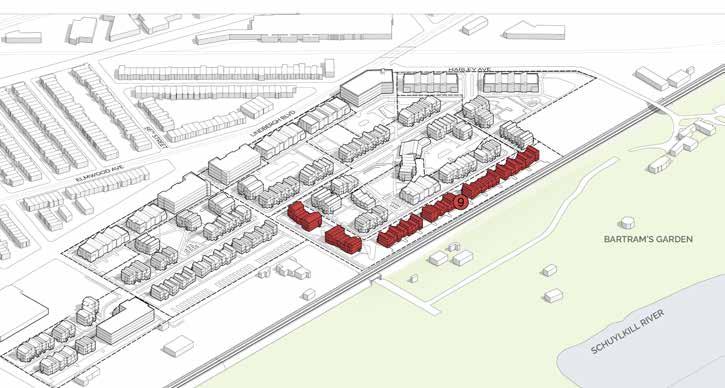
The total number of units in this phase is 62. Of these, 40 will be replacement units and 22 will be non-replacement units.
Unit Type Total
Multi-Family 0 Stacked Townhome 19 Townhome 15 Senior 0 Walk-Up 18 7 13%
Total 52 Accessible Units
Unit Type Total
Multi-Family 0 Stacked Townhome 0 Townhome 0 Senior 45 Walk-Up 0 45 100%
Total 45 Accessible Units Total 62 Accessible Units
Unit Type Total
Multi-Family 0 Stacked Townhome 28 Townhome 34 Senior 0 Walk-Up 0 12 19%
Unit Type Total
Multi-Family 27 Stacked Townhome 0 Townhome 0 Senior 0 Walk-Up 42 37 54%
Total 69 Accessible Units
Unit Type Total
Multi-Family 0 Stacked Townhome 32 Townhome 8 Senior 0 Homeownership 30 Walk-Up
Phase 10 will begin to redevelop Bartram Village south of 56th Street along Lindbergh Boulevard. This phase will complete the 56th Street gateway with a multi-family building framing the entrance to 56th Street leading toward the waterfront. Two walk-up apartment buildings will also line Lindbergh Boulevard.
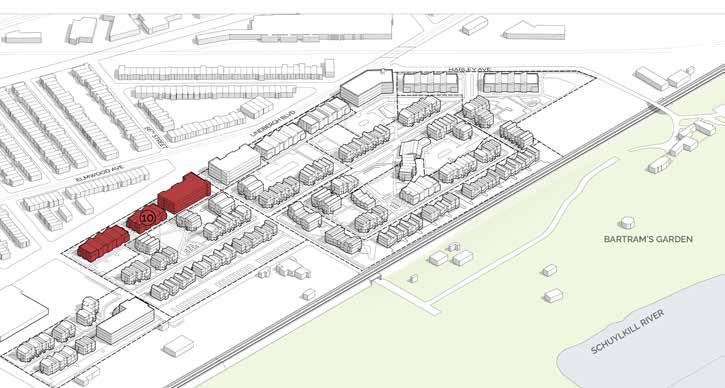
The total number of units in this phase is 69. Of these, 41 will be replacement units and 28 will be non-replacement units.
8
Unit Type Total
Multi-Family 0 Stacked Townhome 0 Townhome 0 Senior 45 Walk-Up 0 45 100%
Total 45
Accessible Units Total 62
Unit Type Total
Multi-Family 0 Stacked Townhome 28 Townhome 34 Senior 0 Walk-Up 0 12 19%
Accessible Units
Phase 10 Unit Type Total
Multi-Family 27 Stacked Townhome 0 Townhome 0 Senior 0 Walk-Up 42 37 54%
Total 69 Accessible Units
Phase 10 Unit Type Total
Total 70
Accessible Units
Multi-Family 0 Stacked Townhome 32 Townhome 8 Senior 0 Homeownership 30 Walk-Up 0 11 16%
Phase 1
Unit Type Total
Multi-Family 49 Stacked Townhome 6 Townhome 1 Senior 0
Unit Type Total
Multi-Family 0
The final phase of development will complete the block between 56th and 57th streets. This phase will comprise a mix of stacked townhomes and townhome units centered around a shared green space.
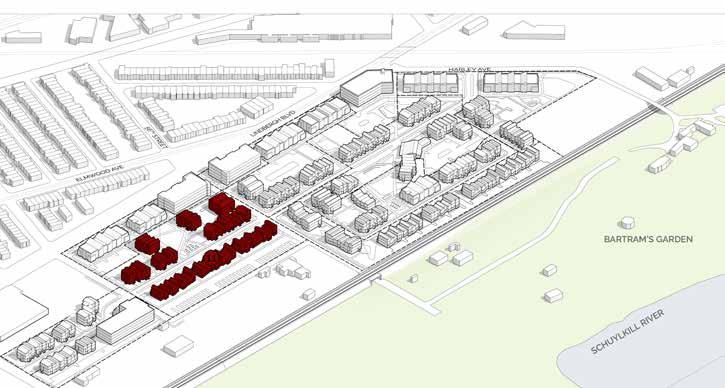
The total number of units in this phase is 70. Of these, 36 will be replacement units and 34 will be non-replacement units. Thirty of the non-replacement units will provide affordable homeownership opportunities.
Total 62
Accessible Units
Stacked Townhome 28 Townhome 34 Senior 0 Walk-Up 0 12 19%
Unit Type Total
Multi-Family 27 Stacked Townhome 0 Townhome 0 Senior 0 Walk-Up 42 37 54%
Total 69 Accessible Units
Unit Type Total
Total 70
Accessible Units
Multi-Family 0 Stacked Townhome 32 Townhome 8 Senior 0 Homeownership 30 Walk-Up 0 11 16%
Phase 1
Unit Type Total
Multi-Family 49 Stacked Townhome 6 Townhome 1 Senior 0 Walk-Up 0 51 91%
Total 56 Accessible Units
Total Program 2
Unit Type Total
Multi-Family 0 Stacked Townhome 38 Townhome 6 Senior
The planning process builds excitement but the time between completing a plan and seeing it realized can seem endless. Rather than wait to get started, the planning team launched a few activities during the planning process to build momentum for the transformation plan . Listed below are “Early Action Activities” already underway that address some of the needs identified by the community during the planning process.
▶ PHA launched a demonstration program that transforms vacant PHA properties into affordable homeownership opportunities for low- to moderateincome neighborhood residents in partnership with Southwest CDC, ACANA, and Southwest Philadelphia District Services.
▶ In partnership with Philabundance, a monthly delivery of fresh fruits and vegetables was established at Bartram Village to help address food security.
▶ PHS cleaned and greened 60 vacant lots along priority streets and highly visible locations.
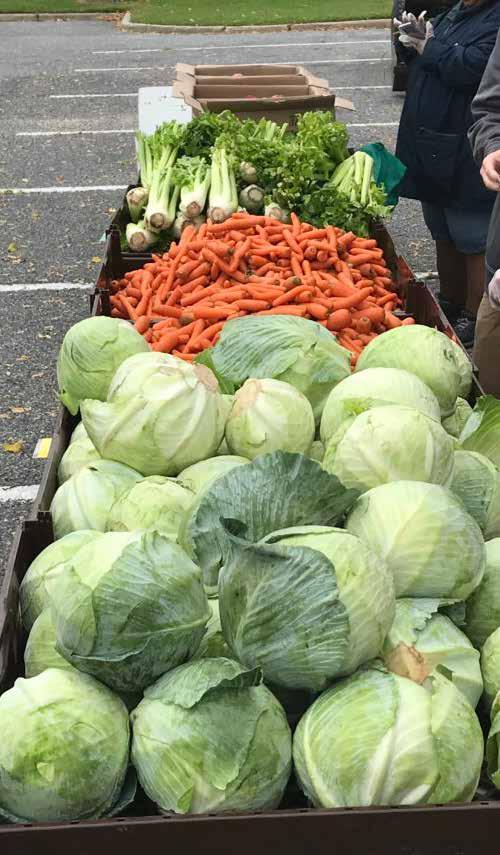
In addition to funding for planning activities, PHA received funds from HUD to support Action Activities. These are physical improvement, community development, and economic development projects that respond to needs identified during the planning process. These activities are designed to be implemented immediately following the completion of the plan to jumpstart transformation of the neighborhood.
An Action Activity Committee was set up in summer 2019. Members are listed below:
▶ Sheila Anthony—President, Bartram Village Resident Council
▶ Tonya Robinson—Vice President, Bartram Village Resident Council
▶ Adriane Parks—Neighborhood Resident/Co-Chair Neighborhood Task Force
▶ Nicholas Dema—PHA, Executive Vice President, Planning & Development
▶ Tom Dalfo—SVP, Philadelphia Industrial Development Corporation (PIDC)/Neighborhood Task Force Chair
▶ Ryan Bailey—Pennrose Properties
▶ Valerie Gay—Empowered CDC
▶
Maitreyi Roy—Bartram’s Garden
▶
▶
Office of Councilmember Blackwell
Office of Councilmember Johnson
▶ Office of Councilmember Gauthier
The Committee developed criteria to evaluate potential activities. Ideas for the activities were submitted to the committee by the individual Neighborhood, Housing and People Task Forces.
Alignment with choice plan priorities 20
Benefit to bartram village residents 20
Impact on neighborhood residents 15
Potential to leverage additional funds 20 Readiness to proceed / capacity of org. to execute 10
Ongoing mangement plan 5
Ability to build community capacity/ cohesion 10 Total 100
Each member of the Committee ranked the final list of potential activities and then as a group discussed their evaulations, which led to a priority list of projects. The top three projects selected to submit to HUD for final review and approval are the following:
56th Street Gateway: 56th Street at Lindbergh Boulevard and Elmwood Avenue is a very visible site in Southwest Philadelphia and the Choice neighborhood just across the street from Bartram Village. The location will become even more prominent when Bartram Village is redeveloped, the Innovation Hub is established along the riverfront by PIDC, and when Woodland Academy’s new facility, the “Nest,” is built along 56th Street across from Sankofa Farm at Bartram’s Garden. In addition, completion of the swing bridge spanning the Schuylkill River next year will connect Bartram’s Mile to the Schuylkill River Trail and Center City directing even more activity to 56th Street.
The plan for the redesigned Bartram Village site envisions mixed-use buildings with attractive plaza space framing the 56th Street entrance to the river trail, Innovation Hub, and Woodland Academy.
Currently, there is a vacant parcel owned by Empowered CDC at 56th and Lindbergh that offers a tremendous opportunity to create a welcoming gateway to the neighborhood, that could celebrate the area’s history, culture and community/residents, while creating an inviting green respite that could provide a setting for public programs.
The activity aims to include some sort of pavilion, a community art project, and green space that could tie into the pollinator corridor envisioned along Lindbergh Boulevard.
Pedestrian Safety Improvements along Lindbergh Boulevard and Grays Avenue: Pedestrian safety along Lindbergh Boulevard and Grays Avenue is a top priority for residents of Bartram Village and the immediate neighborhood as discussed at nearly every meeting during the planning process and through the resident surveys. Lindbergh Boulevard, Woodland Avenue and all of the major east-west cross streets in the Choice neighborhood fall under the City of Philadelphia’s Vision Zero’s High Injury Network.
This proposed Action Activity envisions improvements to Lindbergh Boulevard and Grays Avenue [49th to 56th] to improve safety, functionality and appearance. Action Activity funds would be used to enhance crossings with temporary to permanent interventions such as painted crosswalks and signage.
Southwest Homeowner Improvement Program: To help current neighborhood residents perform necessary improvements to their homes, the proposed Homeowner Improvement Program would employ local contractors and teach youth and young adults living in the Choice neighborhood construction and home repair skills. The funds will be used for façade improvements, solarization and tree plantings.
This program would be organized and administered by Bartram’s Garden. Choice funds could be used for exterior upgrades without triggering affordability restrictions.
Outlined below is the timeline, metrics and responsible parties for each of the plan’s goals, strategies, and Action Activities. It will be used to measure progress.
Short-Term (SL): 0-3 years
Mid-Term (MT): 3-5 years Long-Term (LT): 5+ years
Goal 1: Develop a clean and green network of streets along primary circulation routes that connect major services, amenities, and green spaces to Bartram Village and the waterfront.
A. Add trees, greenery, and green stormwater infrastructure to priority streets.
Coord. w/Urban Forest Strategic Plan; # additional street trees planted; # of sponsors/tree tenders; # additional greened acres as measured by PWD
Lead Agency & Partners Timeframe (ST, MT, LT) Funding
PHA, Parks & Rec, PWD Green City Clean Waters program
ST (Plan) LT (Impl)
Philadelphia Parks & Rec’s TreePhilly program, PWD Green City Clean Waters, PA Department of Conservation & Natural Resources
B. Work with the Clean PHL litter program to provide additional trash cans and organize regular neighborhood clean-ups of priority streets.
Increase # of trash & recycling cans installed in neighborhood by 20 in 5 years; 2 neighborhood cleanups/year
ACANA (cans), SWCDC, SWDS, Council Offices, Block Captains (clean up days)
ST
City Cap. & operating Funds, Clean PHL, Foundations, Neighborhood Sweat Equity
C. Clean and green highly visible vacant lots along priority streets.
Clean/maintain 30 vacant lots in 5 years and continue to maintain another 60 lots previously stabilized
PHS ST DHCD
Goal 2: Foster a safe neighborhood day and night for residents of all ages.
A. Upgrade and add additional lighting within redeveloped Bartram Village and on Lindbergh and Grays avenues from 49th Street to 58th Street.
B. Add security cameras and signage indicating their presence within Bartram Village, especially where kids get off school bus and interior of site
C. Incorporate “design for safety” principles into the redevelopment of Bartram Village and future development along Lindbergh Boulevard and Grays Avenue
D. Increase support systems for returning citizens to assist in their transition back into the community and prevent recidivism.
E. Promote technology as a tool for crime prevention.
# of new exterior lighting fixtures installed
PHA, Pennrose, PIDC
LT PHA, Pennrose, PIDC
installation of security cameras on-site PHA, Pennrose LT Redevelopment Capital
in conjunction with phased redevelopment of Bartram Village
Conversion of vacant office facility into reentry resource center.
PHA, Pennrose LT Redevelopment Capital
PHA, Community Forgiveness + Restoration Initiative
MT
F. Launch a Public Safety Pilot Program at Bartram Village.
# of businesses participating in Business Security Camera Prog.
DHCD, Commerce Dept., Police Dept.
ST Commerce Department
Establishment of program PHA ST PHA
Goal 3: Create a healthy outdoor environment that promotes physical exercise, social experiences, and wellness.
Strategies Metrics Lead Agency & Partners Timeframe (ST, MT, LT) Funding
A. Integrate a variety of “play” spaces for all ages on Bartram Village site.
B. Expand bicycle infrastructure and amenities both at and near Bartram Village, including bike parking and storage, trail connections, and a bikeshare station.
C. Create safe, well-lit walking loops of different lengths throughout Bartram Village and connecting to Bartram’s Garden and the Schuylkill River Trail with mileage signage
in conjunction with phased redevelopment of Bartram Village
PHA, Pennrose LT Redevelopment Capital
in conjunction with phased redevelopment of Bartram Village
in conjunction with phased redevelopment of Bartram Village
PHA, Pennrose LT Redevelopment Capital
PHA, Pennrose LT Redevelopment Capital
Goal 4: Enhance the existing transportation network through safe street crossings, trail connections, and increased walkability.
Strategies Metrics Lead Agency & Partners Timeframe (ST, MT, LT) Funding
A. Improve sidewalk conditions on priority streets LF of sidewalk improvements
PHA, Pennrose, SWCDC, ACANA
B. Add traffic calming elements and pedestrian crossings along Lindbergh Blvd and Grays Ave from 49th to 58th streets
C. Enhance the safety and comfort of the trolley stops at 54th and Lindbergh, and 56th and Elmwood
D. Improve and restore bike lanes on Grays & Lindbergh avenues (49th to 58th) and improve the 58th Street Greenway
in conjunction with 56th St gateway project and Lindbergh/Grays Ave improvements
in conjunction with SEPTA trolley modernization
in conjunction with Lindbergh Blvd/Grays Ave improvements
PHA, PIDC, Empowered CDC
LT Redevelopment Capital
ST, MT HUD, PHA
SEPTA, Streets Dept. LT SEPTA
OTIS MT PennDOT
Short-Term (SL): 0-3 years
Mid-Term (MT): 3-5 years
Long-Term (LT): 5+ years
Goal 1: Promote healthy, affordable housing and homeownership opportunities throughout the Bartram Choice neighborhood.
Strategies Metrics Lead Agency & Partners Timeframe (ST, MT, LT) Funding
A. Launch a demonstration program to transform vacant PHA properties into affordable homeownership opportunities for low- to moderate-income neighborhood residents
B. Promote the Healthy Rowhouse Project and DHCD’s Basic Systems Repair Program with bi-annual housing repair blitz and workshop for neighborhood residents, targeting priority streets
C. Identify vacant buildings along priority streets to be stabilized through Philadelphia’s Doors and Windows Ordinance
Transform 6 vacant properties PHA, SWCDC, ACANA, SWDS ST PHFA, City, Redevelopment Capital
2 repair blitzes/year; # of owner-occupied home investments in n’hood
Stabilize 25% of currently vacant buildings (106) in 5 yrs
PHA, DHCD ST HUD, DHCD
DHCD MT City General Fund
Goal 2: Provide attractive, affordable housing and a healthy built environment at Bartram Village.
A. Blend a variety of mixedincome housing types at Bartram Village to meet the needs of residents.
B. Use green building and landscape design practices to support the health and well-being of residents and the site
# of non-replacement housing units PHA, Pennrose LT Redevelopment Capital
acres of new open space on and around Bartram Village
C. Integrate green infrastructure to manage stormwater, protect water and air quality, and celebrate nature
# of green infrastructure BMPs
PHA, Pennrose LT Redevelopment Capital
PHA, Pennrose LT Redevelopment Capital
A. Designate area in Bartram Village to host regular health events and provide on-site vision, dental, and hearing screenings and hold annual screenings
B. Coordinate quarterly on-site information sessions and forums with health partners to address specialized resident concerns including anxiety, domestic violence, and substance abuse.
C. With CHOP’s Community Asthma Prevention Program (CAPP), hold bi-monthly workshops and info sessions to increase awareness of air pollution and asthma prevention.
Increase % of BV residents with health insurance to 95%; Hold annual health fair; SF of new health screening space at BV
PHA, Pennrose, Aetna Better Health Network
ST; MT; LT PHA Redev. Capital
Hold info sessions 4x/ year PHA Resident Services ST PHA
Hold workshops 6x/ year CHOP ST CHOP
A. Encourage residents to attend on-site programming that promotes positive mental health and healing from trauma including group sessions, mediation and yoga sessions, and individual counseling.
B. Integrate comfortable, green, and inviting outdoor spaces that invite meditation and foster healing.
C. Maximize daylight and views of nature, and promote physical activity through the design of the buildings and site at Bartram Village.
Hold program 1/x month at Bartram Village
PHA Resident Services, EMIR Healing Center
MT, LT) Funding
ST PHA
acreage of outdoor healing spaces in conjunction with phased redevelopment of Bartram Village
in conjunction with phased redevelopment of Bartram Village
PHA, Pennrose LT Redev. Capital
PHA, Pennrose LT Redev. Capital
Goal
Enhance the physical health of residents by expanding access to a wider range of quality health services.
Short-Term (SL): 0-3 years
Mid-Term (MT): 3-5 years
Long-Term (LT): 5+ years
Goal 5: Improve access to nutritious, affordable food.
A. Establish a monthly delivery of fresh fruit and veggies on-site at Bartram Village.
B. Explore locating a community kitchen on or near Bartram Village with cooking and nutrition classes as well as space for culinary entrepreneurs.
Delivery 12/year; increase in number of residents served; Winter Foods and Heart Smart programs participation
Creation of community kitchen; support of 6 residents; nutrition programming
C. Create a community garden space at Bartram Village. acreage of community garden at BV in conjunction with phased redevelopment
D. Promote Summer Foods Program at Bartram Village for children ages 3-18 to have breakfast and lunch from June to August to residents and local community members.
Increase participation by 11% in 5 years
Philabundance, Parks & Rec, The Food Trust
ST Philanthropy
PHA, Pennrose MT Pennrose?
E: Coordinate with corner stores to increase fresh food offerings 3 new corner stores participating in Health Corner Store Initiative
F: Expand pilot program to Bartram Village in partnership with Lyft to transport residents to local grocery store at reduced cost.
# of reduced cost Lyft trips
PHA, Pennrose LT Redev. Capital
PHA Resident Services ST PHA
PHA, The Food Trust MT PA Fresh Food Financing Init.
PHA MT PHA, Lyft
Short-Term (SL): 0-3 years
Mid-Term (MT): 3-5 years
Long-Term (LT): 5+ years
Goal 1: Develop a pathway to success beginning in early childhood.
Strategies Metrics Lead Agency & Partners Timeframe (ST, MT, LT) Funding
A. Expand Parent/Child+ Home Program to Bartram Village to support parents and infants/ toddlers.
B. Establish direct resource to childcare centers in area that provides quality childcare and slot availability through partnership with PHLPreK.
C. Enhance after school programming at Bartram Village to include the arts, reading, science, and music with partner agencies.
D. Establish pre-apprenticeship opportunities and internships to expose students to careers, skills advancement and graduation.
Goal
Expand current participation by 26% over 5 years (15 families)
Enroll 60% BV families with children under 5 in Head Start or early childhood ed program in 5 years
Introduce new STEM or art program; enroll 20% BV youth aged 6-15 in 5 years
Connect 20% BV youth aged 14-21 in internship or pre-apprenticeship in next 5 years
PHA Resident Services MT
PHA Resident Services MT PHL PreK
PHA Resident Services LT PHA
WorkReady, Careerlink, Year Up
MT
Strategies Metrics Lead Agency & Partners Timeframe (ST, MT, LT) Funding
A. Establish a Philly Reading Coaches initiative at Bartram Village to provide volunteers to boost reading skills of children at Bartram Village.
B. Utilize PHA Workforce Navigators from the Workforce Center to guide residents to literacy, GED and Adult Basic Education Classes.
C. Design a reading nook in the Community Building with a lending library and encourage a variety of book clubs–senior, kids, multi-generational.
Enroll 10 students/year in program
Hold orient. session 1x/ month on-site
PHA Resident Services, Philly Reading Coaches
ST Philanthropy
PHA Resident Services ST PHA
in conjunction with phased redevelopment of redevelopment of Bartram Village
PHA, Pennrose LT Redevelopment Capital
2: Nurture a culture of literacy at Bartram Village.
Goal 3: Cultivate a local employment training ecosystem that aligns with neighborhood needs and opportunities.
Strategies Metrics Lead Agency & Partners Timeframe (ST, MT, LT) Funding
A. Collaborate with providers and local employers to create training programs for green jobs, child development, and construction.
Enroll 15% of residents aged 18-30 in 5 years in training programs
PHA Resident Services, Congresso, District 1199c
MT Philanthropy
B. Enhance partnership with PowerCorps to enroll residents from all housing sites including Bartram Village. Programming includes re-entry services.
Goal 4: Bridge the basic skills divide.
PHA Resident Services, PHL PowerCorps
MT PHA, PHL PowerCorps
Strategies Metrics Lead Agency & Partners Timeframe (ST, MT, LT) Funding
A. Utilize PHA Workforce Navigators to connect residents to financial literacy, job readiness workshops, and homeownership workshops. Host monthly workshops on-site at Bartram Village to share program information, recruitment events, and market services.
B. In partnership with Urban League, host digital literacy events at Bartram Village.
C. Create a Computer Lab Monitor training program to upskill Computer Lab Monitors at all PHA sites including Bartram Village to assist residents with computer literacy and job search needs in on-site computer labs.
Hold orientation session 1x/month onsite
PHA Resident Services MT PHA
Enroll 25% of senior BV residents in programs over 5 years
Set up training program for lab monitors
PHA Resident Services, Urban League
PHA Resident Services, VISTA
MT PHA, Urban League
MT PHA
Goal 5: Strengthen the identity and vibrancy of the neighborhood.
A. Create a neighborhood gateway at 56th & Lindbergh Blvd with signage, public art, and enhanced pedestrian crossings.
in conjunction with 56th St Gateway project and improvements
PHA, PIDC, Empowered CDC
ST, MT HUD, PHA
B. Highlight the rich history and culture of Southwest Philadelphia through public art, placemaking, and wayfinding signage, where appropriate.
C. Improve cleanliness and aesthetics of Woodland Avenue and Chester Avenue commercial corridors.
D. Raise awareness among business owners of existing storefront improvement and business assistance programs.
neighborhood signage, murals, placemaking, public art
Increased number of corridor cleanings
Increased participation in SIP and business assistance programs.
Philadelphia Mural Arts MT PHA, PIDC
ACANA MT Philadelphia Dept of Commerce
ACANA, PIDC MT Philadelphia Dept of Commerce